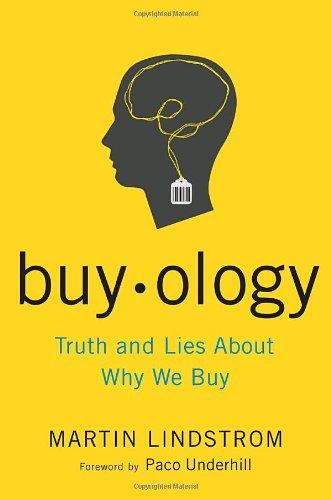
Buyology
by
Martin Lindstrom
Published 14 Jul 2008
But simply by observing the student bringing the ice cream cone to his mouth, the monkey’s brain had mentally imitated the very same gesture. This amazing phenomenon was what Rizzolatti would eventually dub “mirror neurons” at work—neurons that fire when an action is being performed and when that same action is being observed. “It took us several years to believe what we were seeing,” he later said. But the monkeys’ mirror neurons didn’t fire up at the sight of just any gesture either a grad student or another monkey made. Rizzolatti’s team was able to demonstrate that the macaques’ mirror neurons were responding to what are known as “targeted gestures”—meaning those activities that involve an object, such as picking up a nut, or bringing an ice cream cone to your mouth, as opposed to random movement, such as crossing the room or simply standing there with your arms crossed.
…
However, fMRI and EEG scans of the regions of the human brain thought to contain mirror neurons, the inferior frontal cortex and superior parietal lobule, point to yes, as these regions are activated both when someone is performing an action, as well as when the person observes another person performing an action. The evidence supporting the existence of mirror neurons in the human brain is so compelling, in fact, that one eminent professor of psychology and neuroscience at the University of California has said, “What DNA is for biology, the Mirror Neuron is for psychology.”2 Have you ever wondered why, when you’re watching a baseball game and your favorite player strikes out in the top of the ninth inning, you cringe—or alternately, why, when your home team scores a goal or a touchdown, you pump your arm in the air?
…
If you saw me tripping and falling headfirst down a flight of stairs, your mirror neurons would fire up, and you would know precisely how I feel (even though you’re not half as clumsy as I am). Thus mirror neurons not only help us imitate other people, they’re responsible for human empathy. They send signals to the limbic system, or emotional region, of our brains—the area that helps us tune in to one another’s feelings and responses—so we can experience what it’s like to walk—or in this case, trip and sprawl—in another person’s shoes. WHAT STEVE JOBS observed on that New York City day was a good example of mirror neurons in our everyday lives—and the role they play in why we buy.

Behave: The Biology of Humans at Our Best and Worst
by
Robert M. Sapolsky
Published 1 May 2017
This can range from understanding what behavior they are doing to understanding why they are doing it to grasping their larger motivations, all the way to peering into their souls with your mirror neurons. You can see why this has spawned debates. In this view mirror neurons aid Theory of Mind, mind reading, and perspective taking, suggesting that part of how we understand someone else’s world is by simulating (in our minds, in our PMC, in our mirror neurons) their actions.35 This orients a mirror neuron’s world in a very different way from the previous section, where mirroring is to improve your own motor performance and the most pertinent neuroanatomy about mirror neurons in the PMC is their talking to motor neurons that command muscles. In contrast, mirror neurons being concerned with understanding someone else’s actions should be talking to Theory of Mind–related brain regions, for which there is evidence.
…
Thus, while mirror neurons’ activity correlates with attempts to understand other people’s actions, their involvement seems neither necessary nor sufficient and is most pertinent to low-level, concrete aspects of such understanding. As for mirror neurons being the portal for peering into someone’s soul and attaining super-duper understanding from within, I think things are best summarized by the title of Hickok’s well-received 2014 book The Myth of Mirror Neurons.39 Which leads to the Wild West of mirror neuron–ology, with speculations that mirror neurons are essential to language, aesthetics, consciousness.40 Most of all, within two seconds of people first hearing about mirror neurons, they started writing reviews where the last paragraph would say something like “Wow, mirror neurons! How cool is that? This opens up all sorts of interesting avenues.
…
Gallese, “The ‘Shared Manifold’ Hypothesis: From Mirror Neurons to Empathy,” J Consciousness Studies 8 (2001): 33. 42. J. Kaplan and M. Iacoboni, “Getting a Grip on Other Minds: Mirror Neurons, Intention Understanding, and Cognitive Empathy,” Soc Nsci 1 (2006): 175. 43. Center for Building a Culture of Empathy, “Mirror Neurons,” http://cultureofempathy.com/, no date, http://cultureofempathy.com/References/Mirror-Neurons.htm; J. Marsh, “Do Mirror Neurons Give Us Empathy?” Greater Good Newsletter, March 29, 2012; V. Ramachandran, “Mirror Neurons and Imitation Learning as the Driving Force Behind ‘the Great Leap Forward’ in Human Evolution,” Edge, May 31, 2000. 44.
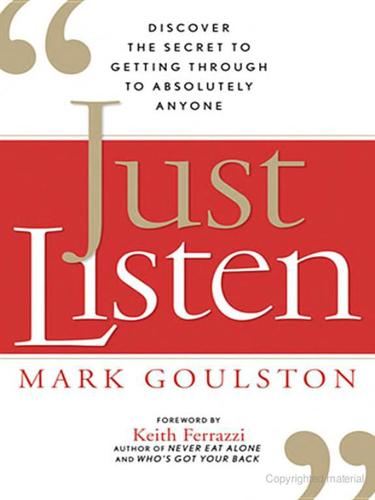
Just Listen: Discover the Secret to Getting Through to Absolutely Anyone
by
Mark Goulston M. D.
and
Keith Ferrazzi
Published 31 Aug 2009
Later they changed the name to mirror neurons, because these cells allow monkeys to mirror another being’s actions in their own minds. The new name is more accurate, because we’re finding that humans, just like macaques, have neurons that act as mirrors. In fact, studies suggest that these remarkable cells may form the basis for human empathy. That’s because, in effect, they transport us into another person’s mind, briefly making us feel what the person is feeling. In a 2007 article titled “The Neurology of Self-Awareness” in Edge, V. S. Ramachandran, a pioneer in mirror neuron research, commented, “I call these ‘empathy neurons,’ or ‘Dalai Lama neurons,’ for they are dissolving the barrier between self and others.”
…
In short, these cells may prove to be one way nature causes us to care about other people. But look at mirror neurons from another angle, and new questions emerge. Why is it that we often tear up when someone is kind to us? Why is it that we get a warm feeling when someone understands us? Why is it that a simple caring “Are you okay?” can so move us? My theory, which my clinical findings support, is that we constantly mirror the world, conforming to its needs, trying to win its love and approval. And each time we mirror the world, it creates a little reciprocal hunger to be mirrored back. If that hunger isn’t filled, we develop what I refer to as “mirror neuron receptor deficit.”
…
Doing the opposite—pretending you’re fine when your world is imploding—can be dangerous or even deadly. But “assertive vulnerability” isn’t just about blowing off steam; it’s also about reaching people. To see why, let’s get back to mirror neurons—the brain cells I talked about in Chapter 2, which allow us to feel what another person is feeling. When you’re scared or hurting or humiliated, but you’re still in cover-up mode because you’re afraid of losing another person’s respect, here’s what happens:■ Your own mirror neuron receptor deficit widens. You don’t feel understood because you can’t be understood. That’s because nobody has a clue what’s going on with you. You’re on your own, and it’s a self-inflicted wound
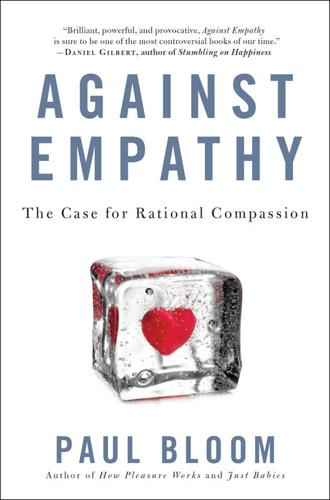
Against Empathy: The Case for Rational Compassion
by
Paul Bloom
In his book The Myth of Mirror Neurons, Gregory Hickok notes that if you google “mirror neurons” you will learn about gay mirror neurons, how the president is using mirror neurons to peek into your brain, why God created mirror neurons to make us better people, and much else. His survey of scientific journal articles finds that mirror neurons are said to be implicated in (just to take a selection) stuttering, schizophrenia, hypnosis, cigarette smoking, obesity, love, business leadership, music appreciation, political attitudes, and drug abuse. As you might be able to tell from the title of his book, Hickok is critical of the claims that have been made about mirror neurons, and many scholars would agree that they have been overhyped.
…
Certain neurons, then, didn’t appear to distinguish between an action-the-monkey-does and an action-the-monkey-perceives-someone-else-doing. Fittingly, these became known as “mirror neurons.” One modest theory of the function of these mirror neurons is that they help solve the problem of how monkeys figure out how to manipulate objects. That is, given their mirroring properties, these neurons could help the monkey calibrate his or her own grip based on observing what others do. But for Rizzolatti and his colleagues, this was just the beginning. They, and soon many others, began to explore mirror neurons as a theory of how we can understand the mental states of other individuals, and soon proposed them as part of a theory of empathy.
…
After all, a neural system that doesn’t make the distinction between self and other seems tailor-made for explaining how we can share the experiences of others. Mirror neurons have a lot of fans. One prominent neuroscientist said that they will do for psychology what DNA did for biology—another described them as “tiny miracles that get us through the day.” Godwin’s Law says that as any online discussion proceeds, the odds of someone mentioning Hitler approaches certainty. In my experience, there is an equivalent for mirror neurons. In any discussion of some psychological capacity (including empathy), you don’t have to wait long until someone reminds the group that we already have a perfectly good theory—it’s all done by mirror neurons. In his book The Myth of Mirror Neurons, Gregory Hickok notes that if you google “mirror neurons” you will learn about gay mirror neurons, how the president is using mirror neurons to peek into your brain, why God created mirror neurons to make us better people, and much else.

Cognitive Gadgets: The Cultural Evolution of Thinking
by
Cecilia Heyes
Published 15 Apr 2018
The Parma group assumes that mirror neurons are genetically inherited and argues that their adaptive function relates to “action understanding” rather than imitation (Rizzolatti and Craighero, 2004). However, other researchers have been quick to assume that mirror neurons provide the neurological basis for imitation, and to interpret Meltzoff and Moore’s evidence of neonatal imitation as a sign that mirror neurons are present at birth (Lepage and Theoret, 2007). There is now a good deal of evidence that mirror neurons are involved in imitation. For example, meta-analyses of imaging data have shown that mirror neuron areas of the brain are typically active when people are imitating (Caspers, Zilles, Laird, and Eickhoff, 2010), and disruption of these areas using transcranial magnetic stimulation selectively disrupts imitative behavior (Catmur, Walsh, and Heyes, 2009; Mengotti, Ticini, Waszak, Schutz-Bosbach, and Rumiati, 2013).
…
For example, meta-analyses of imaging data have shown that mirror neuron areas of the brain are typically active when people are imitating (Caspers, Zilles, Laird, and Eickhoff, 2010), and disruption of these areas using transcranial magnetic stimulation selectively disrupts imitative behavior (Catmur, Walsh, and Heyes, 2009; Mengotti, Ticini, Waszak, Schutz-Bosbach, and Rumiati, 2013). Given this involvement, it is tempting to regard mirror neurons as a solution to the correspondence problem and, therefore, as an explanation of imitation. But this would be a mistake. “Involvement” is not explanation. Unless we know how mirror neurons solve the correspondence problem, they are just another black box. The question “How do people imitate?” becomes the question “How do mirror neurons imitate?” The target shifts but the challenges remain the same: to identify the source of the information that allows people and / or mirror neurons to relate the “seen but unfelt” to the “felt but unseen,” and to explain how this information is handled such that people and / or mirror neurons produce behavior similar to that of the model.
…
In cognitive neuroscience, not long before Meltzoff and Moore (1997) published their fullest exposition of the active intermodal matching model, Giacoma Rizzolatti and his group in Parma discovered neurons in the premotor cortex of monkeys with some very interesting properties (di Pellegrino, Fadiga, Fogassi, Gallese, and Rizzolatti, 1992). Now known as “mirror neurons” (Gallese, Fadiga, Fogassi, and Rizzolatti, 1996), each of these cells fires not only when a monkey executes a particular action (for example, pinching) but also when the monkey passively observes a similar action performed by another agent. Subsequent research, using single neuron recording and brain imaging, has confirmed that mirror neurons are also present in the premotor and parietal cortices of adult human brains (Molenberghs, Cunnington, and Mattingley, 2012). The Parma group assumes that mirror neurons are genetically inherited and argues that their adaptive function relates to “action understanding” rather than imitation (Rizzolatti and Craighero, 2004).

The Empathic Civilization: The Race to Global Consciousness in a World in Crisis
by
Jeremy Rifkin
Published 31 Dec 2009
It would be several more years before the Italian team finally understood the significance of what they had discovered. WHAT MIRROR NEURONS TELL US ABOUT NATUREVERSUS NURTURE In 1996, Rizzolatti’s team published the results of their research, setting off a scientific tsunami in the academic community. They called their discovery “mirror neurons.” Since then, scientists have extended Rizzolatti’s findings, discovering mirror neurons in other primates as well. Mirror neurons allow humans—and other animals—to grasp the minds of others “as if ” their thoughts and behavior were their own. The popular-science press has begun to refer to mirror neurons as “empathy neurons.” What is most striking, says Rizzolatti, is that “[m]irror neurons allow us to grasp the minds of others not through conceptual reasoning but through direct simulation.
…
Marco Iacoboni, a neuroscientist at the University of California at Los Angeles and one of the leading researchers of mirror neurons, explains their importance in cueing into and reading other minds. [I]f you see me choke up, in emotional distress from striking out at home plate, mirror neurons in your brain simulate my distress. You automatically have empathy for me. You know how I feel because you literally feel what I am feeling.6 The point that Iacoboni and other scientists are making is that we are wired for empathy—it is our nature and what makes us social beings. The growing body of experimental research into the role mirror neurons play in empathic development is impressive and is already rewriting the script on the evolution of human development.
…
Even more complex social emotions like shame, embarrassment, guilt, and pride are attached to mirror neuron systems found in the insula of the brain. Dr. Christian Keysers, of the University of Groningen in the Netherlands, conducted a study in which people viewed a hand reaching out to caress someone and then saw another hand aggressively push it away. Interestingly, the insula in the observers fired the neurons that activate the feeling of rejection.10 In virtually all of the studies of mirror neuron activation, researchers find that participants who score high on empathic profile tests show more active and elevated mirror neuron responses. This distinction is important because it suggests that while children with normal brain activity are prewired for empathy, the extent to which their mirror neurons activate depends as much upon nurture as nature.
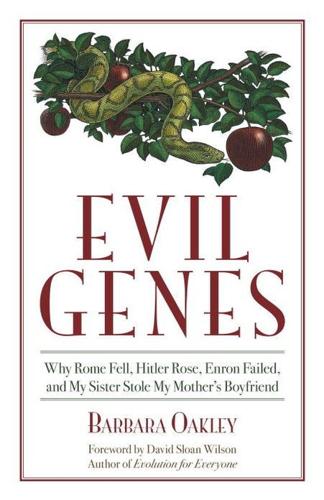
Evil Genes: Why Rome Fell, Hitler Rose, Enron Failed, and My Sister Stole My Mother's Boyfriend
by
Barbara Oakley Phd
Published 20 Oct 2008
And if you see me choke up, in emotional distress from striking out at home plate, mirror neurons in your brain simulate my distress. You automatically have empathy for me. You know how I feel because you literally feel what I am feeling.30 On the other hand, people with autism often display no firing in their mirror neurons in response to the activities of others. Researchers believe that the “broken” mirror neuron system of autistics lies at the heart of their difficulties with social interaction and lack of empathy, as well as their inability to imitate. The role of mirror neurons in the development of psychopathy is as yet unclear, since psychopaths seem to have no difficulty comprehending the mental state of others.
…
Psychopaths, it appears, may be born preprogrammed with a tendency to grow up “morally blind.” EMPATHY AND MIRROR NEURONS Empathy—identifying with and understanding another person—appears to be related to a distributed complex of neural units that are primed in part by mirror neurons. These neurons, believed by many to be the greatest neurological discovery of the 1990s, are triggered not only when humans perform an action but also when a person witnesses another person performing the same activity. Thus far, mirror neurons have been found in the premotor cortex and the inferior parietal cortex, and it is thought they may be located in additional areas of the human brain.
…
Thus far, mirror neurons have been found in the premotor cortex and the inferior parietal cortex, and it is thought they may be located in additional areas of the human brain. It may be that these types of neurons have evolved to allow animals to understand what another animal is doing or to recognize another's action. It appears, however, that human mirror neurons are far more flexible and highly evolved than neurons found in any other animal. Dr. Marco Iacoboni, a neuroscientist who specializes in researching mirror neurons, notes: When you see me perform an action—such as picking up a baseball—you automatically simulate the action in your own brain…. Circuits in your brain, which we do not yet entirely understand, inhibit you from moving while you simulate.

Be Different: Adventures of a Free-Range Aspergian With Practical Advice for Aspergians, Misfits, Families & Teachers
by
John Elder Robison
Published 22 Mar 2011
Turns out, everyone has brain cells called mirror neurons that “act out” what we see in other people. When we see someone smile or frown, our mirror neurons make a smile or frown in our own brain, and that puts a smile or frown on our face. Seeing it makes us do it and feel it. Scientists think that cycle is the foundation for empathy—the ability to put yourself in the other person’s shoes and understand how he feels, instinctually. It’s remarkable that we have brain cells that evolved specifically for that task, but it’s true. And the neurons don’t respond just to sight. Mirror neurons can act out feelings that come from sounds, smells, and who knows what else.
…
Mirror neurons can act out feelings that come from sounds, smells, and who knows what else. It’s incredibly complex, and it’s kind of neat. People with autism have mirror neurons just like nypicals, but in us it’s like the volume is turned down. A big smile on your face makes a tiny grin on mine. So I respond, but sometimes the response is so small and weak you can’t even see it. Most people with Asperger’s seem to react like me—weakly. Like with everything else, though, there’s a range. Some people are a bit better than I, while a few are a whole lot worse. What does having weak mirror neurons mean for Aspergians long term? I’ve thought about that question a whole lot. I think that it means it’s tough for us to develop a sense of other people’s realities, to understand that they have their own thoughts and emotions that are separate from ours.
…
And why did Brya feel okay at the end, while I ended up feeling so bad? I’ll lay that one at the feet of those mirror neurons. They seem to have operated very differently in the two of us. Brya mirrored Charley, saw a response, and made a happy face to cheer him up. Her happy face cheered her up, too, allowing her to recover from mirroring his worry over the accident. So in the space of an instant she mirrored his distress, countered it with a smile, and felt better herself. That’s a successful and powerful system. I wish I had access to it. My mirror neurons moved slower, and maybe deeper and stronger. I frowned as I acknowledged Charley’s sad story.

The Naked Presenter: Delivering Powerful Presentations With or Without Slides
by
Garr Reynolds
Published 29 Jan 2010
What we were experiencing that sunny afternoon in Copenhagen was a form of emotional contagion, which is the tendency to feel the emotions others are feeling and even mimic their facial expressions and moods. Mirror neurons In the last decade, based on earlier work at the University of Parma, Italy, researchers have gained good insights into something called mirror neurons. A mirror neuron is a neuron in the brain that fires both when you do something and when you simply see someone else doing the same behavior—even though you have not moved. It’s almost as if you, the observer, are actually engaging in the same behavior as the person you are watching.
…
Watching something and doing something are not the same, of course, but as far as our brains are concerned, they’re pretty darn close. We learn from watching others; we even learn bad habits from watching others. Mirror neurons fire when we see a behavior and also when we perform that behavior. So before we imitate a new behavior, our mirror neurons have already re-created that behavior in our brain. Our brains are good at imitating actions, but just as importantly, they are really good at feeling what others are feeling. Mirror neurons 110 The Naked Presenter Wow! eBook <WoweBook.Com> may be involved in empathy as well. This is a crucial survival skill. Research has shown that the same area of the brain that lights up when a person experiences an emotion also activates when that person only sees someone else experiencing that emotion.
…
Research has shown that the same area of the brain that lights up when a person experiences an emotion also activates when that person only sees someone else experiencing that emotion. When we see someone express passion, joy, concern, and so on, experts believe that the mirror neurons send messages to the limbic region of the brain, the area associated with emotion. In a sense, there is a place in the brain that seems to be responsible for living inside other people’s brains—that is, to feel what they are feeling. If our brains are activated by the movements and feelings of others, what does this suggest for the way we should present to a group of people?
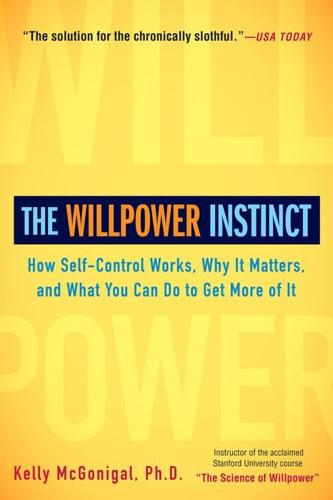
The Willpower Instinct: How Self-Control Works, Why It Matters, and What You Can Doto Get More of It
by
Kelly McGonigal
Published 1 Dec 2011
Humans are hardwired to connect with others, and our brains have adapted a nifty way to make sure we do. We have specialized brain cells—called mirror neurons—whose sole purpose is to keep track of what other people are thinking, feeling, and doing. These mirror neurons are sprinkled throughout the brain to help us understand the full range of other people’s experiences. For example, imagine that you and I are in the kitchen, and you see me reach my right hand for a knife. Your brain will automatically begin to encode this movement. The mirror neurons that correspond to movement and sensation in your right hand will be activated. In this way, your brain begins to craft an inner representation of what I’m doing.
…
After I bandage my thumb and serve myself a slice of cake, the mirror neurons in the reward system of your brain will be activated. Even if you don’t like carrot cake yourself, if you know that it’s my favorite (true), your brain will start anticipating a reward. When our mirror neurons encode the promise of reward in others, we long for a treat ourselves. MIRRORING WILLPOWER FAILURES In this simple scenario, we’ve seen three ways our social brains can catch willpower failures. The first is unintentional mimicry. The mirror neurons that detect another person’s movement prime that very same movement in your own body.
…
In this way, your brain begins to craft an inner representation of what I’m doing. The mirror neurons re-create the movement like a detective might reenact a crime scene, trying to understand what happened and why. This allows you to guess why I’m reaching for the knife, and what might happen next. Am I going to attack you? Or is my intended victim the carrot cake on the counter? Let’s say I accidentally slice my right thumb as I grab the knife. Ouch! As you see this happen, mirror neurons in the pain regions of your brain will respond. You’ll wince and know immediately what I’m feeling. The experience of pain is so real to the brain that the nerves in your spinal cord will even attempt to suppress incoming pain signals from your own right hand—just as if you had actually cut your hand!

The Psychopath Inside: A Neuroscientist's Personal Journey Into the Dark Side of the Brain
by
James Fallon
Published 30 Oct 2013
Some of the adult men drove the ball more than two hundred yards. This was an example of the mirror neuron system cranking away with all cylinders firing. The next year when I visited that village, it was like they had created their own two-hole golf association, an effect I never intended to curse them with in the first place. This mirror neuron system may help explain why humans can quickly pick up a complex task without any practice. Does a similar circuit, one that interacts with the mirror neuron system, process empathy? Although no one knows the details of such a circuit, there are some imaging studies that point to a consistent set of brain areas that are activated in the laboratory setting that illuminates factors thought to be in play in empathy, and the lack of it.
…
This “stream,” so called by Leslie Ungerleider of the National Institute of Mental Health, is primarily concerned with processing “where” things are in your external environment, as well as their movements. The lower, or ventral, stream processes “what” things are in your external world, especially in the visual system. The intermediate stream codes for “when” things happen, but is also involved intimately with language and the mirror neuron system (explained in chapter 7). The dorsal part of the prefrontal cortex and its interconnecting subcortical areas are associated with “cold cognition,” emotionless processing of thoughts, perceptions, short-term or executive memories, plans, and rule-making. This involves both generating these thoughts and also inhibiting other thoughts, depending on established rules for success and failure in the appropriate context.
…
Likewise, there are empathetic individuals who sense that they feel the pain of others but do nothing about it to help the other person. The groundbreaking physiological studies of Marco Iacoboni of UCLA offered a mechanism for how brain processes connect people, at least on an intellectual or cognitive-perceptual level. The mirror neuron system is a hypothesized cortical brain circuit based on Iacoboni’s finding that in primates there are neurons that respond when a person watches the actions of others and when the person performs the actions himself. The superior ability of primates, especially humans, to watch another do something once, and then be able to do the same thing themselves immediately, is thought to be based on the circuit formed between these neurons in the areas of the frontal lobe and parietal cortex.
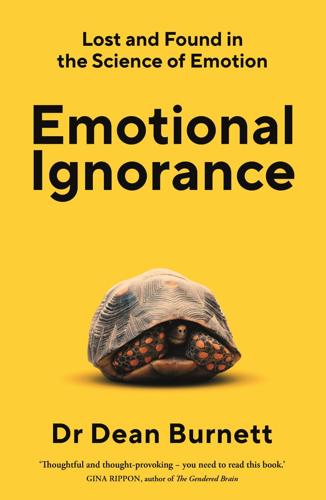
Emotional Ignorance: Lost and Found in the Science of Emotion
by
Dean Burnett
Published 10 Jan 2023
These neurons become active when observing functions associated with that brain region, rather than performing them. They mirror the activity of others. Hence, mirror neurons.84 Since then, activity suggestive of mirror neurons has been reported throughout the human brain,||| particularly in the premotor cortex, the supplementary motor area, the primary somatosensory cortex, and the inferior parietal cortex.85 These regions are integral for movement, language, sensation, and, in many cases, emotional reactions. Particularly the inferior parietal cortex, which allows us to recognise the emotional elements of human posture and facial expressions.86 Mirror neurons are believed to underlie the process of empathy,87 which makes sense: neurons that mimic the activity you observe would be extremely useful for recognising people’s emotions and prompting the same activity in our own brains.
…
McAdams, ‘Empathy and emotional contagion as a link between recognized and felt emotions in music listening’, Music Perception: An Interdisciplinary Journal, 2012, 31(2): pp. 139–156. 83 Di Pellegrino, G., et al., ‘Understanding motor events: a neurophysiological study’, Experimental Brain Research, 1992, 91(1): pp. 176–180. 84 Kilner, J.M. and R.N. Lemon, ‘What we know currently about mirror neurons’, Current Biology, 2013, 23(23): pp. R1057–R1062. 85 Acharya, S. and S. Shukla, ‘Mirror neurons: enigma of the metaphysical modular brain’, Journal of Natural Science, Biology, and Medicine, 2012, 3(2): p. 118. 86 Engelen, T., et al., ‘A causal role for inferior parietal lobule in emotion body perception’, Cortex, 2015, 73: pp. 195–202. 87 Decety, J. and P.L.
…
absence of emotions: DB’s imagined scenario 1, 2, 3; negative consequences of 1; in science fiction 1, 2, 3, 4 acting work: actor/character relationship 1; emotional labour 1 action representation network (brain) 1 adolescence and early adulthood: brain development 1; crushes 1, 2; intense emotions 1; nightmare frequency 1, 2; safe exposure to negative emotions 1, 2; social media use 1 see also infancy and childhood affect: definition and components 1; versus basic emotions 1 airport security, facial recognition technology 1 altruism 1, 2 amygdala (brain region): and dreaming 1; and emotional regulation 1, 2; and emotions processing 1, 2, 3, 4, 5, 6, 7, 8, 9; gender differences 1; influence of testosterone 1; and memory formation 1; as part of olfactory system 1 AND model of nightmare production 1 anger: as ‘basic’ emotion 1, 2; and colour red 1, 2; DB’s anger during grief 1, 2, 3; facial expression of 1, 2; as ‘masculine’ 1(fn); and motivation 1, 2 see also negative emotions angular gyrus (brain region) 1, 2 anosmia (inability to smell) 1 anterior cingulate cortex (brain region) 1, 2, 3, 4 anterior olfactory nucleus (brain region) 1 anxiety: caused by work 1; performance anxiety 1; social anxiety 1, 2, 3; and status 1; vagus nerve stimulation treatment 1 see also negative emotions; stress apatheia (ultimate goal of Stoicism) 1 appraisal theory 1, 2 approach-attachment behaviour 1 approach versus avoid motivation 1, 2 arguments with romantic partner 1 arousal (component of affect) 1, 2, 3 asexuality 1 @AstroKatie (Katherine Mack) 1 attachment during early childhood 1, 2 see also parent emotional bond attention restoration, and colour green 1 auditory cortex (brain region) 1, 2(fn) auditory processing 1, 2, 3, 4, 5(fn) autism 1, 2 automated voices and announcements, annoyance caused by 1 avatar therapy 1 avoid versus approach motivation 1, 2 babies in the womb, playing music to 1, 2 baby-parent emotional bond 1, 2, 3 see also attachment during early childhood Bain, Alexander 1 Baron-Cohen, Simon 1 Barrett, Lisa Feldman 1, 2 basal ganglia (brain region) 1 basic emotions theory 1, 2, 3, 4 BDSM (sexual practice) 1, 2 belief perseverance 1 Bell, Charles 1, 2 bias: confirmation bias 1, 2, 3; fading affect bias 1, 2, 3; ingroup versus outgroup bias 1; negativity bias 1, 2 Blackmore, Chris 1, 2, 3 blinking, by cartoon characters 1 blood sugar, effect on emotions 1 blue colour, associations and effects 1, 2, 3 body, emotions experienced in see physiology-emotion connection body language: communicating emotion 1, 2, 3, 4; mimicry 1; missing from communication technologies 1 brain: body’s influence on 1; competing resource demands 1, 2, 3; development 1; distinguishing what is real/not real 1, 2; emotions as conscious or subconscious processes 1; gender differences (beliefs and experimental studies) 1; influence of oestrogen and testosterone 1; left brain/right brain facts and myths 1, 2, 3(fn), 4(fn); lobotomies 1; mirror neurons 1, 2, 3, 4; nervous and endocrine system regulation 1; neurotransmitters 1, 2, 3, 4, 5, 6; reward pathway and system 1, 2, 3, 4; somatic marker hypothesis 1; spindle cells 1; synapses 1, 2; triune model 1, 2 see also cognition (thinking); learning (of information); memory(ies) brain, functional regions: action representation 1; auditory processing 1, 2, 3, 4, 5(fn); cognition 1, 2, 3, 4; disgust 1; emotional regulation 1, 2; emotions (overview) 1, 2, 3; fear 1; imagination 1; intention processing 1; language processing 1; love 1, 2; lust 1, 2; memories 1, 2, 3, 4, 5; motivation 1, 2; olfactory processing 1, 2; visual processing 1, 2, 3 see also specific brain regions brain scans, limitations for studying emotions 1 brainstem 1, 2, 3, 4, 5 breastfeeding 1, 2 Broca’s area (brain) 1 Brown, Thomas 1, 2 Buddhism 1 bullying online 1 burnout 1, 2 Bushman, B.J. 1 bystander effect 1 cancer awareness, role of news and media 1 canned laughter, annoyance caused by 1, 2 categories and types of emotion: basic emotions (theory) 1, 2, 3, 4; identified by James McCosh 1 see also identifying and defining ‘emotions’ cats and other pets, emotional attachment to 1 caudate nucleus (brain region) 1 celebrity endorsements 1, 2, 3, 4 cerebellum (brain region) 1, 2, 3 childbirth, role of oxytocin 1 childhood see infancy and childhood chilli, enjoyment of pain caused by 1 cigarette smoke, DB’s memories and associations 1, 2 cognition-emotion relationship see emotion-cognition relationship cognition (thinking): brain regions associated with 1, 2, 3, 4; effect of love on 1; executive control 1, 2, 3; ‘flow’ state 1; and intrusive thoughts 1; and motivation 1, 2, 3, 4, 5; and social relationships 1, 2 see also learning (of information) cognitive dissonance 1 colours: cultural associations 1; in DB’s friend’s home 1, 2; emotional response to 1; and visual processing 1, 2, 3 communicating and sharing emotions: machine detection of emotions 1, 2; nonverbal information 1, 2, 3; online versus in-person 1, 2; at work 1, 2, 3, 4, 5 see also emotional contagion; empathy; facial expressions and emotions communication technologies see phone calls; social media and online communication; therapeutic applications of technologies; video calls confirmation bias 1, 2, 3 conformity 1, 2, 3, 4 consciousness, evolution of 1 consolidation of memories 1, 2, 3, 4 conspiracy theories 1, 2, 3, 4, 5 see also deception; misinformation and ‘fake news’ constructed emotions theory 1, 2 corpus callosum (brain region) 1 cortex/neocortex (brain region) (in general) 1 see also specific regions of the cortex cortisol 1 cross-race effect 1 crushes, in adolescence 1, 2 crying: DB’s (in)ability to cry 1, 2, 3, 4, 5, 6; gender differences 1; induced by TV and films 1; types and functions of tears 1 cuteness and cute aggression 1 cyberbullying 1 dancing 1 Darwin, Charles 1, 2 deception: automated voices and announcements 1; response to 1, 2; self-deception 1 see also manipulation of emotions; misinformation and ‘fake news’ defining ‘emotions’ 1, 2, 3, 4 deindividuation and ‘mob mentality’ 1 depression: caused by work 1, 2; gender differences 1; and gut microbiome 1; and memory 1; post-natal depression 1, 2; vagus nerve stimulation treatment 1 Diana, Princess of Wales, impact of death 1 digestive system, influence of 1, 2 disgust: as ‘basic’ emotion 1, 2; brain region associated with 1; and colour green 1; facial expression of 1, 2; and horror 1; and memory 1; and suppressed motivation 1 see also negative emotions doctors, emotional aspects of work 1 dopamine 1 drama therapy 1 dreams and nightmares: AND model 1; bizarre nature of 1, 2; DB’s bad dreams 1, 2, 3; due to COVID-19 pandemic 1, 2; and emotion processing 1; Freud’s interpretations 1; and memory consolidation 1; and mental health 1; post-traumatic 1; prevalence of nightmares 1; recurring 1; threat simulation theory 1 Dunbar’s number (of social relationships) 1 dysgranular field (brain region) 1 dysphoria 1 see also depression e-learning, motivation in 1 earworms 1 Ekman, Paul 1, 2, 3, 4 Eleri, Carys 1 embarrassment 1, 2, 3, 4, 5, 6, 7 see also negative emotions emojis and emoticons 1 emotion-cognition relationship: appraisal theory 1, 2; in attention and focus 1, 2, 3, 4; belief perseverance 1; cognitive dissonance 1; competition for brain’s resources 1, 2; confirmation bias 1, 2, 3; distinction recognised by Stoics 1; in effect of emotions experienced 1; in empathy 1; in ‘flow’ state 1; interrelatedness (in general) 1, 2, 3, 4; in learning and information processing 1, 2, 3; in love 1; motivated reasoning 1; in motivation 1, 2, 3; negativity bias 1, 2; role of imagination 1; shared evolutionary origin 1; in stage fright 1 emotion-memory relationship: appraisal theory 1, 2; emotions triggered by memories 1, 2, 3, 4; fading affect bias 1, 2, 3; happy memories being more detailed 1; for implicit memories 1; later emotions changing memories 1, 2, 3; longevity and potency of emotional memories 1, 2, 3, 4, 5, 6; in memory consolidation 1, 2; in PTSD 1, 2, 3, 4, 5; role of nightmares 1; suppressing emotional memories 1 emotional contagion: dangers of ‘mob mentality’ 1; versus empathy 1; evolutionary importance 1; from groups of people 1, 2, 3; from music 1, 2, 3; neurological mechanism for 1; from social media 1 emotional detachment/suppression at work 1, 2, 3, 4 emotional manipulation see manipulation of emotions emotional processing 1, 2 emotional regulation, brain regions responsible for 1, 2 emotional relationships: attachment during early childhood 1, 2; friendships 1, 2; one-sided see parasocial (one-sided) relationships; parent-baby emotional bond 1, 2, 3; role of neurotransmitters 1, 2; romantic see romantic relationships; see also social relationships emotions: causing change 1; as conscious/subconscious processes 1; historical study of 1; identifying and defining 1, 2, 3, 4; language of 1, 2 see also categories and types of emotion; communicating and sharing emotions; emotion relationship; emotion relationship; negative emotions; physiology connection; positive emotions; specific emotions empathy: and autism 1, 2; in babies 1; and body language mimicry 1; versus emotional contagion 1; evolutionary importance 1, 2, 3; influence of own emotions on 1; as ingrained 1, 2; ingroup versus outgroup bias 1; versus mentalising (theory of mind) 1; neurological mechanism for 1, 2, 3, 4; and physical pain 1; in romantic relationships 1; as selfish/unselfish 1 endocannabinoids 1 endocrine system 1 endorphins 1, 2 envy 1, 2 see also negative emotions episodic memories 1, 2, 3 evaluative conditioning 1 excitation transfer theory 1 executive control 1, 2, 3 see also cognition (thinking) existential dread, as a motivator 1 explicit memories 1 extrinsic versus intrinsic motivation 1 Facebook: DB’s use of 1, 2; research into emotional manipulation 1, 2, 3 see also social media and online communication faces, seeing in inanimate objects 1 facial colour changes 1 facial expressions and emotions: in artificial/CGI faces (uncanny valley) 1; automated emotion recognition 1; in cartoon characters (blinking) 1; cross-cultural similarities and differences 1, 2; difficulties distinguishing between emotions without context 1, 2, 3; early writings on 1; Ekman’s work 1, 2, 3, 4; ‘invisible’ emotions 1; involuntary nature of expressions 1, 2, 3, 4; online curation of emotions portrayed 1 facial paralysis, and empathy 1 facial recognition, cross-race effect 1 facial recognition technology 1 fading affect bias 1, 2, 3 ‘fake news’ see misinformation and ‘fake news’ fandom 1, 2 see also parasocial (one relationships fear: as ‘basic’ emotion 1, 2; brain region associated with 1; enjoyment of 1, 2; facial expression and colour 1, 2; as first emotion 1; of flying 1; and horror 1; and imagination 1; and motivation 1, 2, 3; in PTSD 1; smell of (in sweat) 1 see also negative emotions films and TV causing negative emotions 1, 2, 3, 4 Firth-Godbehere, Richard 1, 2, 3, 4, 5 flat Earth conspiracy theory 1, 2 ‘flow’ state 1 flying, fear of 1 football shirts, red colour’s competitive advantage 1 Freud, Sigmund 1, 2 friendships 1, 2 see also emotional relationships; social relationships frosty atmospheres, emotional contagion 1, 2 funerals: crying at 1; of DB’s father 1, 2, 3, 4, 5; emotional contagion at 1, 2; live streaming 1, 2 gender differences: adolescent crushes 1(fn); attitudes towards infidelity 1; in brains (beliefs and experimental studies) 1; in brains (DB’s impossible experiment) 1; in emotional regulation and expression 1, 2, 3, 4, 5, 6; ‘maternal instinct’ 1; mental health problems 1; other physiological differences 1; societal influences 1 gender discrimination 1, 2, 3 goal distraction 1 green colour, associations and effects 1, 2, 3 grief: DB’s acceptance of emotions 1; DB’s anger 1, 2, 3; DB’s attempts to disguise grief 1; DB’s emotional confusion 1, 2, 3; DB’s (in)ability to cry 1, 2, 3, 4, 5, 6; DB’s motivation and productivity 1, 2; DB’s need to talk after funeral 1; at death of Princess Diana 1; emotional processing 1, 2; shared grieving 1; stages of 1 see also negative emotions guilt 1 see also negative emotions habituation 1, 2 ‘hangry’ behaviour 1 happiness 1 hippocampus (brain region): and dreaming 1; and emotional regulation 1; and emotions processing 1, 2, 3; and imagination 1; and memory 1, 2, 3, 4, 5; and navigation 1 Holmes and Rahe stress scale 1, 2 Holmes, Sherlock (analogy for action representation) 1 hormones: cortisol 1; digestive 1, 2; effect of tears on 1; influence on the brain (and emotions) 1; oestrogen 1, 2; oxytocin 1, 2, 3, 4, 5, 6; testosterone 1, 2, 3; vasopressin 1, 2, 3 see also endocrine system horror (emotion) 1 horror movies 1, 2, 3 hypothalamus (brain region) 1, 2, 3 hysteria 1 Icke, David 1 identification, in parasocial relationships 1 identifying and defining ‘emotions’ 1, 2, 3, 4 imaginary friends 1 imagination and mental imagery 1, 2 imitation of observed actions 1 implicit memories 1 impression management 1, 2, 3, 4, 5 infancy and childhood: attachment with primary caregiver 1, 2; breastfeeding 1, 2; DB’s memories of 1, 2; emotional experiences 1; empathy in babies 1; imaginary friends 1; importance of sense of smell 1; learning from media characters 1; nightmare frequency 1, 2; oxytocin in newborns 1; parent-baby emotional bond 1, 2, 3 see also adolescence and early adulthood inferior frontal cortex (brain region) 1, 2 inferior parietal cortex (brain region) 1 infidelity, emotional versus sexual 1 insular cortex (insula) (brain region) 1, 2, 3, 4 intelligence, and brain anatomy 1 intention processing 1 intrinsic versus extrinsic motivation 1 intrusive thoughts 1 Izard, Carroll E. 1 jealousy 1 Kübler-Ross, Elizabeth 1 language of emotions 1, 2 language processing 1 learning (of information): from media characters 1; motivation 1, 2; from other people 1, 2; processing demands and information prioritisation 1, 2; from senses 1 LeDoux, Joseph 1 left brain/right brain facts and myths 1, 2, 3(fn), 4(fn) limbic system (brain region) 1, 2, 3, 4 lobotomies 1 Lomas, Tim 1 London taxi drivers, brain study 1 losing oneself in a book/film 1 love: brain regions associated with 1, 2; demands on the brain 1; effect on cognition 1; for family and friends 1, 2(fn); role of dopamine 1; romantic love 1, 2, 3 see also romantic relationships lust and sexual attraction: asexuality 1; brain regions associated with 1, 2; and romantic relationships 1, 2; Stoics’ rejection of 1, 2; suppression of 1 Mack, Katherine (@AstroKatie) 1 mammal brain (region) 1, 2, 3, 4 manipulation of emotions: by authorities 1; for marketing 1, 2, 3, 4, 5; response to 1; by social media 1; by traditional news and media 1, 2, 3, 4 marketing 1, 2, 3, 4, 5 McCosh, James 1 medical work, emotional aspects 1 memory(ies): brain regions associated with 1, 2, 3, 4, 5; changeable nature of 1, 2, 3, 4, 5, 6, 7; connections with objects 1, 2, 3, 4; consolidation 1, 2, 3, 4; DB’s memories of early childhood 1, 2; DB’s memories of his father 1, 2, 3, 4, 5, 6; episodic memories 1, 2, 3; explicit memories 1; fading affect bias 1, 2, 3; forgetting memories 1; and imagination 1; implicit memories 1; and music 1; procedural memories 1; reminiscence bump 1; retroactive memory enhancement 1; semantic memories 1; and sleep 1; and smell(s) 1, 2, 3, 4; suppression of 1; as synapses 1, 2; working memory 1; Zeigarnik effect 1 see also emotion relationship mental health/illness: and social media 1; and status 1; therapeutic applications of technologies 1 see also anxiety; depression; PTSD; schizophrenia mental imagery and imagination 1, 2 mentalising (theory of mind) 1, 2 mirror neurons 1, 2, 3, 4 mirroring body language 1 misinformation and ‘fake news’: about COVID-19 pandemic 1, 2; David Icke’s space lizards 1; flat Earth theory 1, 2; and social media/internet 1, 2, 3, 4; susceptibility to 1 see also deception ‘mob mentality’ (deindividuation) 1 Moebius syndrome (facial paralysis) 1 monkey experiments, mirror neurons 1 Morgan, Matt 1 motivated reasoning 1 motivation: approach-attachment behaviour 1; approach versus avoid motivation 1, 2; brain regions associated with 1, 2; and cognition 1, 2, 3, 4, 5; DB’s experiences during grief 1, 2; and emotions 1, 2, 3, 4, 5, 6; intrinsic versus extrinsic motivation 1; and novelty 1, 2, 3, 4 motivational salience 1 music: dancing 1; DB’s emotional response to 1, 2, 3, 4; differentiating between voice and instruments 1; earworms 1; emotional contagion from 1, 2, 3; emotional response to 1, 2; evolutionary significance 1, 2; and memory 1 musical expectancy 1, 2 navigation, role of hippocampus 1 negative emotions: and attention/focus 1, 2, 3, 4, 5; and creativity 1; emotion processing 1, 2; feeling good whilst experiencing 1, 2, 3; induced by TV and films 1, 2, 3, 4; and intrusive thoughts 1; and memory 1, 2, 3; as more impactful than positive emotions 1; negativity bias 1, 2; and novelty 1; and performance 1 see also specific emotions negativity bias 1, 2 nervous systems: enteric (‘second brain’) 1; parasympathetic 1, 2, 3; regulation by brain 1; somatic and autonomic 1; sympathetic 1, 2, 3 neurotransmitters 1, 2, 3, 4, 5, 6 news and media (traditional): credibility 1, 2, 3, 4; emotional content 1, 2, 3, 4; precursors to 1 see also conspiracy theories; misinformation and ‘fake news’; social media and online communication nightmares see dreams and nightmares noises, emotional response to 1, 2, 3 see also music novelty 1, 2, 3, 4, 5 objects, and memories 1, 2, 3, 4 oestrogen 1, 2 olfactory bulb and cortex (brain region) 1, 2, 3 olfactory system 1, 2, 3, 4 one-sided relationships see parasocial (one-sided) relationships online communication see social media and online communication online learning, motivation in 1 orbitofrontal cortex (brain region) 1, 2 oxytocin 1, 2, 3, 4, 5, 6 pain (physical): and empathy 1; enjoyment of 1, 2 paracingulate sulcus (brain region) 1 parasocial (one-sided) relationships: adolescent crushes 1, 2; benefits 1, 2; ending the relationship 1; with fictional characters 1, 2, 3, 4; identification with the object 1; with imaginary friends 1; losing oneself in a narrative 1; meeting the object 1; negative aspects 1; neurological mechanisms 1; with people you haven’t met 1, 2, 3, 4, 5 parasympathetic nervous system 1, 2, 3 Parch (TV drama), actor’s experiences 1 pareidolia 1 parent-baby emotional bond 1, 2, 3 see also attachment during early childhood ‘passions’ 1, 2, 3 pathos 1 performance anxiety (stage fright) 1 personality, influence of early experiences 1, 2 phone calls: DB’s last call to father 1; lack of nonverbal emotional cues 1; walking around during 1 physiology-emotion connection: body influencing emotion 1; emotion influencing the body 1; somatic marker hypothesis 1 see also crying Pickle (DB’s cat) 1 Pixar movies 1, 2(fn), 3 positive emotions: and attention/focus 1, 2; and memory 1, 2 see also specific emotions ‘Positive Lexicography’ project 1 post-natal depression 1, 2 posterior parietal cortex (brain region) 1, 2 prefrontal cortex (brain region): cognitive functions 1, 2, 3; and emotional regulation 1, 2; and emotions processing 1, 2; and imagination 1; influence of testosterone 1; and memory 1; and mentalising (theory of mind) 1; and motivation 1, 2 pride 1 procedural memories 1 processing (negative) emotions 1, 2 Proust, Marcel, In Search of Lost Time 1 psycho-emotional tears 1, 2 PTSD (post-traumatic stress disorder) 1, 2, 3, 4, 5 racism: cross-race effect 1; and oxytocin 1 rage see anger red colour, associations and effects 1, 2, 3 relationships see emotional relationships religious perspectives on emotions 1 reminiscence bump 1 reptile brain (region) 1 ‘resting bitch face’ 1 retroactive memory enhancement 1 reward, and motivation 1 reward pathways of brain 1, 2, 3, 4 Ridley, Rosalind 1 Rippon, Gina 1, 2, 3 romantic relationships: adolescent crushes as preparation for 1; attitudes towards infidelity 1; disagreements and disputes 1; emotional connection between partners 1, 2; empathy versus problem ‘fixing’ in 1; long-term relationships 1, 2; love in 1, 2, 3; negative emotions in 1; online versus in-person 1; and own identity 1, 2; physical attraction in 1, 2; role of oxytocin 1; stress associated with losing partner 1, 2; trumpeting on social media 1 see also emotional relationships sadness: as ‘basic’ emotion 1; and colour blue 1, 2; enjoyment of 1, 2, 3; facial expression of 1 schadenfreude 1, 2 schizophrenia 1 scientific method 1, 2 scientists: motivations 1, 2, 3; popular portrayal as lacking emotion 1 self-deception 1 semantic memories 1 Sesame Street (TV) show, learning from 1 sex differences see gender differences sexism see gender discrimination sexual activity, BDSM 1, 2 sexual attraction see lust and sexual attraction sharing emotions see communicating and sharing emotions Simpsons, The (TV show), blinking in 1(fn) Singer, Tania 1 sleep 1, 2, 3 see also dreams and nightmares smell(s): anosmia (inability to smell) 1; DB’s memories of cigarette smoke 1, 2; and emotions 1, 2; evolutionary importance 1, 2, 3; and memory 1, 2, 3, 4; olfactory system 1, 2, 3, 4 social anxiety 1, 2, 3 social media and online communication: adolescents 1; adults/older people 1; emojis and emoticons 1; and emotional contagion 1; impression management 1, 2, 3, 4, 5; lack of nonverbal emotional cues 1, 2; live streaming funerals 1, 2; machine detection of emotions 1; negative aspects 1, 2, 3, 4, 5; online versus in-person emotions and personae 1; positive aspects 1, 2; versus real-world interactions, cognitive demands 1; and reward 1, 2, 3; and self-deception 1; and self-validation 1, 2, 3; and status 1, 2 see also conspiracy theories; Facebook; misinformation and ‘fake news’; news and media (traditional); video calls social relationships: cognitive load associated with 1, 2; Dunbar’s number 1; friendships 1, 2; one-sided see parasocial (one-sided) relationships; see also emotional relationships somatic marker hypothesis 1 spicy food, enjoyment of pain caused by 1 spindle cells 1 Spiner, Brent 1 sports kit, competitive advantage of wearing red 1 SPOT (Screening of Passengers by Observation Techniques) programme 1 stage fright 1 stalkers 1 Star Trek: The Next Generation (TV series): Data actor’s experience of fans 1; Data’s inability to choose ice-cream flavour 1 Star Trek (TV series): Stoicism of Vulcans 1, 2; universal use of English language 1 Starbucks (branding) 1 status: and emotions 1; and social media 1, 2; subjective status and mental health 1 Stoics and Stoicism 1, 2 stress: benefits of green environments for 1; caused by uncertainty 1; caused by work 1, 2; coping mechanisms 1; cortisol 1; Holmes and Rahe stress scale 1, 2; PTSD 1, 2, 3, 4, 5; and status 1; Yerkes-Dodson curve 1 see also anxiety; negative emotions striatum (brain region) 1 study of emotions (historical) 1 suicide 1, 2 superior temporal cortex (brain region) 1, 2, 3, 4 suppression of emotions: during disagreements with romantic partner 1; in learning and decision making (as impossible) 1; at work 1, 2, 3, 4 supramarginal gyrus (brain region) 1 surprise 1, 2 sympathetic nervous system 1, 2, 3 synapses (neuron connections) 1, 2 taxi drivers, brain study 1 tears, types and functions of 1 teenage years see adolescence and early adulthood temporal lobe (brain region) 1, 2 testosterone 1, 2, 3 thalamus (brain region) 1, 2, 3 theories of emotions see basic emotions theory; constructed emotions theory theory of mind (mentalising) 1, 2 thinking see cognition (thinking) threat simulation theory 1 transportation phenomenon 1 triune brain model 1, 2 TV and films causing negative emotions 1, 2, 3, 4 types of emotion see categories and types of emotion uncanny valley 1 uncertainty, unpleasant nature of 1 vagus nerve 1 valence (component of affect) 1, 2 vasopressin 1, 2, 3 video calls: DB’s call with friends after father’s funeral 1; lack of nonverbal emotional cues 1 virtual reality (VR) 1 visual cortex (brain region) 1, 2 visual processing 1, 2, 3, 4, 5, 6 see also colours voice characteristics, and communicating emotion 1 volcano/cupcake scenario (competing motivations) 1 wine tasting and appreciation 1 work and workplaces: communicating the wrong emotions at work 1; DB’s job embalming cadavers 1, 2, 3(fn); emotional aspects of medical work 1; emotional detachment/suppression 1, 2, 3, 4; emotional labour of acting work 1; mental health problems caused by 1, 2, 3, 4, 5, 6; performance appraisals 1, 2; wellbeing initiatives 1, 2 working memory 1 yawning, as contagious 1 Yerkes-Dodson curve 1 Zeigarnik effect (tendency to forget completed tasks) 1 ‘zone,’ state of being in 1 Zoom calls see video calls About the Author Dean Burnett is a neuroscientist, blogger, sometimes-comedian and author.

Mind in Motion: How Action Shapes Thought
by
Barbara Tversky
Published 20 May 2019
Cognition, 96(1), B1–B11. Mirror neurons Rizzolatti, G. (2005). The mirror neuron system and imitation. Perspectives on Imitation: Mechanisms of Imitation and Imitation in Animals, 1, 55. Rizzolatti, G., Fadiga, L., Gallese, V., & Fogassi, L. (1996). Premotor cortex and the recognition of motor actions. Cognitive Brain Research, 3(2), 131–141. Motor resonance Fadiga, L., Craighero, L., & Olivier, E. (2005). Human motor cortex excitability during the perception of others’ action. Current Opinion in Neurobiology, 15(2), 213–218. Iacoboni, M. (2009). Imitation, empathy, and mirror neurons. Annual Review of Psychology, 60, 653–670.
…
Not all intentions and actions, of course, but reaching for an object is an important and common one, and there are undoubtedly others. Understanding others’ intentions comes about in part because of experience enacting similar actions with similar intentions. Moreover, as we shall see next, it has become clear that the very structure of the brain is primed for understanding observed action, through the mirror neuron system. MIRROR NEURONS In the late 1980s, a group of neuroscientists in Parma, Italy, led by Giacomo Rizzolatti made a surprising discovery. They implanted tiny electrodes in individual neurons in premotor cortex (inferior frontal gyrus and inferior parietal lobe) of macaque monkeys that allowed them to record activity in single neurons in animals who were moving about as they normally do.
…
They implanted tiny electrodes in individual neurons in premotor cortex (inferior frontal gyrus and inferior parietal lobe) of macaque monkeys that allowed them to record activity in single neurons in animals who were moving about as they normally do. They found single neurons that fired when the monkey performed a specific action, like grasping or throwing. What was remarkable was that the exact same neuron fired when the animal saw someone else, in this case, a human, perform the same action. They called these remarkable neurons mirror neurons. Mirror neurons unite doing and seeing for specific actions. This extraordinary discovery means that action and perception are joined automatically by specific individual neurons without any mediation whatsoever. Different actions are encoded by different neurons: for monkeys, grasping, throwing, tearing.
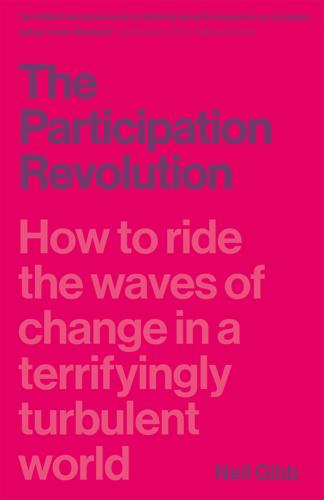
The Participation Revolution: How to Ride the Waves of Change in a Terrifyingly Turbulent World
by
Neil Gibb
Published 15 Feb 2018
It wasn’t until four years later, when he published a far more detailed account in Brain Magazine, that the implications of what his team had discovered really landed, triggering a surge of research – over the following 10 years, more than 300 papers were published on different aspects of how mirror neurons work. Mirror neurons begin to explain a lot of what can seem like very strange human behaviour – from why we get quite so obsessed and immersed in watching sports to why pornography is so addictive to some people. As far as the brain is concerned, when mirror neurons are firing it is exactly the same as if the body itself was involved. On 13 May 2012, Manchester United’s arch rivals, Manchester City, played Queens Park Rangers in the final game of the English Premier League season.
…
They looked highly uncomfortable doing what they were doing – as if they weren’t quite sure why they were doing it. This was mirror neurons at work. One of the reasons sports fans get so caught up in the game, so passionate and angry, is because as far as their brains are concerned they are participating. Their mirror neurons are firing and they are having the experience of being in the game. The ending of the Man City game was so explosive that some fans actually acted out what their brains were experiencing. Mirror neurons explain why the combination of GoPro’s “point-of-view” camera and easy-to-use software was so successful – GoPro didn’t just allow those involved in extreme pursuits to participate more fully, it allowed the brains of those viewing it to have the experience of participating too.
…
As he passed in front of the monkey, one of his colleagues noticed something strange: the monitors registered that the monkey’s premotor cortex had come to life, even though the monkey hadn’t moved. He asked his colleague with the ice cream to move back in front of the monkey while eating it and the same thing happened. What Rizzolatti’s team had discovered are what he later called “mirror neurons”, neurons that fire when we observe someone else doing a task in exactly the same way as if we were undertaking the task ourselves. It took a while for Rizzolatti’s findings to be taken seriously because they seemed so strange even to him. As he said in an interview in the New York Times in 2006: “It took us several years to believe what we were seeing.”
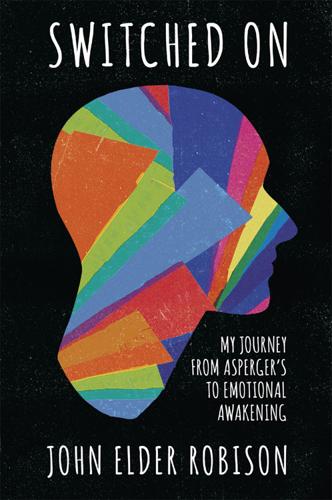
Switched On: My Journey From Asperger's to Emotional Awakening
by
John Elder Robison
Published 6 Apr 2016
She proposed using similar technologies on people, by pulsing electromagnets to fire microscopic shots of energy into the brain. I’d never considered such a possibility, but I was intrigued. And the mirror neuron thing was fascinating too. I’d recently read up on mirror neurons—brain cells that cause us to act out what we see or hear. We see our mother smile at us, and our mirror neurons make us smile in response, sort of a monkey see, monkey do effect (literally so, because it was first observed in monkeys). The idea of stimulating mirror neurons with electricity sounded more than cool to a techno geek like me. I had a brief vision of Frankenstein’s monster with lightning sizzling between his ears, but I understood that this would be something far subtler.
…
Then I thought back to a section I remembered reading in one of Lindsay’s articles: “Are mirror neurons involved in the ability to understand metaphors? Autistic individuals typically have difficulties with metaphors, often interpreting them literally, and the researchers believe this too may be connected to a dysfunctional mirror neuron system.” That was exactly what was happening to me. What was music if not melody and metaphor? And if that was so, my understanding of music was surely enhanced by TMS. Mirror neurons might or might not lie at the root of the change. Whatever the explanation turned out to be, I knew that Lindsay, Shirley, Alvaro, and company were onto something big.
…
Some scientists are asking the same question after observing near-normal language in people with major damage to their speech centres. Alvaro and his researchers also thought Broca’s area controlled more than just speech. They had chosen to stimulate there because of Broca’s relationship to mirror neurons. Broca is one of the key parts of the brain’s mirror neuron system, which is tied in turn to social interaction. According to Lindsay, that’s probably why I had such strong emotional responses to its stimulation. Broca’s area is a region in the left frontal lobe named for Pierre-Paul Broca, a French physician of the mid-nineteenth century.
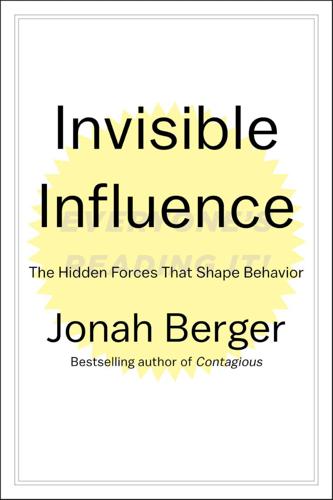
Invisible Influence: The Hidden Forces that Shape Behavior
by
Jonah Berger
Published 13 Jun 2016
Simner, Marvin (1971), “Newborn’s Response to the Cry of Another Infant,” Developmental Psychology 5, 136–50. 8. Mirror Neuron Forum (2011), Perspectives on Psychological Science 6, 369–407. 9. For an early discussion of mirror neurons, see Fadiga, L., L. Fogassi, G. Pavesi, and G. Rizzolatti (1995), “Motor Facilitation During Action Observation: A Magnetic Stimulation Study,” Journal of Neurophysiology 73, 2608–11. For a more recent discussion, see Gallese, Vittorio, M. Gernsbacher, C. Hayes, G. Hickok, and M. Iacoboni (2011), “Mirror Neuron Forum,” Perspectives on Psychological Science 6, 369–407. 10. Maddux, W. W., E. Mullen, and A.
…
The cells even fired for sounds. When the monkey cracked open a peanut but also when it heard someone else crack open a peanut. Observing someone doing something led the monkey’s brain to simulate that same action itself. The Italian scientists had discovered what we know today as “mirror neurons.” Since that initial discovery, researchers have found mirror neurons in humans as well. Watching someone else engage in an action activates the same cortical region as engaging in that action. Watch others grab an object, and the motor-evoked potentials, or signal that a muscle is ready to move, is similar to grasping that object ourselves.9 Others can thus prime us for action.
…
But years of subtly mimicking each other has not only made them happier, it’s made them look more similar as well. III. Mirror neurons may have evolved to facilitate knowledge acquisition. Infants are faced with the daunting task of learning hundreds of new things. From smiling and moving limbs to eventually walking and talking. It’s as if you’ve been plopped down at the controls of a spacecraft and suddenly been asked to pilot the thing. Everything is unknown. Mirror neurons help accelerate learning. Rather than having to figure out how to produce a smile by yourself, watching someone else do it should encourage that action.

The Narcissist Next Door
by
Jeffrey Kluger
Published 25 Aug 2014
It doesn’t even have a crisp function like the occipital lobe, where visual input is processed, or the olfactory bulb, where smell lives. But it does important work—particularly when it comes to empathy. That, in turn, is due in large part to what are known as mirror neurons. Until thirty or so years ago, no one even knew mirror neurons existed—but everyone knew what they did. You see someone yawn, you yawn; you see someone in acute pain, you squirm. Someone cries—even just an actor playing a role, whose sorrow, you know, is entirely, artfully counterfeit—and you tear up too. Someone goes off on a laughing jag—particularly someone on live TV, who is trying to hold it together and simply can’t—and you dissolve into a laughter puddle too.
…
It also explains why newborns mimic the same open-mouth or tongue-out expressions monkeys do, even before the babies have ever seen themselves in a mirror, which means that they don’t yet know in any conscious way that their face has the same components as the face that’s in front of them—or even, for that matter, that they have a face at all. “Mirror neurons have incredible visual properties,” says Marco Iacoboni, professor of psychiatry and biobehavioral sciences at UCLA, who has been studying them since 1999. “They get activated merely by watching, causing us to imitate gestures and postures—not explicitly, but subtly. Social scientists call this the chameleon effect. Some people tend to be more chameleonlike than others. Some less.” And all of that is the work of just the mirror neurons in the premotor region. Subsequent studies have found that about 10 percent of all neurons scattered throughout the brain have some mirroring properties, including the neurons in regions that regulate emotion—and that can be both good and bad.
…
Existing brain research, along with Keysers’s own, had already pinpointed the spots in the brain where both the pleasant and unpleasant sensations are processed when people experience the stroke or the slap of the finger twist themselves. In observers—at least observers capable of experiencing empathy—mirror neurons in the same regions should light up. In people without empathy there should be little or nothing. Keysers scanned his subjects in 2007, but only in the summer of 2013 were the results at last published, in the journal Brain. As expected, he reported, the mirror neurons of the criminal subjects indeed barely stirred when they saw someone else experience either pleasure or pain. But there was another piece to his findings—and that piece offered a little more hope.
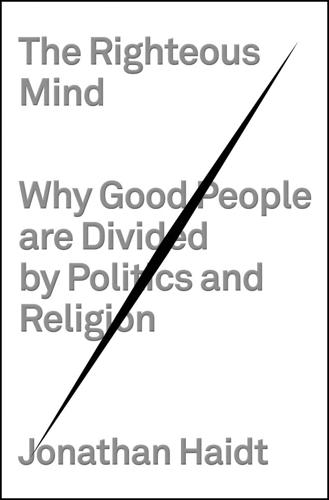
The Righteous Mind: Why Good People Are Divided by Politics and Religion
by
Jonathan Haidt
Published 13 Mar 2012
The monkey seemed to mirror the actions of others in the same part of its brain that it would use to do those actions itself.35 Later work demonstrated that most mirror neurons fire not when they see a specific physical movement but when they see an action that indicates a more general goal or intention. For example, watching a video of a hand picking up a cup from a clean table, as if to bring it to the person’s mouth, triggers a mirror neuron for eating. But the exact same hand movement and the exact same cup picked up from a messy table (where a meal seems to be finished) triggers a different mirror neuron for picking things up in general. The monkeys have neural systems that infer the intentions of others—which is clearly a prerequisite for Tomasello’s shared intentionality36—but they aren’t yet ready to share.
…
The monkeys have neural systems that infer the intentions of others—which is clearly a prerequisite for Tomasello’s shared intentionality36—but they aren’t yet ready to share. Mirror neurons seem designed for the monkeys’ own private use, either to help them learn from others or to help them predict what another monkey will do next. In humans the mirror neuron system is found in brain regions that correspond directly to those studied in macaques. But in humans the mirror neurons have a much stronger connection to emotion-related areas of the brain—first to the insular cortex, and from there to the amygdala and other limbic areas.37 People feel each other’s pain and joy to a much greater degree than do any other primates.
…
The authors conclude that their findings “provide evidence for the idea that neurobiological mechanisms in general, and oxytocinergic systems in particular, evolved to sustain and facilitate within-group coordination and cooperation.” The second candidate for sustaining within-group coordination is the mirror neuron system. Mirror neurons were discovered accidentally in the 1980s when a team of Italian scientists began inserting tiny electrodes into individual neurons in the brains of Macaque monkeys. The researchers were trying to find out what some individual cells were doing in a region of the cerebral cortex that they knew controls fine motor movements.
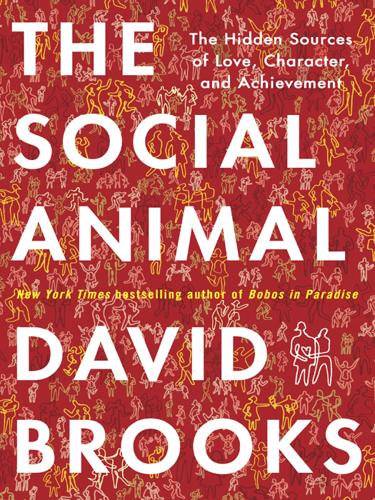
The Social Animal: The Hidden Sources of Love, Character, and Achievement
by
David Brooks
Published 8 Mar 2011
The monkey was automatically simulating the mental processes it observed in another. So was born the theory of mirror neurons, the idea that we have in our heads neurons that automatically re-create the mental patterns of those around us. Mirror neurons are not physically different from any other sort of neuron; it’s the way the former are connected that seems to enable them to perform this remarkable task of deep imitation. Over the last few years mirror neurons have become one of the most hyped and debated issues in all of neuroscience. Some scientists believe mirror neurons are akin to DNA, and will revolutionize our understanding of how people internally process outer experiences, how we learn from and communicate with others.
…
But in these examples, the processes of perception and evaluation are all intermingled. They share the same representational systems, the same network patterns in the brain. Since those original experiments in Italy, many scientists, including Iacoboni, believe they have found mirror neurons in humans. Human mirror neurons help people interpret the intention of an action, although unlike monkey mirror neurons, they seem to be able to imitate an action even when no goal is detected. A woman’s brain will respond with a certain pattern as she watches a person use two fingers to pick up a wineglass, but her brain will respond in a different way as she watches a person use two fingers and the same action to pick up a toothbrush.
…
Dye, “A Study of the Effects of Different Stimulation on Mentally Retarded Children,” Proceedings and Addresses of the American Association of Mental Deficiency, 44 (1939), 114–36. 25 As Marco Iacoboni has observed Gordy Slack, “I Feel Your Pain,” Salon, November 5, 2007, http://www.salon.com/news/feature/2007/11/05/mirror_neurons. 26 The monkey’s brains would not fire Marco Iacoboni, Mirroring People: The New Science of How We Connect with Others (New York: Farrar, Straus & Giroux, 2008), 26. 27 Their neurons fired Iacoboni, 35–36. 28 They share the same Richard Restak, The Naked Brain: How the Emerging Neurosociety Is Changing How We Live, Work, and Love (New York: Three Rivers Press, 2006), 58. 29 Human mirror neurons Michael S. Gazzaniga, Human: The Science Behind What Makes Us Human (New York: Harper Perennial, 2008), 178. 30 Carol Eckerman Iacoboni, 50. 31 Tanya Chartrand and John Bargh Iacoboni, 112–14. 32 Robert Provine of the University of Maryland Steven Johnson, Mind Wide Open: Your Brain and the Neuroscience of Everyday Life (New York: Scribner, 2004), 120. 33 Only 15 percent Johnson, 119. 34 As Steven Johnson has written Johnson, 120–21. 35 Coleridge described how Raymond Martin and John Barresi, The Rise and Fall of Soul and Self: An Intellectual History of Personal Identity (New York: Columbia University Press, 2006), 184.
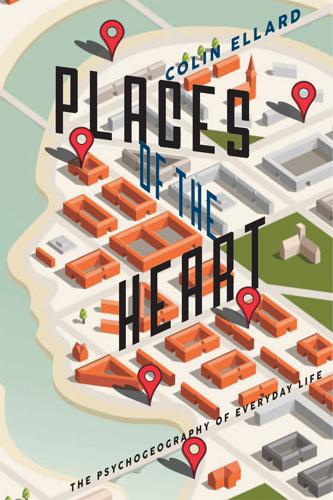
Places of the Heart: The Psychogeography of Everyday Life
by
Colin Ellard
Published 14 May 2015
Available at: http://www.newyorker.com/magazine/2011/12/19/the-sanctuary 2I’ll discuss these findings more fully in Chapter 6, Spaces of Awe, but if you’re curious now, you can look up the paper by Stanford professor Melanie Rudd and colleagues, titled “Awe Expands People’s Perception of Time, Alters Decision-Making, and Enhances Well-Being,” in Psychological Sciences, Volume 23(10), pages 1130–1136. 3In addition to his scientific publications, Antonio Damasio describes his theories and findings with admirable clarity in a series of books written for the general reader. The best exposition of the findings I have mentioned can be found in Descartes’ Error: Emotion, Reason, and the Human Brain, (Putnam Publishing, New York, 1994). 4Rizzolatti’s original account of the discovery of mirror neurons, along with much of his subsequent work, is described in the technical review paper titled “The Mirror-Neuron System” in the journal Annual Review of Neuroscience, 2004, Volume 27, pages 169–192. With Corrado Sinigaglia, he has also written an account for the general reader in Mirrors in the Brain: How Our Minds Share Actions and Emotions (Oxford University Press, UK, 2008). 5The rubber hand illusion was first reported by Botvininck and Cohen in a paper titled “Rubber Hands ‘Feel’ Touch that Eyes See,” published in Nature (1998, Volume 391, page 756).
…
Though it’s far from a new idea to suggest that places influence feelings and that feelings influence decisions, the discoveries that show a profound intermingling of thought and feeling suggest that the extent to which these influences act to change what we do and who we are has been considerably underestimated. But there’s more to the new neuroscience that suggests an even closer relationship between our inner nature and the structures and technologies that surround us. Mirror Neurons, Embodiment, and Technology Working at the University of Parma in the early part of the 1990s, neurophysiologist Giacomo Rizzolatti discovered a peculiar new kind of neuron in an area of the frontal cortex of the rhesus monkey.4 Recording from individual neurons using very fine electrodes, Rizzolatti and his team discovered that some cells fired at a high rate when the monkey reached out for a morsel of food, grasped it with its hand, and placed it in its mouth.
…
Such cells, coding for and presumably playing a role in the organization of complex types of actions, are not unusual in primate brains (including ours). What was more notable about Rizzolatti’s cells, though, was that they also fired when the monkey watched a video of another monkey completing the same action. Rizzolatti named them “mirror neurons.” At the time of their discovery, the importance of these cells seems to have been largely lost on the wider scientific audience. Indeed, Rizzolatti’s initial attempt to publish his findings in the prestigious journal Nature was met with rejection because it was felt that the discovery would not excite much interest.
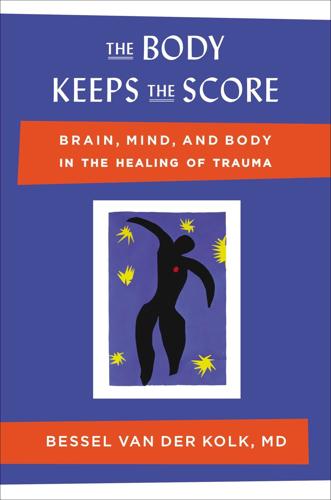
The Body Keeps the Score: Brain, Mind, and Body in the Healing of Trauma
by
Bessel van Der Kolk M. D.
Published 7 Sep 2015
Numerous other experiments followed around the world, and it soon became clear that mirror neurons explained many previously unexplainable aspects of the mind, such as empathy, imitation, synchrony, and even the development of language. One writer compared mirror neurons to “neural WiFi”9—we pick up not only another person’s movement but her emotional state and intentions as well. When people are in sync with each other, they tend to stand or sit similar ways, and their voices take on the same rhythms. But our mirror neurons also make us vulnerable to others’ negativity, so that we respond to their anger with fury or are dragged down by their depression.
…
As Edinburgh-based attachment researcher Colwyn Trevarthen says: “The brain coordinates rhythmic body movements and guides them to act in sympathy with other people’s brains. Infants hear and learn musicality from their mother’s talk, even before birth.”4 In chapter 4 I described the discovery of mirror neurons, the brain-to-brain links that give us our capacity for empathy. Mirror neurons start functioning as soon as babies are born. When researcher Andrew Meltzoff at the University of Oregon pursed his lips or stuck out his tongue at six-hour-old babies, they promptly mirrored his actions.5 (Newborns can focus their eyes only on objects within eight to twelve inches—just enough see the person who is holding them).
…
I am indebted to my late friend David Servan-Schreiber, who first made this distinction in his book The Instinct to Heal. 7. E. Goldberg, The Executive Brain: Frontal Lobes and the Civilized Mind (London, Oxford University Press, 2001). 8. G. Rizzolatti and L. Craighero “The Mirror-Neuron System,” Annual Review of Neuroscience 27 (2004): 169–92. See also M. Iacoboni, et al., “Cortical Mechanisms of Human Imitation,” Science 286, no. 5449 (1999): 2526–28; C. Keysers and V. Gazzola, “Social Neuroscience: Mirror Neurons Recorded in Humans,” Current Biology 20, no. 8 (2010): R353–54; J. Decety and P. L. Jackson, “The Functional Architecture of Human Empathy,” Behavioral and Cognitive Neuroscience Reviews 3 (2004): 71–100; M.
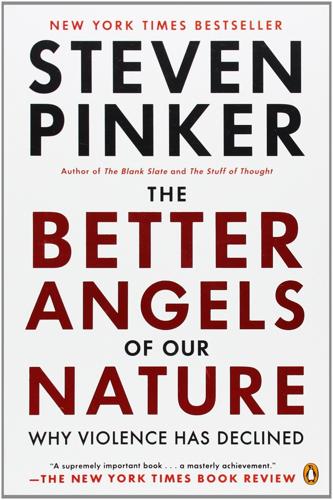
The Better Angels of Our Nature: Why Violence Has Declined
by
Steven Pinker
Published 24 Sep 2012
Though neuroscientists ordinarily can’t impale the brains of human subjects with electrodes, we have reason to believe that people have mirror neurons too: neuroimaging experiments have found areas in the parietal lobe and inferior frontal lobe that light up both when people move and when they see someone else move.18 The discovery of mirror neurons is important, though not completely unexpected: we could hardly use a verb in both the first person and the third person unless our brains were able to represent an action in the same way regardless of who performs it. But the discovery soon inflated an extraordinary bubble of hype.19 One neuroscientist claimed that mirror neurons would do for neuroscience what DNA did for biology.20 Others, aided and abetted by science journalists, have touted mirror neurons as the biological basis of language, intentionality, imitation, cultural learning, fads and fashions, sports fandom, intercessory prayer, and, of course, empathy.
…
But the discovery soon inflated an extraordinary bubble of hype.19 One neuroscientist claimed that mirror neurons would do for neuroscience what DNA did for biology.20 Others, aided and abetted by science journalists, have touted mirror neurons as the biological basis of language, intentionality, imitation, cultural learning, fads and fashions, sports fandom, intercessory prayer, and, of course, empathy. A wee problem for the mirror-neuron theory is that the animals in which the neurons were discovered, rhesus macaques, are a nasty little species with no discernible trace of empathy (or imitation, to say nothing of language).21 Another problem, as we shall see, is that mirror neurons are mostly found in regions of the brain that, according to neuroimaging studies, have little to do with empathy in the sense of sympathetic concern.22 Many cognitive neuroscientists suspect that mirror neurons may have a role in mentally representing the concept of an action, though even that is disputed.
…
Emotional contagion: Preston & de Waal, 2002. 16. Sympathy not the same as contagion: Bandura, 2002. 17. Discovery of mirror neurons: di Pellegrino, Fadiga, Fogassi, Gallese, & Rizzolatti, 1992. 18. Possible mirror neurons in humans: Iacoboni et al., 1999. 19. Mirror mania: Iacoboni, 2008; J. Lehrer, “Built to be fans,” Seed, Feb. 10, 2006, pp. 119–20; C. Buckley, “Why our hero leapt onto the tracks and we might not,” New York Times, Jan. 7, 2007; S. Vedantam, “How brain’s ‘mirrors’ aid our social understanding,” Washington Post, Sept. 25, 2006. 20. Mirror neurons as DNA: Ramachandran, 2000. 21. Nasty macaques: McCullough, 2008, p. 125. 22.
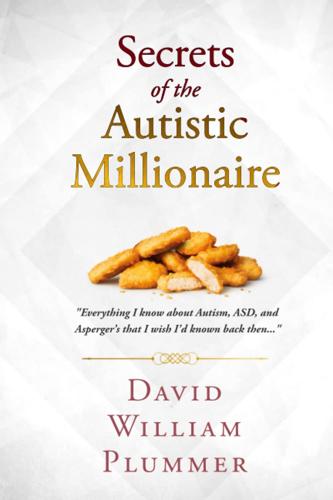
Secrets of the Autistic Millionaire: Everything I Know Now About Autism and Asperger's That I Wish I'd Known Then
by
David William Plummer
Published 14 Sep 2021
When doing nothing is not an option, then it’s up to the grace of the people who love the person with autism to not hold them accountable for that which they cannot do well, as long as they’re doing their best. Although not fully understood, it is believed that the brain contains mirror neurons. One way to think of it may be to consider your set of mirror neurons to be a crash test dummy that takes the place of the other person in a debate or debacle. These mirror neurons represent, or serve as a proxy for, the mind of the other person. In your head you talk to –– or argue with, love, or cajole –– this stand-in before addressing the real person in front of you, it’s a way of anticipating how they will react.
…
Through these mirror 149 neurons you can also try out and feel the results of what you’re going to say or do on yourself; consider it and the mirror neurons will react, and if you’re highly attuned to the other person, your mirror neuron stand-in will be a very close approximation of dealing with the other person. All of this happens largely automatically, and you simply sense or “know” what the other person is feeling. In people with autism, this mirror neuron system is markedly different and does not function as it does in neurotypical people: those with autism must mechanically process what the other person is feeling, with only past experience being the basis of predictions for how their words and reactions will be met.
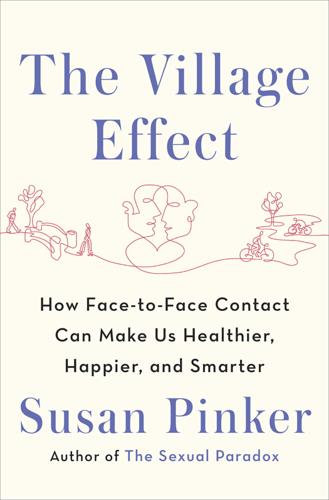
The Village Effect: How Face-To-Face Contact Can Make Us Healthier, Happier, and Smarter
by
Susan Pinker
Published 30 Sep 2013
She may be turning at the right intersections, dutifully stopping at stop signs and red lights, all the while accessing her mental road map, but, according to Wilson and Höldobler, she is “pondering neither the trip nor the operation of the automobile.”12 Like honeybees, humans respond to immediate biochemical and geographic cues that, despite being invisible, sway how they “decide” what they’ll do next. Monkey See, Monkey Do: Mirror Neurons and Mimicry That kind of automatic response is at the heart of the superorganism—an organic phenomenon created by dozens, if not hundreds, of leaderless individuals somehow acting in concert—whether in a beehive or the New York Stock Exchange. A similar lack of self-reflection characterizes one of the building blocks of human empathy: the mirror neuron system. In the late eighties, mirror neurons were discovered by two Italian neurophysiologists, Giacomo Rizzolati and Vittorio Gallese. They were investigating how the neural circuits of the pre-motor cortex register what happens before you execute a simple action, such as reaching for something you want to eat.
…
This mirroring happens even when you’re watching the action on a screen—or, rather, broadcast on your goggles—as Iacoboni discovered when he collaborated with an adman to test people’s neural reactions to Super Bowl commercials. When Iacoboni and his team projected the ads while subjects were in the scanner, their mirror neuron systems became activated. It was not so much the actors’ gestures that elicited a response, Iacoboni suggests, but the degree to which a test subject identified with the particular actor on the screen.15 Though the automatic nature of mirror neurons doesn’t account for more shaded forms of empathy, such as feeling someone’s psychological pain, the discovery of mirror neurons went a long way toward explaining many of our everyday experiences. People unconsciously use a more halting rhythm of speech when they’re chatting with someone who stutters, and adjust their posture to mirror the stance of the person they’re talking to.
…
Simply picking up a peanut or an ice cream cone elicited the same excited response in the monkey’s pre-motor cortex, even though the animal was just sitting there, watching the experimenters.14 The discovery of mirror neurons—motor cells that fire when someone else moves—added a new twist to the idea of passive observation. Here, then, was the neural hardware underlying all sorts of unconscious contagion, from the way people reflexively flinch when they see that someone is about to get smacked, to the way a tennis player’s arm tenses when he watches another athlete prepare his swing. Mirror neurons aren’t helping you imagine how it feels; they’re literally putting you through the paces. This mirroring happens even when you’re watching the action on a screen—or, rather, broadcast on your goggles—as Iacoboni discovered when he collaborated with an adman to test people’s neural reactions to Super Bowl commercials.
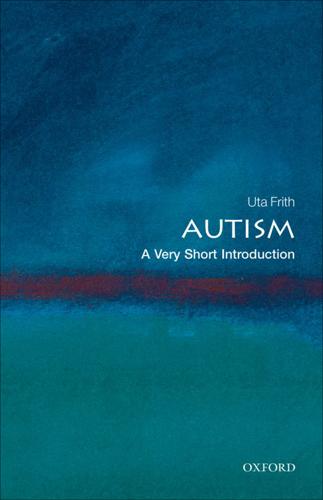
Autism: A Very Short Introduction
by
Uta Frith
Published 22 Oct 2008
When we perform the action, then the same neurons are active as when we observe the action in someone else. Therefore the mirror system makes an automatic link between seeing and doing, and it is a mechanism that enables us to understand the meaning of the action that another person performs. In other words, as far as the mirror neurons are concerned they don’t care whether it is us or another person who performs an action. But this is not all. The idea of a mirror system goes well beyond action. It is exciting to think that a similar mechanism is responsible for understanding the inner intentions and even the inner feelings of other people.
…
Children were asked to copy this. Children with ASD performed exactly the same as typically developing children. They understood the goal of the experimenter and pointed to the same chip but using their most convenient hand Based on Hamilton, A.F.d.C., Brindley, R.M., Frith, U. (2007) How valid is the mirror neuron hypothesis for autism? Neuropsychologia, 45, 1859–68 It is a relief to know that autistic children can understand goals, even when they have difficulty in understanding the more complex motivations of people’s behaviour. However, this was an example of imitation to order, not spontaneous imitation in a typical social context.
…
On impairments of social interaction Baron-Cohen, S., Tager-Flusberg, H., and Cohen, D., eds. (2000) Understanding Other Minds: Perspectives from Developmental Cognitive Neuroscience. Oxford: Oxford University Press. Dapretto, M., Davies, M. S., Pfeifer, J. J., Scott, A. A., Sigman, M., Bookheimer, S. Y. et al. (2006) Understanding emotions in others: mirror neuron dysfunction in children with autism spectrum disorders. Nature Neuroscience, 9(1): 28–30. Dawson, G., Meltzoff, A. N., Osterling, J., Rinaldi, J., and Brown, E. (1998) Children with autism fail to orient to naturally occurring social stimuli. Journal of Autism and Developmental Disorders, 28(6): 479–85.
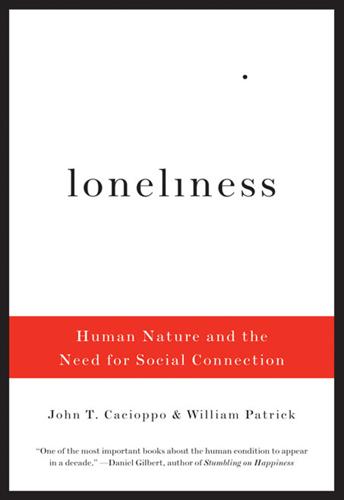
Loneliness: Human Nature and the Need for Social Connection
by
John T. Cacioppo
Published 9 Aug 2009
That is, observing actions that could reasonably be performed by humans, even when the performers were monkeys or dogs, activated the appropriate portion of the mirror neuron system in the human brain. Similarly, activation of the portion of the mirror neuron system associated with speech occurred when the participants watched humans speak. However, when they watched the oral movements that dogs and monkeys use to communicate—lip smacking and barking, methods of communication not used by humans—the mirror neuron system related to speech movements did not activate. Thus the mirror neuron system isn’t simply “monkey see, monkey do,” or even “human see, human do.” It functions to give the observing individual knowledge of the observed action from a “personal” perspective.
…
“It took us several years to believe what we were seeing,” Rizzolatti told the New York Times science writer Sandra Blakeslee.6 Rizzolatti gave these structures the name “mirror neurons.” They fire even when the critical point of the action—the person’s hand grasping the peanut, for instance—is hidden from view behind some object, provided that the monkey knows there is a peanut back there. Even simply hearing the action—a peanut shell being cracked—can trigger the response. In all these instances, it is the goal rather than the observed action itself that is being mirrored in the monkey’s neural response.7 FIGURE 11. The region in the monkey brain (F5) that Giacomo Rizzolatti and colleagues found to contain mirror neurons. To investigate similar “sense and response” mechanisms in humans, Rizzolatti examined the twitching of hand muscles.
…
Cacioppo, "Grounding social cognition: Synchronization, coordination, and co-regulation," in G. R. Semin and E. R. Smith, eds., Embodied grounding: Social, cognitive, affective, and neuroscientific approaches (New York: Cambridge University Press, in press). 8.G. Rizzolatti and L. Craighero, "The mirror-neuron system," Annual Review of Neuroscience 27 (2004): 169–192. 9.G. Buccino, F. Lui, N. Canessa, I. Patteri, G. Lagravinese, F. Benuzzi, C. A. Porro, and G. Rizzolatti, "Neural circuits involved in the recognition of actions performed by nonconspecifics: An fMRI study," Journal of Cognitive Neuroscience 16 (2004): 114–126. 10.B.
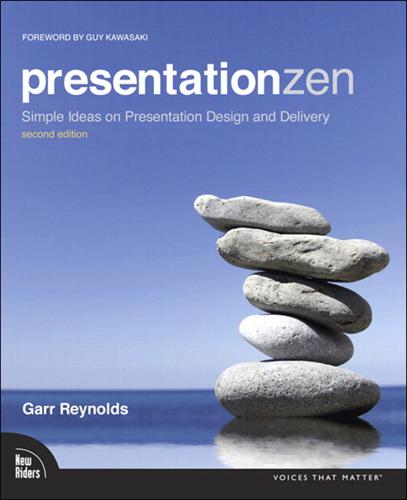
Presentation Zen
by
Garr Reynolds
Published 15 Jan 2012
Stories of experiences are vivid and visual and bring people’s emotions into your narrative. Mirror Neurons A mirror neuron in the brain fires both when you do something and when you see someone else doing the same thing, even though you have not moved. It’s almost as if you, the observer, are actually engaging in the same behavior as the person who is engaged in the action. Watching something and doing something are not the same, of course, but as far as our brains are concerned, they’re pretty darn close. Mirror neurons may be involved in empathy as well. This is a crucial survival skill. Research has shown that the same area of the brain that lights up when a person experiences an emotion also activates when that person merely sees someone else experiencing that emotion.
…
Research has shown that the same area of the brain that lights up when a person experiences an emotion also activates when that person merely sees someone else experiencing that emotion. When we see someone express passion, joy, concern, and the like, experts believe the mirror neurons send messages to the limbic region of the brain, the area associated with emotion. In a sense, then, there is a place in the brain that seems to be responsible for living in other people’s brains—that is, to feel what they are feeling. I use the two slides above in a marketing presentation to remind people to think again about what it is they are really selling.
…
Koichi, 119 Kawasaki, Guy, ix, x, 168, 244 Kennedy, John F., 79 Keynote, 11, 95, 97 Klein, Astrid, 41 Kumar, Sangeeta, 200 Landry, Chris, 196 languages, combining, 158–159 laughter, 237 Laws of Simplicity, The, 39 lecterns, 241, 264–265, 272–273, 279 left-brain thinking, 14, 20, 31 length, presentation, 248–249, 270 lighting, 276–277 Light Table view, 95, 97 limitations, working with, 39–42 live talks, 25 logos, 141 Loori, John Daido, 140 Lucas, George, 107 M-O Made to Stick, 78 Maeda, John, 39 Mann, Merlin, 208 McCloud, Scott, 125, 127 McGowan, Tara, 88 McKee, Robert, 85 McLeod, Scott, 194 meaning aptitude, 19 Medina, Dr. John, 254 meditation, 215 Meerheimb, Jasper von, 39 memory, 254 Memory and Imagination, 46 message making it stick, 78–81 presenting core, 64–66, 74 microphones, 242–243 mindfulness, 215–216 mirror neurons, 254–256 Mogi, Kenichiro, 259 moment, being in, 219, 225–228 Morgue File, 152 Moxie Software, 104–105 multimedia presentations, 9, 10, 13, 246, 267 Naked Presenter, The, 236 NASA Image Exchange, 152 naturalness, 7, 11, 25, 119, 217 negative space, 161 noise, 134, 138 Non-Designer’s Design Book, The, 133, 177 notes, presentation, 69 novelty, 237 numbers, 268.

Mind Wide Open: Your Brain and the Neuroscience of Everyday Life
by
Steven Johnson
Published 2 Jan 1999
In this book we’ll do the same thing again and again with aspects of human experience that we’ve long taken for granted, so much so that we stop noticing them. This is one of several ways in which the objectives of the arts run parallel to the lessons of brain science-in a sense, they both aim to get you outside of your head in order for you to see your head better. 20. “mirror neurons”: See V. S. Ramachandran’s fascinating overview of mirror neurons and their evolutionary significance, “Mirror Neurons and Imitation Learning as the Driving Force Behind ‘the Great Leap Forward’ in Human Evolution,” archived at www.edge.org/documents/archive/edge69.html. 21. “origins of language”: Rizzolatti and Arbib, 1998. 22. “deaf-blind children”: Wilson, 153. 23.
…
But to understand these consequences, you have to stop taking the internal duet for granted. You have to slow it down, explore its underlying processes, recognize the duet for the marvel that it is. Our growing appreciation for the art of mindreading was accelerated in the late 1990s by the discovery of “mirror neurons” in the brains of monkeys, neurons that fire both when a monkey does a particular task-grabbing a branch, for example-and when the monkey sees another monkey do that same task, suggesting that the brain is designed to draw analogies between our own mental and physical states and those of other individuals.
…
At the same time, researchers explored the premise that autistic people suffer from a kind of mindblindness, preventing them from building hypotheses about others’ internal monologues. In related studies, evolutionary psychologists began to think about the Darwinian rewards of mindreading in a social species, examining chimp populations for signs of comparable internal duets. Yet other scientists speculated on the connection between mirror neurons and the origins of language, since all forms of communication presuppose a working model of the object you’re attempting to communicate with. For language to evolve, humans needed a viable theory about the minds of other people-otherwise, they’d just be talking to themselves. Let’s now go back to that silent duet at the office party, to the moment that half-concealed grin leaks out of the side of your mouth before you can replace it with the look of sympathy.
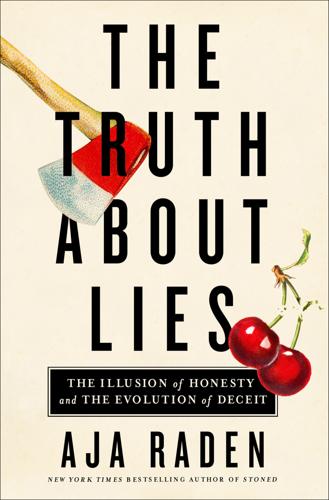
The Truth About Lies: The Illusion of Honesty and the Evolution of Deceit
by
Aja Raden
Published 10 May 2021
For example, there’s the mirroring effect.9 Mirroring is the behavior in which one person unconsciously imitates the gesture, posture, or subtle movements of another. Specialized cells in your brain called mirror neurons cause you to mimic the movements, visual cues, and expressions of whomever you’re interacting with. This tendency is more or less pronounced, depending on the individual and the extent to which they’ve developed those neurons, but we all do it, because we all have those mirror neurons. People who are extremely socially awkward are so, in part, because they have a particularly hard time with unconscious mirroring. Someone smiles, you smile back.
…
Someone smiles, you smile back. Someone looks up suddenly, you look up too. You assume these are conscious choices, but they’re not. They are a direct result of functioning mirror neurons creating something known as the Gauchais effect. When employed consciously and deliberately, the Gauchais effect is an incredibly effective way to make people look (or not look) at what you want them to look at, when you want them to look.* As a famous magician put it: “If you are given a choice, you will believe you have acted freely. This is one of the darkest of all psychological secrets.”10 There’s a simple magic trick done with a rubber ball that demonstrates all these tendencies.
…
See also disbelief Big Lie absurdity and cognitive dissonance and lie conflicting faith relationship with general, in truth and lies lies told to change theory of mind on belief about Big Lie Alaska telegraph wire deception authority bias in belief and absurdity in Brooklyn Bridge sale honesty bias in Lustig Eiffel Tower sale of MacGregor natural born liars selective reality of selling thin air con shared objective reality and theory of mind and disbelief in Bitcoin blindness change inattentional Bolívar, Simón Boxer Rebellion brain CNS mirror neurons visual cortex in Bre-X mining company Brooklyn Bridge sale, as Big Lie Brown, Sherrill Catholic relics, Forgery of cat’s out of the bag con CDS. See credit-default swap central nervous system (CNS) regulating drugs Chabris, Christopher change blindness Change Raising con Chaplin, Charlie Chaudron, Yves Chinese Great Wall Hoax Chinese traditional snake oil medicine CNS.
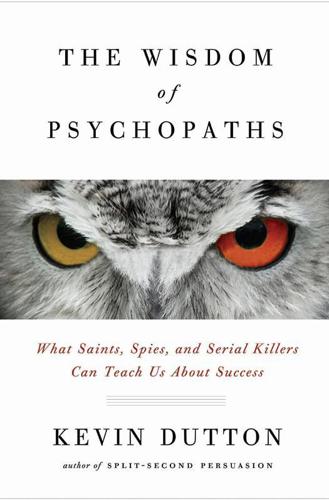
The Wisdom of Psychopaths: What Saints, Spies, and Serial Killers Can Teach Us About Success
by
Kevin Dutton
Published 15 Oct 2012
Woodworth, and Stephen Porter, “Hungry Like the Wolf: A Word-Pattern Analysis of the Language of Psychopaths,” Legal and Criminological Psychology (2011), doi:10.1111/j.2044-8333.2011.02025.x. 21 Fecteau and her coworkers used TMS to stimulate the somatosensory cortex … See Shirley Fecteau, Alvaro Pascual-Leone, and Hugo Théoret, “Psychopathy and the Mirror Neuron System: Preliminary Findings from a Non-Incarcerated Sample,” Psychiatry Research 160, no. 2 (2008): 137–44. 22 … the work of highly specialized, and aptly named, brain structures called mirror neurons … Mirror neurons were first discovered (in monkeys) in 1992 by an Italian research team led by Giacomo Rizzolatti, at the University of Parma. Put simply, they are brain cells specifically equipped to mimic the actions—and feelings—of others.
…
Previous research has shown that observing something painful happening to someone else results in a temporary slowdown in neural excitation in response to TMS, in the area of the somatosensory cortex corresponding to the region afflicted by the pain: the work of highly specialized, and aptly named, brain structures called mirror neurons. If psychopaths lack the ability to empathize, Fecteau surmised, then such attenuation in neural response should be reduced in those individuals scoring high on the PPI, compared to those with low to average scores—in exactly the same way that psychopaths might well, in comparison with most normal members of the population, display reduced yawn contagion.9 The researchers, however, were in for quite a surprise.
…
Mem Mahmut, for instance, showed us that under some sets of circumstances, psychopaths, in fact, seem to be more empathic than the rest of us. Or more helpful, at any rate. Then, if you recall, there was the study by Shirley Fecteau and her colleagues, which showed that psychopaths appear to have more going on in their mirror neuron systems, particularly the neurons in the somatosensory areas of their brains—the ones that allow us to identify with others when they’re in physical pain—than non-psychopaths. Whether it’s the case that some psychopaths have more empathy than others, or that some are better able to switch it on and off than others, or that some are simply better at faking it than others, is, at present, unknown.

SuperBetter: The Power of Living Gamefully
by
Jane McGonigal
Published 14 Sep 2015
This study suggests it can, and that it’s an effective shortcut to boost self-efficacy. The Stanford researchers theorize that the virtual doppelgängers create a “mirror neuron effect.”22 (As you’ll recall from Chapter 2, our mirror neurons mimic the neural activity of people around us, particularly when we are doing the same activity or feel closely connected to them.) Because participants felt more closely connected to avatars that looked just like them, the mirror neuron effect was stronger. It’s quite an astonishing finding—we can create mirror neurons not just with other people but with virtual people as well! On the heels of this promising study, the same lab decided to try to create an even more effective exercise booster.
…
QUEST 9: The Power of a Good Sync If you want to strengthen your mind-and-body connection to friends and family, all it takes is a good sync. What to do: Take one or two minutes out of your day to coordinate your actions as closely as possible with another person. These simple methods work to stimulate mirror neurons and synchronize heart and breathing rates: Take a walk around the block together, and match your stride as closely as possible, in both rhythm and length. Listen to a song together—everyone taps their fingers or claps their hands to the beat. Learn a simple dance routine, and perform it together.
…
These are powerful abilities you can use in any social environment, inside and outside of games. MISSION COMPLETE Skills Unlocked: How to Discover New Allies and Strengthen Your Support System To neurologically sync up with someone, play a game together, competitively or cooperatively, in the same physical space. This will activate your mirror neurons, which strengthens your social bonds and increases your social intelligence. As often as possible, make time with friends and family for other kinds of synchronizing activity. Anything that naturally leads to physical mirroring, such as walking together, or that requires significant coordination, such as tossing a ball back and forth, will do the trick.
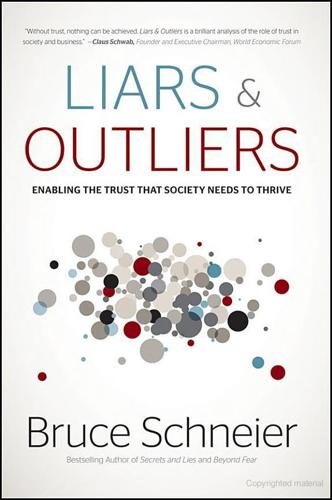
Liars and Outliers: How Security Holds Society Together
by
Bruce Schneier
Published 14 Feb 2012
Of course—and this is important to remember—these are typical results, and there is a wide variety of behavior among individual people.23 This matches our experience in the world. Neuroscience may also help explain altruism, most recently using mirror neurons. These are neurons in our brain that fire both when we perform an action24 and when we observe someone else performing the same action. First discovered in 1992, mirror neurons are theorized to be critical in imitation and learning, language acquisition, developing a theory of mind, empathy, and a variety of other prosocial behaviors. Additionally, a large body of neuroscience research supports the notion that we are altruistic innately, even if we receive no direct benefit, because at a deep level we want to be.
…
Lundberg (2011), “Rising Up to Higher Virtues: Experiencing Elevated Physical Heights Uplifts Prosocial Actions,” Journal of Experimental & Social Psychology, 47:472–6. mirror neurons Giuseppe di Pellegrino, Luciano Fadiga, Leonardo Fogassi, Vittorio Gallese, and Giacomo Rizzolati (1992), “Understanding Motor Events: A Neurophysiological Study,” Experimental Brain Research, 91:176–80. Vittorio Gallese, Luciano Fadiga, Leonardo Fogassi, and Giacomo Rizzolatti (1996), “Action Recognition in the Premotor Cortex,” Brain, 119:593–609. Vittorio Gallese and Alvin Goldman (1998), “Mirror Neurons and the Simulation Theory of Mind-Reading,” Trends in Cognitive Sciences, 2:493–501. altruistic innately Ernst Fehr and Simon Gächter (2002), “Altruistic Punishment in Humans,” Nature, 415:137–40.
…
Knetsch, and Richard H Thaler (1986), “Fairness and the Assumptions of Economics,” Journal of Business, 59:S285–S300. who are skeptical Ilan Dinstein, Cibu Thomas, Marlene Behrmann, and David J. Heeger (2008), “A Mirror Up to Nature,” Current Biology, 18:R13–8. Kaspar Meyer and Antonio Damasio (2008), “Mirror Neurons: Behind the Looking Glass,” Nature, 454:167–8. Gregory Hickok (2009), “Eight Problems for the Mirror Neuron Theory of Action Understanding in Monkeys and Humans,” Cognitive Neurosciences, 21:1229–43. prototype effect Eleanor Rosch (1975), “Cognitive Representation of Semantic Categories,” Journal of Experimental Psychology, 104:192–233. George Lakoff (1987), Women, Fire and Dangerous Things: What Categories Reveal About the Mind, University of Chicago Press.

Adaptive Markets: Financial Evolution at the Speed of Thought
by
Andrew W. Lo
Published 3 Apr 2017
In fact, Rizzolatti’s discovery was so out of left field that the prestigious scientific journal Nature declined to publish his manuscript because its editors believed it lacked “general interest.”14 This rejection notwithstanding, in a short time Rizzolatti and his team detected mirror neurons in humans as well, using the neuroimaging technique of PET scans. Like our evolutionary cousins, we humans have neurons that activate when we observe the actions of others, allowing us to experience the actions of others in a direct way. The phrase “I feel your pain” is more literal than we imagined. As we’ve seen, neuroscientists often determine the function of parts of the brain by studying the behavior of individuals in whom such parts are damaged. In the case of mirror neurons, this approach was reversed. We know what the mirror neurons do, but we don’t yet know how they affect behavior.
…
Because of this commonality, we can conclude that evolution of the neuron dates to before these species went on their different evolutionary paths, deep in the primeval past. But a specific structure like the mirror neuron—which automatically “lights up” in sympathy to the actions of others—is only found in our relatively close cousins, the primates, and as far as we know, nowhere else in the animal kingdom. By evolutionary reasoning, therefore, the mirror neuron must have evolved much more recently, as a specific innovation of the primates. As a result, evolution allows us to see how our behaviors developed through time. For example, the neurological structures of fear appear to be hundreds of millions of years old.
…
For instance, a certain neuron in the premotor cortex would fire when a macaque grasped an object, but this same neuron also fired when the macaque witnessed a human experimenter grasping an object. This was direct physical evidence that the macaque could understand the actions of others in terms of its own experience, even across species. In short, the macaque had a basic “theory of mind” hardwired into its brain. This discovery of “mirror neurons” was entirely unexpected. While some neuroscientists had jokingly spoken of “grandmother neurons,” neurons that would fire when individuals saw their grandmothers, no neurologist expected a specific structure in the brain that mirrored the behavior of others in terms of one’s own physical actions.

The Spirit Level: Why Greater Equality Makes Societies Stronger
by
Richard Wilkinson
and
Kate Pickett
Published 1 Jan 2009
An important part of the reason why countries such as Sweden, Finland and Norway score well on the UNICEF index of child wellbeing is that their welfare systems have kept rates of relative poverty low among families. MIRROR NEURONS AND EMPATHY To view the pursuit of greater equality as a process of shoe-horning societies into an uncomfortably tight-fitting shoe reflects a failure to recognize our human social potential. If we understood our social needs and susceptibilities we would see that a less unequal society causes dramatically lower rates of ill-health and social problems because it provides us with a better-fitting shoe. Mirror neurons are a striking example of how our biology establishes us as deeply social beings. When we watch someone doing something, mirror neurons in our brains fire as if to produce the same actions.338 The system is likely to have developed to serve learning by imitation.
…
Part of the same picture is the social pain which sometimes triggers violence (Chapter 10) when people feel they are put down, humiliated or suffer loss of face. For a species which thrives on friendship and enjoys co-operation and trust, which has a strong sense of fairness, which is equipped with mirror neurons allowing us to learn our way of life through a process of identification, it is clear that social structures which create relationships based on inequality, inferiority and social exclusion must inflict a great deal of social pain. In this light we can perhaps begin not only to see why more unequal societies are so socially dysfunctional but, through that, perhaps also to feel more confident that a more humane society may be a great deal more practical than the highly unequal ones in which so many of us live now. 15 Equality and sustainability The one who dies with most toys wins.
…
Sharma, J. R. Seckl, S. Dymov, M. Szyf and M. J. Meaney, ‘Epigenetic programming by maternal behaviour’, Nature Neuroscience (2004) 7: 847–54. 337. S. Morris, ‘Women laughed as they forced toddlers to take part in “dog fight”’, Guardian, 21 April 2007. 338. G. Rizzolatti and L. Craighero, ‘The mirror-neuron system’, Annual Review of Neuroscience (2004) 27: 169–72. 339. M. Kosfeld, M. Heinrichs, P. J. Zak, U. Fischbacher and E. Fehr, ‘Oxytocin increases trust in humans’, Nature (2005) 435: 673–6. 340. P. J. Zak, R. Kurzban and W. Matzner, ‘The neurobiology of trust’, Annals of the New York Academy of Sciences (2004) 1032: 224–7. 341.
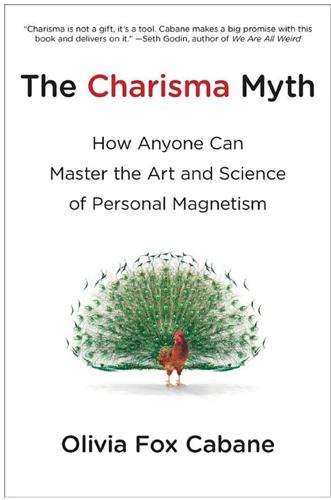
The Charisma Myth: How Anyone Can Master the Art and Science of Personal Magnetism
by
Olivia Fox Cabane
Published 1 Mar 2012
As a leader, the emotions conveyed by your body language, even during brief, casual encounters, can have a ripple effect through your team or even your entire company. This ripple effect is due to the mirror neurons in our brain, whose job it is to replicate or mirror in our own mind the emotions we observe in someone else. When we detect someone else’s emotions through their behaviors or facial expressions, our mirror neurons reproduce these emotions. This is what makes empathy possible. I’m often called in by leaders with strong personalities who already have powerful charisma and need to learn how to manage their emotional contagion.
…
I’m often called in by leaders with strong personalities who already have powerful charisma and need to learn how to manage their emotional contagion. We analyze what impact they’re having on whom, and then give them the skills to control it at will. Let’s imagine that you interact with someone while in an anxious emotional state. As they read your body language, their mirror neurons fire up, mirroring that state. They go on to meet someone else, replicating the process—and your emotional state spreads. Emotional contagion “triggers arousal in others, in a sort of chain reaction.”2 Within organizations, leaders’ emotions always propagate fastest because people are strongly affected by those in a position of power (we can thank our survival instincts for this, too).
…
You can do this in two ways: Verbally: Encourage positive mental associations. For example, mention something they’ve done well in the past or something in this situation that you approve of. Nonverbally: Use your body language to influence theirs. Get back into a state of goodwill so that it plays out across your face. The mirror neurons in their brain will replicate the emotions they’re seeing in you, putting them in a more positive state of mind as well. When closing the conversation, if you can, aim to end on a positive note. Remember how important beginnings and endings are—they can color the whole interaction. This is when you can put the emphasis on three important points: Next steps: Review the steps that will be taken to improve the situation, particularly if you’re going to do any of it together.
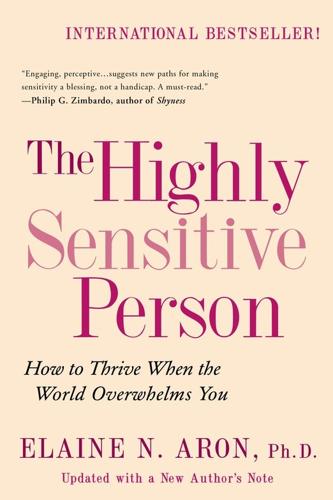
The Highly Sensitive Person: How to Thrive When the World Overwhelms You
by
Elaine N. Aron
Published 1 Dec 2013
In another study by Bianca Acevedo, sensitive and nonsensitive persons looked at photos of both strangers and loved ones expressing happiness, sadness, or a neutral feeling. In all situations, when there was emotion in the photo, sensitive persons showed increased activation in the insula but also more activity in their mirror neuron system, especially when looking at the happy faces of loved ones. The brain’s mirror neurons were only discovered in the last twenty years or so. When we watch someone else do something or feel something, this clump of neurons fires in the same way as some of the neurons in the person we are observing. As an example, the same neurons fire, to varying degrees, whether we are kicking a soccer ball, see someone else kicking a soccer ball, hear the sound of someone kicking a soccer ball, or hear or say the word “kick.”
…
. & Belsky, J., Vantage Sensitivity: Individual differences in response to positive experiences, Psychological Bulletin, in press. p. xx In another study, by Bianca Acevedo: Acevedo, B., Aron, A., & Aron, E. (2010). Association of sensory processing sensitivity when perceiving positive and negative emotional states. Presented at APA, San Diego. p. xx The brain’s mirror neurons For a more complete understanding of mirror neurons, see M. lacoboni, Mirroring People: The New Science of How We Connect with Others (New York: Farrar, Straus, and Giroux, 2008). p. xx Roy Baumeister and his colleagues: Baumeister, F. R., Vohs, D. K., DeWall, N. C.,& Zhang, L. (2007). How emotion shapes behavior: Feedback, anticipation, and reflection, rather than direct causation.
…
Not only do these amazing neurons help us learn through imitation, but in conjunction with the other areas of the brain that were especially active for HSPs, they help us know others’ intentions and how they feel. Hence they are largely responsible for the universal human capacity for empathy. We do not just have an idea of how someone else feels; we actually feel that way ourselves to some extent. This is very familiar to sensitive people. Anyone’s sad face tended to generate more activity in these mirror neurons in HSPs than others. When seeing photos of their loved ones being unhappy, sensitive persons also showed more activation in areas suggesting they wanted to do something, to act, even more than in areas involving empathy (perhaps we learn to cool down our intense empathy in order to help). But overall, brain activation indicating empathy was stronger in HSPs than non-HSPs when looking at photos of faces showing strong emotion of any type.

What About Me?: The Struggle for Identity in a Market-Based Society
by
Paul Verhaeghe
Published 26 Mar 2014
Not for nothing is separation anxiety, the fear that the other person will abandon us, our oldest fear, just as the oldest punishment is to be banished from the group, to be put in the corner with one’s back to the others — the didactic precursor of banishment. [* If you pull a face at a baby there’s a good chance that it will copy you. This is down to the recently discovered mirror neurons in our brains, which equip us to imitate the behaviour or, more broadly, the thinking of others. A baby is a sponge that absorbs all the information provided by its parents, and mirror neurons have a big role to play in this process.] [** ‘Marking’, the exaggerated way in which mothers, especially, communicate with babies using mirroring facial expressions, has a clear function: it allows babies to distinguish between what the mother is feeling herself, ‘I am not unhappy’ (no marking), and the feelings that she suspects her child has, ‘You are unhappy’ (marking).]
…
Differences can then largely be attributed to the culture in question.] Identity has more to do with becoming than with being, and it’s a process that starts right from birth. All over the world it follows the same pattern, pointing to a genetic basis. It used to be called identification; since the discovery of mirror neurons, the preferred term is ‘mirroring’.* The earliest stages of this process are plain: a baby cries because of its wet nappy, and, as if by magic, Mummy appears. She makes comforting noises and asks, ‘Do you need a clean nappy then?’ She talks to the baby in a special, high-pitched voice, and exaggerates her facial expressions.** The importance of this simple interaction, repeated in a hundred different ways, is enormous.
…
Studies show that the brain is far from ‘finished’ at birth; it still needs to develop in many ways, with environmental factors playing a decisive role in this process. If we apply this to psychological identity, it seems logical that the brain structures which are largely in place at birth (the hardware) determine the process whereby our identity (the software) is built up. Without mirror neurons, identification can’t take place, but what is mirrored depends on our environment. Moreover, that environment has a very demonstrable effect on the physical development of the brain, which goes on for years after birth. Your brain is important for your identity, but its content is provided by the outside world.

The Master and His Emissary: The Divided Brain and the Making of the Western World
by
Iain McGilchrist
Published 8 Oct 2012
Those without capacity for theory of mind indicate the new box where they know the marble to be, not the original one where Sally last saw it placed.205 The right hemisphere has by far the preponderance of emotional understanding.206 It is the mediator of social behaviour.207 In the absence of the right hemisphere, the left hemisphere is unconcerned about others and their feelings: ‘social intercourse is conducted with a blanket disregard for the feelings, wishes, needs and expectations of others.’208 Patients with right frontal deficits, but not left frontal deficits, suffer a change of personality whereby they become incapable of empathy.209 Considerable interest has been raised by the discovery that there are neurones, nicknamed ‘mirror neurones’, which are active both when we do something and when we watch others do it.210 Physiological and behavioural evidence indicated that the left pars opercularis (part of Broca’s area), the area of the frontal lobe critical for speech production, contains mirror neurones which are involved in the imitation of finger movements.211 So absorbing was this finding – which is indeed highly significant, and which I will discuss in the next chapter – that it was until recently thought that mirror neurones were a speciality of the human left hemisphere, and their existence has even been put forward as a reason for language’s having developed in the left hemisphere, rather than the right.212 But that seems a bit like putting the cart before the horse, especially since both the left and right pars opercularis equally have mirror neurones, and both hemispheres contribute to the processing of watching and imitating.213 In fact, which hemisphere is involved on any one occasion has not only to do with what and where the action is that we are copying, but also with how instrumental (‘object-directed’) that action is.
…
Those without capacity for theory of mind indicate the new box where they know the marble to be, not the original one where Sally last saw it placed.205 The right hemisphere has by far the preponderance of emotional understanding.206 It is the mediator of social behaviour.207 In the absence of the right hemisphere, the left hemisphere is unconcerned about others and their feelings: ‘social intercourse is conducted with a blanket disregard for the feelings, wishes, needs and expectations of others.’208 Patients with right frontal deficits, but not left frontal deficits, suffer a change of personality whereby they become incapable of empathy.209 Considerable interest has been raised by the discovery that there are neurones, nicknamed ‘mirror neurones’, which are active both when we do something and when we watch others do it.210 Physiological and behavioural evidence indicated that the left pars opercularis (part of Broca’s area), the area of the frontal lobe critical for speech production, contains mirror neurones which are involved in the imitation of finger movements.211 So absorbing was this finding – which is indeed highly significant, and which I will discuss in the next chapter – that it was until recently thought that mirror neurones were a speciality of the human left hemisphere, and their existence has even been put forward as a reason for language’s having developed in the left hemisphere, rather than the right.212 But that seems a bit like putting the cart before the horse, especially since both the left and right pars opercularis equally have mirror neurones, and both hemispheres contribute to the processing of watching and imitating.213 In fact, which hemisphere is involved on any one occasion has not only to do with what and where the action is that we are copying, but also with how instrumental (‘object-directed’) that action is. Such actions excite the left hemisphere’s system. On the other hand, the predominant contribution to the imitation of actions that are non-instrumental comes from the right temporal and frontal lobes.214 Mirror neurones are a means of understanding another’s intentions, amongst other things, and are not just about copying actions.215 They form part of our capacity to understand others and empathise with them.
…
It is just one particular way of looking at things, a way which privileges detachment, a lack of commitment of the viewer to the object viewed. For some purposes this can be undeniably useful. But its use in such causes does not make it truer or more real, closer to the nature of things. Attention also changes who we are, we who are doing the attending. Our knowledge of neurobiology (for example, of mirror neurones and their function, which I will touch on later) and of neuropsychology (for example, from experiments in association-priming, which again we will have time to consider in due course) shows that by attending to someone else performing an action, and even by thinking about them doing so – even, in fact, by thinking about certain sorts of people at all – we become objectively, measurably, more like them, in how we behave, think and feel.
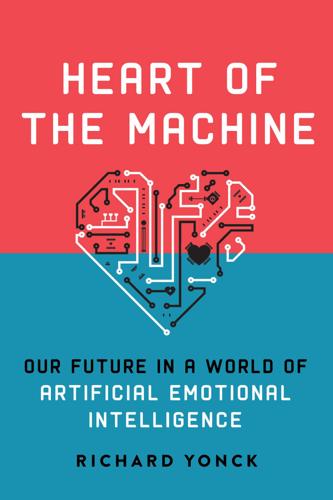
Heart of the Machine: Our Future in a World of Artificial Emotional Intelligence
by
Richard Yonck
Published 7 Mar 2017
Evidence of specific neurons that perform this mirroring were first reported in the early 1990s when researchers studying the premotor cortex of macaque monkeys realized that the same neurons that fired when a monkey performed an action also fired when that monkey observed that same action in another.28 In other words, action and observation supposedly triggered the same neurons.29 This was considered a huge revelation because it supposedly answered many previously unanswered questions about human psychology. Further studies indicated these mirror neurons existed in several primates, including humans, but many other studies challenged the idea as well. Though very popular, there’s still considerable dispute over the validity of the idea of discrete mirror neurons, from their actual existence to their implications for autism, self-awareness, yawning, and much more. Debate continues over whether mirroring activity is actually the result of a distinct class of neurons, a more general response by the overall network, or a chaining of learned associations between visual and motor commands.
…
Based on our other experiences with the uncanny valley, this will be an enormous challenge, though one we should eventually be able to meet. Interpreting and expressing emotions is a complex skill we seem to mostly acquire in our very earliest years. As we grow older, these channels of communication are honed and refined through enculturation, conscious effort, and perhaps even mirror neurons. Like our other primary channel of communication, spoken language, the majority of our mastery of reading and conveying emotions comes to us early in life. As a result, by the time we are adolescents, we seem to know almost innately what are acceptable or unacceptable emotions for any given moment.
…
In considering the possible origins of both forms of empathy, it seems more likely that emotional empathy preceded cognitive empathy. In fact, without emotional empathy existing first, it’s challenging to see how theory of mind and self-awareness could have come about at all. The mechanisms for emotional empathy have been speculated on by many others. Emotional contagion, mirror neurons, and pheromones may all be involved. But I can’t help think back to Manfred Clynes’s sentograph and discussions with Beyond Verbal’s Yoram Levanon regarding the idea that emotions may be transmitted through the unique vibrations in human touch and sound.3 In this, a resonance is created between sender and receiver that is perceived somatically by the recipient, allowing for the sharing of a particular emotional state.
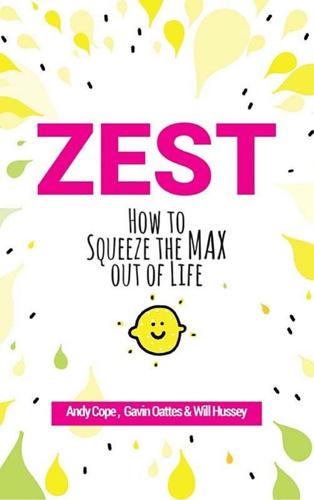
Zest: How to Squeeze the Max Out of Life
by
Andy Cope
,
Gavin Oattes
and
Will Hussey
Published 19 Jul 2019
The openness of your emotional system, the fact that we’re hard-wired to catch other people’s feelings, means that we create one another. Let me say that again, so it sinks in a bit better − your emotions not only affect you and the chemical composition of your body, they also transmit to those around you, creating that person in that moment. It works via mirror neurons which means we’re compelled to copy others’ emotions and behaviours. These mirror neurons allow contagion, letting the feelings we witness flow through us, thus helping us get in synch with the person feeling the emotion. This ability to ‘feel’ with and for them is the basis of empathy. It’s a super-sophisticated form of subconscious communication.
…
You can check Will out at www.artofbrilliance.co.uk or you can tweet him at @aobrillwill Index ABCDE exercise 189, 190–1, 205 Adams, Tony 216 addiction 118 adversity 189, 190 advertisement 111 aggression 88 alive time 215 aliveness 173–4 Allingham, Henry 216 allodoxaphobia 103 altruism 209 Amazon 28 anger 69, 167 angst 70 animation 65, 66 anxiety 30, 63, 83, 86, 87 Ardagh, Philip 75 Ardagh Tips 56 attachment theory 114 attention 111, 112 attitude 153, 165 can-do 72 awareness 195 Balboa, Rocky 177 belief 189, 191 Beschaulich 25 body 54–6 boogie woogie 127 bothered, being 71–2, 169 Bowie, David 44 brain 101–2 evolution of 148 fuel 148 healthy 218–20 brain injury 133 breathing 197–9, 205 Brilliant, Ashleigh 201 BROMO 115, 116 busyness 38–9, 40 Call the Midwife 77 can-do attitudes 72 Calment, Jeanne 216 capitalism 111 carers 132–6 caring profession 136 Carlson, Mary 137 celebration 67–8, 131 change, willingness to 173 children 45, 67–8 Christakis, Nicholas A. 96 clickbait 69 Cliff, Jimmy 26–7 Cognitive Behavioural Therapy 190 commitment 163–9 comparison 104–7 compassion fatigue 135 compound interest 150–1 compulsive gambling 118 confidence 61, 62 conflict 118 connectedness 108 consequence 189, 191 consumption 42 content of experience 195 contentment 42 counselling 177 Crawford, Matthew 111 creativity 158 daily challenges 58–9 Dali, Salvador 220 dead time 215 Dean, James 128 depression 30, 62, 83, 88 as self-reinforcing cycle 132 depressive episode 88 Deresiewicz, William 106, 122 despair 167 destination addiction 92 Diagnostic and Statistical Manual of Mental Disorders 5th Edn (DSM5) 63 digital detox 117–21 Dillard, Annie 107 disconnectedness 108 dispute, learning to 189, 191–2 Dryden, Dr Windy 105 education level 84 effort 163, 167 ego 194–7 emotional contagion 94–7 emotional soup 96 emotional spillage 96 emotional tolerance levels, normal 88 empathy 147 employee weaknesses 162 emptiness 40, 42, 88 energization 190, 192 enthusiasm 72 envy 104–7, 121 ethnicity 84 eudaimonia 166, 167, 209 euthymia 168 exercise 155 Exorcist, The 195 explanatory style 187–8 Facebook 39, 108–9 FaceTube 39, 128 failure 175 fake news 69 family extended 217 well-being, emotion and 96–7 Feynman, Richard 55 Field, Tiffany 137 flow 9 FOJI (Fear of Joining In)116 FOMO (Fear of Missing Out) 114, 115, 116 food 83, 211 forgetfulness 71 forgiveness 185–7, 204 Fosbury, Dick 81 Fowler, James H. 96 Freud, Sigmund 193 fun 193, 205 gender 84 Gibran, Khalil 20, 121 Gilbert, Dan 101–2 goals 168 Gogglebox 39 Goggling 37–42 Goleman, Daniel 95, 96 good news 68–71 Googling 37–42 gratitude 66 Griffiths, Mark 114 grudges 186 grumbling 61, 185, 186 grumpiness 86 habit 150–2 happiness 62, 72 50/10/40 ratio 83–5 for no reason 209 hacks 210–11 as in-sperience 90–1 instant 166, 167 moment 131–2, 202 sacrificing 166 search for 42, 92–3 as self-reinforcing cycle 132 spectrum 150 thermostat 94 Happiness Pie 83–5 hara hachi bu 217 hard knocks 28–31 Harlow, Harry 137 hate 56–8 haters 56–8 healing 80 health 84 hedonic treadmill 166 hedonism 166, 209 Hicks, Bill 173 Hodgson, Roger 215–16 hope 72, 152–4 House, Oriah, Mountain Dreamer (Invitation, The) 13–16 hugs 137–8 humour, lack of 34 identity 194 of ego 195, 197 illusory self 194 imagination 149 immersion mode 9 imperfections 184 imposter syndrome 36 improvised comedy 129 income 84 individuality 224 inflammation 70 initials, using middle 26 inner strength 75 in-sperience 86–91 Instagram 112, 114, 115, 116, 139 internet addiction 118 irritability 88 Jake, Adventure Time 210 Jamie and the Magic Torch 169 Japan, longevity in 216–17 JOMO (Joy of Missing Out) 116, 117 kalsarikänni see pantsdrunk Katie, Byron 130 Kerouac, Jack: On the Road 53 keystone habits 150, 152, 169 Kim Ki Joon, Dr 114 kindness 57–8 random acts of 57 King, Martin Luther 178, 179 Kington, Miles 218 Kintsugi 183–5, 204 Knopfler, Mark 89 Knudstorp, Jorgen Vig 158 Kool 53 Krishnamurti, Jiddu 196 Lamott, Anne 221 Larson, Gary 104 learned helplessness 154 learning 56 life expectancy 32–3, 216 life satisfaction 167 lifestyle 84 Lightman, Alan 117–18 Logical Song, The 215 London, Jack 223 loneliness 30, 88, 156 longevity league table 216–17 Lucretius 105 mania 88 Manson, Mark 187 marital status 84 Marsh, Nigel 41 materialism 41–2, 105, 197 Mbuki-mvuki 127 mediocrity 88, 165 memories 202 mental illness 62–3 statistics 80 metanoia 80, 81, 82 mindfulness 201, 202 mirror neurons 95 misery 86 modernity 29 MOMO (Mystery of Missing Out) 115 money 42 mood 154 changes 118 morosity 34 motivations 168 Nagasaki, Kendo 194 names 26 meaning of 179–81 Neanderthals 147, 148 negative emotions 70 negativity 61, 62, 69, 72, 165 neocortex 147, 149 neuroplasticity 149 news fake 69 good 68–71 unbiased 70 nexting 102 niceness 57 Nietzsche, Friedrich 138 nightmares 61 NLP 47, 56 nomophobia 113, 114 Normal, being 34–5 normality 177, 204 now, living in the 68, 199–203 Obama, Michelle 57 obesity 155, 156 Oedipus Complex 193 Ogling 37–42 Opening Night Principle 130 openness 95 optimism 72, 83, 152–4, 190 realistic 26 optimistic explanatory style 188, 190 overimagining 149 overthinking 149 Paddington Bear 46 pain 167 panic attacks 30, 63, 87 Palahniuk, Chuck 55 panicking about the future 149 pantsdrunk 139–41 paramedics 136 para-sympathetic arousal 95 passion, finding 158–60 peer review 79 performance review 162 personal development 158 personal responsibility 61 personality 224 pessimism 33 pessimistic explanatory style 188 phobias 103–4 phone separation anxiety 113 physical appearance 84 physical labour 28–9, 30 play 45–7, 225 playground 45 playtime 46–7 Poe, Edgar Allan 155 Poole, Mary 223 positive emotion 70 positive psychology 82, 88, 91, 150, 175 positivity 62, 72, 97 training in 165 post-traumatic growth 178 potential 163 Powell, Richard 184 pratfall effect 138 Pretoogjes 224 procrastination 211 psychological rebuilding 80 random acts of kindness 57 rationalization 147 realistic optimism 154 re-animation 65 regret 225 relapse 118 relationships, investment in 155–7 relaxation 140 remembering 71 retirement 222 Richards, Keith 215 Rogan, Joe 139 roles, social 29 Rose, Axl 174 rumination 149 Schwartz, Kenneth 136 sea squirts 37–8 seeing clearly 26–7 self-awareness 55 self-envy 106 self-harm 30 self-reinforcing cycle 132 Seligman, Professor Marty 189 separation anxiety 113, 114 set point 94 sex drive 88 sharing etiquette 120 sidekick 178–83, 204 silence 112 Simon, Paul 63 skeletons of the past 203–4, 205 skills 165 sleep 160–1 sleep hygiene 160 SLOMO (Slow to Miss Out) 116 small habits 150 smartphone 113–14 detoxing 119 smile 132, 176 Smith, Col.
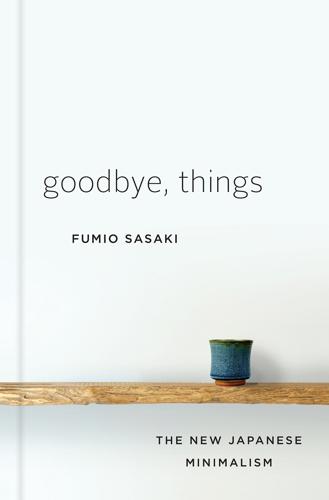
Goodbye, Things: The New Japanese Minimalism
by
Fumio Sasaki
Published 10 Apr 2017
We see them smile and it makes us smile, and we forget about the trouble we may have gone to. Why does this happen? Science is beginning to show that doing something for another person might actually lead to happiness. The discovery of mirror neurons is a good example. Don’t you feel the pain when you see someone getting hurt? When you watch a person fall? Scientists have hypothesized that mirror neurons are what make us feel like we’re experiencing something just by watching the actions being taken by another person. This might be the reason why we can get totally absorbed in a novel, comic book, a TV drama, or a movie.
…
When you look at the people who’ve been enjoying long lives, there will be barely any exceptions to the fact that fine relationships have been nurtured among them. You don’t need to have a hundred friends. There are some people who don’t have family. But scores of research results indicate that ties with neighbors and treasured friends are indispensable for happiness. Mirror neurons and built-in kindness Mahatma Gandhi, who taught nonpossession, said, “Service which is rendered without joy helps neither the servant nor the served. But all other pleasures and possessions pale into nothingness before service which is rendered in a spirit of joy.” Even if we can’t serve others like Gandhi did over the course of his life, it’s true that we experience a sense of joy when we do something for another person.
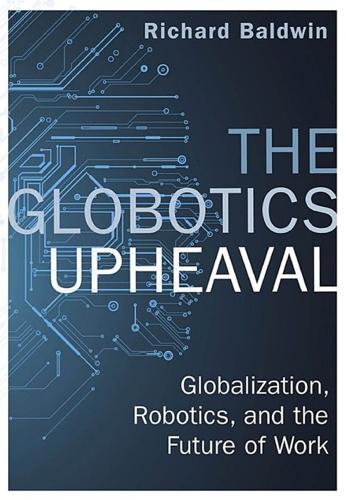
The Globotics Upheaval: Globalisation, Robotics and the Future of Work
by
Richard Baldwin
Published 10 Jan 2019
When we interact with others, we communicate intentions and feelings along with more businesslike information. We put the facts into context using gestures, facial expressions, body postures, and the like. One part of our brain—the “mirror neurons”—are devoted to this social interaction. Rather than “monkey see, monkey do” mechanisms, these are “people see, people feel” mechanisms. Marco Iacoboni, who has the that’s-a-mouthful title of professor of psychiatry and biobehavioral sciences, explains it this way: “When I see you smiling, my mirror neurons for smiling fire up, too, initiating a cascade of neural activity that evokes the feeling we typically associate with a smile.” What this means, he adds, is that “I don’t need to make any inference on what you are feeling, I experience immediately and effortlessly (in a milder form, of course) what you are experiencing.”3 All this is instantaneous and effortless, and we are rarely aware of it, although you can often see it in how people talking together unconsciously synchronize their head nods, arm-crossing, hand gestures, and the like.
…
What this means, he adds, is that “I don’t need to make any inference on what you are feeling, I experience immediately and effortlessly (in a milder form, of course) what you are experiencing.”3 All this is instantaneous and effortless, and we are rarely aware of it, although you can often see it in how people talking together unconsciously synchronize their head nods, arm-crossing, hand gestures, and the like. The most sensitive among us can feel physically ill when they see others experience violence or disturbing emotions. Hearing a sad story makes us feel sad, maybe even cry, even if it happened long ago to someone far away. Mirror neurons turn sound waves into emotions. In short, a big part of the human brain is hardwired for social intelligence. Not all of us are equally good at social cognition, just as we aren’t all equally good at algebra. But as it turns out, computers are much better at algebra than they are at social cognition, and this provides an edge that will allow humans to stay competitive in jobs that involved social interaction.
…
Quotes from Sarah Kessler, “Inside the Bizarre Human Job of Being the Face for Artificial Intelligence,” Quartz.com, June 5, 2017. 2. David Autor, “Why Are There Still So Many Jobs? The History and Future of Workplace Automation,” Journal of Economic Perspectives 29, no. 3 (Summer 2015): 3–30. 3. Quotes from Jonah Lehrer, “The Mirror Neuron Revolution: Explaining What Makes Humans Social,” Mind Matters (blog), ScientificAmerican.com, July 1, 2008. 4. For a textbook exposition of these social psychology concepts, see Graham M. Vaughan and Michael A. Hogg, Social Psychology, 7th ed. (London: Pearson, 2013). 5. See Brenden M. Lake, Tomer D.

Team Human
by
Douglas Rushkoff
Published 22 Jan 2019
We pace someone else’s breathing when we want them to know we empathize. The pupils of our eyes dilate when we feel open to what another person is offering. In turn, when we see someone breathing with us, their eyes opening to accept us, their head subtly nodding, we feel we are being understood and accepted. Our mirror neurons activate, releasing oxytocin—the bonding hormone—into our bloodstream. Human beings connect so easily, it’s as if we share the same brains. Limbic consonance, as it’s called, is our ability to attune to one another’s emotional states. The brain states of mothers and their babies mirror each other; you can see this in an MRI scan.
…
Books reach only the literate wealthy; radio encourages mob violence; money is hoarded by monopoly bankers; social media divides users into algorithmically determined silos. Unlike human beings ourselves, the media and technologies we develop to connect with one another are not intrinsically social. 18. Spoken language could be considered the first communication technology. Unlike dilating pupils or mirror neurons, speech requires our conscious participation. Language gave humans a big advantage over our peers, and allowed us to form larger and better organized groups. Language bonded tribes, offered new ways to settle conflicts, allowed people to express emotions, and—maybe more important—enabled elders to pass on their knowledge.
…
While Team Human may be compromised in the digital environment, team algorithm is empowered. As our more resonant communication pathways fail us, it becomes harder to check in with one another, operate in a coordinated fashion, and express or even experience empathy. We lose all the self-reinforcing feedback loops of rapport: the mirror neurons and oxytocin that reward us for socializing. Surprisingly, the inability to establish trust in digital environments doesn’t deter us from using them, but spurs more consumption of digital media. We become addicted to digital media precisely because we are so desperate to make sense of the neuro-mechanical experience we’re having there.

Emergence
by
Steven Johnson
The same neurons would fire when the monkey observed another monkey performing the task. The pound-your-fist-on-the-floor neurons would fire every time the monkey saw his cellmate pounding his fist on the floor. Rizzollati called these unusual cells “mirror neurons,” and since his announcement of the discovery, the neuroscience community has been abuzz with speculation about the significance of the “monkey see, monkey do” phenomenon. It’s conceivable that mirror neurons exist for more subtle, introspective mental states—such as desire or rage or tedium—and that those neurons fire when we detect signs of those states in others. That synchronization may well be the neurological root of mind reading, which would mean that our skills were more than just an offshoot of general intelligence, but relied instead on our brains’ being wired a specific way.
…
Those oversize communities appeared too quickly for our minds to adapt to them using the tools of natural selection, and so we hit upon another solution, one engineered by the community itself, and not by its genes. We started building neighborhoods, groups within groups. When our lived communities extended beyond the ceiling of human comprehension, we started building new floors. * * * Mirror neurons and mind reading have an immense amount to teach us about our talents and limitations as a species, and there’s no doubt we’ll be untangling the “theory of other minds” for years to come. Whatever the underlying mechanism turns out to be, the faculty of mind reading—and its close relation, self-awareness—is clearly an emergent property of the brain’s neural networks.
…
D., 238n Hardball, 135 Harmonic Convergence, 113–14 Harvard University, 53 Haussmann, Georges-Eugène, 41, 240n Hayek, Friedrich von, 260n HBO, 219 Hess, Moses, 36 heterarchies, 98 Heywood, Rik, 183, 184, 185 hierarchies, 14–15, 18, 30–31, 33, 98, 132, 136, 145, 148–49, 153, 208, 223, 225, 263n–64n Hillis, Danny, 59, 170–74, 180, 209, 223, 231 Hofstadter, Douglas, 45, 65 Holland, John, 27, 57–59, 64–65 Holldobler, Bert, 60, 75 homeostasis, 138, 140–41, 143, 146–47, 148, 149, 151, 154, 159 Homo habilis, 202 Homo sapiens, 202, 204 homosexuality, 41, 43–44 housing projects, 49–50 Howard, Ebenezer, 146, 147, 259n How the Mind Works (Pinker), 118 Hudson Street (New York City), 50, 93 hunter-gatherers, 252n–53n hypertext, 124, 152, 157, 210 Iberall, Arthur, 110–11, 252n–53n IBM, 57 IBM 701 calculator, 57 Image, The (Boorstin), 134–35 immune system, 65, 103, 128, 249n–50n, 261n Impressionism, 39 inertia laws of, 106 information: feedback on, 201–2, 231 flow of, 9, 44–45, 46, 75–76, 94, 96, 108–9, 116–26, 129, 132, 151, 152, 232–33 incomplete, 188, 200–201 from mental states, 196–97 meta-, 79 networks of, 96–97, 116–26, 134–35, 204–5, 217–18 processing of, 44–45, 53, 108, 116, 117, 118, 126–27, 233, 254n–55n retrieval of, 100, 103 sharing of, 40–41, 107–8, 158, 229–34, 251n–52n storage of, 100, 103, 107, 108, 115, 251n tracking of, 121–26, 181, 205 information theory, 44–45, 46 insects, social, 22, 73, 74, 82–83, 121 intelligence: artificial, see artificial intelligence collective, 9, 29, 33, 62–63, 73–82, 85, 97, 103–4, 108, 115, 120–21, 123, 224, 226, 237n–39n, 255n developmental levels of, 11–12, 18 distributed, 220–24, 232–33 emergent, 99–100, 113–14, 127–29 evolution of, 73, 115–17 global, 114–21, 181 human, 45, 124, 127–29, 208 macro-, 116–17 social, 197–98, 202–3 Interactive Telecommunications Program, 178 Interface Culture (Johnson), 113–14 interfaces, user, 108–9, 206, 211, 251n Internet: chaos vs. order on, 117–23 convergence and, 216–19 cultural impact of, 125–26 databases for, 121–26 decentralization of, 66, 118–21, 204–5, 217–18, 263n–64n emergent intelligence of, 113–14, 127–29 as “global brain,” 114–21, 181 as information network, 96–97, 116–26, 134–35, 204–5, 217–18 online communities on, 17, 148–62, 204–5 self-awareness of, 127–29 as web, 17, 66, 226, 229 inventions, 108–9 Jacobs, Jane, 18, 38, 50–52, 64–65, 89, 91–97, 146–48, 156, 229, 230, 236n–37n, 242n, 247n–48n, 256n–58n Jefferson, David, 59–63, 65, 263n Jennings, Peter, 131 Jodi.org, 175, 178 John Muir Trail, 61–63 Joy, Bill, 114 Joyce, James, 39 Kahle, Brewster, 121–23 karma points, 155–56, 160 Keller, Evelyn Fox, 12–17, 18, 42, 43 Kelly, Kevin, 168–69 kindergarten, 165–66 Klein, Naomi, 225, 226 Krugman, Paul, 89–91, 120, 159 “Krush Kringle” toy, 179–80, 182 Kuhn, Thomas, 48 Kurzweil, Ray, 114, 127, 262n language: body, 195 common, 104 development of, 104 digital, 115 encrypted, 44–45, 240n–41n, 255n–56n syntactical structure of, 44–45, 75–76 see also communication Larry King, 135 Latin language, 104 learning: in artificial intelligence, 52–63, 123–24, 127–29, 173 brain activity and, 133–34 by cities, 101–13, 116, 128, 232–33 by computers, 52–63, 170–74 consciousness and, 102–4 feedback in, 52, 57 open-ended, 57–58, 208 software for, 53–63, 65 Lehrer, Jim, 136 Leiser, David, 243n Leonardo da Vinci, 101 Leslie, Alan, 196 Lewinsky, Monica, 144 libraries, 109, 122, 251n Library of Congress, 122 life insurance, 46–47 life span, 99 Linux, 121, 153 logic: dialectical, 66 of emergence, 66–67 as process, 126–27, 255n swarm, 74, 75, 78, 79, 87, 181, 225–26, 232–33 Logic of Computers Group, 57 Logo, 164, 260n Los Angeles, Calif., 91, 95, 97 Luit (chimpanzee), 197 lurkers, 150–51, 152 McLuhan, Marshall, 158, 161 MacNeil/Lehrer NewsHour, 131, 136 Maeda, John, 174, 178 Maes, Patti, 207 magnetic fields, 140 Malda, Rob, 152–62 Mamucium settlement, 34 management, corporate, 67, 223–24 Manchester, England, 22, 33–43, 52, 67, 113 “manor,” 34–35 Marcus, Steven, 38 Marx, Karl, 36 Massachusetts Institute of Technology (MIT), 52, 53, 207 “master planners,” 82 Mathematical Theory of Communication, The (Shannon), 45–47 mathematics: applied, 16 bio-, 12, 13–14, 15, 42, 43 Matrix, The, 114 mazes, 11 media, mass, 130–36, 137, 143–46, 152, 208–21 meditation, 142–43 medium, message vs., 161–62 memory: cellular, 249n–50n collective, 250n institutional, 64 molecular, 65 spatial, 206–7 textual, 206 middens, ant, 32–33, 97 Middle Ages, 101, 111–12, 113, 116, 249n middle class, 37, 41, 240n Milton, John, 53–54 mind, human: decentralized, 22 interconnectedness of, 9 “reading” of, 195–226 “society” of, 65 see also consciousness Minsky, Marvin, 18, 53, 65, 167–68, 237n “mirror neurons,” 198–99 Miyamoto, Shigeru, 176, 178 moderators, online, 154–57, 160, 260n modular theory, 198–99, 202–3 molecules, 46, 65, 85, 86, 236n Molyneux, Peter, 178 monkeys, 197–99, 202, 262n Monopoly, 158–59, 181 “more is different” principle, 78, 165 Morgan, Lloyd, 242n morphogenesis, 14, 15, 42, 43, 49 Moses, Robert, 38, 50 Ms.

Adam Smith: Father of Economics
by
Jesse Norman
Published 30 Jun 2018
For a wide-ranging and provocative essay on norms in relation to self-interest, see Jon Elster, ‘Social Norms and Economic Theory’, Journal of Economic Perspectives, 3.4, 1989 Scientific views on reciprocity, social norms and mirror neurons: see e.g. Frans de Waal, Our Inner Ape: The Best and Worst of Human Nature, Granta Books 2006; Jean Ensminger and Joseph Henrich (eds.), Experimenting with Social Norms: Fairness and Punishment in Cross-Cultural Perspective, New York, Russell Sage Press 2014; Giacomo Rizzolatti and Laila Craighero, ‘The Mirror-Neuron System’, Annual Review of Neuroscience, 27, 2004. For a contrary view (less contrary than the title implies), see Gregory Hickok, The Myth of Mirror Neurons, W. W. Norton 2014. On the supercharging effect of culture within evolution, see Joseph Henrich, The Secret of our Success, Princeton University Press 2016 Smith and Rawls: See John Rawls, A Theory of Justice, Harvard University Press 1974.
…
Nevertheless, it is striking how many lines of scientific and social scientific research on these themes have begun to converge in recent years. These include the work of Frans de Waal and others on norms of reciprocity in primates; of Joe Henrich and others on the evolutionary selection of social norms in different populations; and of Giacomo Rizzolatti and others on the activity of ‘mirror neurons’—neurons that fire both when a monkey or human performs an action and when they see another monkey or human doing a similar action. Some people have seen a potential grounding in neuroscience for Smith’s idea of ‘sympathy’. Perhaps most striking of all is the degree to which game theory has developed and illuminated ideas to be found in Hume and Smith.
…
Smith, Rethinking Housing Bubbles: The Role of Household and Bank Balance Sheets in Modeling Economic Crises, Cambridge University Press 2014 Gordon, Robert J., The Rise and Fall of American Growth, Princeton University Press 2016 Graham, Benjamin, The Intelligent Investor, Harper & Bros. 1949 Greenberger, Martin (ed.), Computers, Communication, and the Public Interest, Johns Hopkins Press 1971 Griswold, Charles, Adam Smith and the Virtues of Enlightenment, Cambridge University Press 1999 Haakonssen, Knud (ed.), The Cambridge Companion to Adam Smith, Cambridge University Press 2006 Haakonssen, Knud, The Science of a Legislator: The Natural Jurisprudence of David Hume and Adam Smith, Cambridge University Press 1981 Hacker, Jacob S. and Paul Pierson, Winner-Take-All Politics: How Washington Made the Rich Richer—and Turned its Back on the Middle Class, Simon & Schuster 2010 Hanley, Ryan Patrick, Adam Smith and the Character of Virtue, Cambridge University Press 2009 Harris, James, Hume: An Intellectual Biography, Cambridge University Press 2015 Haskel, Jonathan and Stian Westlake, Capitalism without Capital: The Rise of the Intangible Economy, Princeton University Press 2017 Hayek, Friedrich, The Fatal Conceit, University of Chicago Press 1988 Henrich, Joseph, The Secret of our Success, Princeton University Press 2016 Hickok, Gregory, The Myth of Mirror Neurons, W. W. Norton 2014 Hirschman, Albert, The Passions and the Interests: Political Arguments for Capitalism before its Triumph, Princeton University Press 1977 Hirschman, Albert, Rival Views of Market Society and Other Recent Essays, Cambridge University Press 1992 Hont, Istvan, Jealousy of Trade: International Competition and the Nation-State in Historical Perspective, Harvard University Press 2005 Hont, Istvan, Politics in Commercial Society, Harvard University Press 2015 Hont, Istvan and Michael Ignatieff (eds.), Wealth and Virtue: The Shaping of Political Economy in the Scottish Enlightenment, Cambridge University Press 1986 Hoppit, Julian, Britain’s Political Economies: Parliament and Economic Life 1660–1800, Cambridge University Press 2017 Horne, George, A Letter to Adam Smith LL.D. on the Life, Death, and Philosophy of His Friend David Hume Esq. by One of the People Called Christians, Clarendon Press 1777 Howell, Martha C., Commerce before Capitalism in Europe 1300–1600, Cambridge University Press 2009 Hume, David, Essays Moral, Political and Literary, ed.
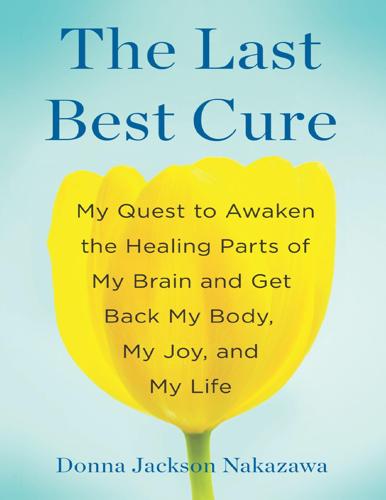
The Last Best Cure: My Quest to Awaken the Healing Parts of My Brain and Get Back My Body, My Joy, a Nd My Life
by
Donna Jackson Nakazawa
Published 21 Feb 2013
Something else happens when we go to class. We begin to grow as a group. When we’re learning new skills we fire up what are known as “mirror neurons”—a particular type of brain cell that observes and receives signals from those in near proximity to us and triggers similar reactions within us. It’s why we are more likely to start crying—or laughing, or yawning, or tapping our foot (or eating more potato chips)—if a friend is crying or laughing or yawning or tapping his or her foot or eating junk food. Our mirror neurons fire up in response to what those around us are doing and prime us to unconsciously mimic what we see. When we watch and imitate a yoga instructor, or even another student who knows the yoga ropes better than we do, our brain receives the information faster than we can by watching a video.
…
Our mirror neurons fire up in response to what those around us are doing and prime us to unconsciously mimic what we see. When we watch and imitate a yoga instructor, or even another student who knows the yoga ropes better than we do, our brain receives the information faster than we can by watching a video. Women have more active mirror neurons than men do, helping us to better imitate instructors. (This gender difference may be part of the reason why women attend so many more group classes, in general, than men do.) Write down the times for your regular yoga class on your calendar two and three months ahead of time. That way when something else comes up (and it will) that slot is already taken. If you’re interested in the yoga teachers who’ve taught me, here’s how to find out more about them: Julie Madill You can learn more about Julie Madill’s yoga classes at maryland yoga.com.
…
See compassion meditation Lowry, Christopher, 149 lunges, 200 Madill, Julie, 195, 196–201 Magyari, Trish on acupuncture, 224 background of, 61–63 on mindfulness, 57–61, 63–66 on multimeditating, 133 on naming experiences, 61, 88, 90 on ruminations, 85–90 McCarthy, Margaret, 44 Meaney, Michael, 35–37, 173 meditation and mindfulness and cell health, 73 and cognitive decline, 75 compassion meditation (loving-kindness), 115–19, 122–27, 131, 133, 134 and concentration, 75 difficulties with, 87 finding classes, 268–69 meditation retreat, 160–68, 169–71 mindfulness-based stress reduction (MBSR), 63–65, 74–76, 84, 107–9, 268–69 naming feelings and experiences in, 92–93 neurological effects of, 44, 74–77, 92–93, 113 and PIN response, 69–70, 76 practicing mindfulness, 99 quieting the mind, 109–10 and sympathetic/parasympathetic nervous systems, 59, 63, 73, 76 and telomere length and telomerase levels, 72–74, 76 twelve-second threshold in, 110 walking meditation, 133, 141–42 memories, 90, 103–4, 150, 151–52 methylation process, 36–37, 44, 88, 173, 174 mindful breathing, 58–61, 118. See also breath exercises mindfulness-based stress reduction (MBSR), 63–65, 74–76, 84, 107–9, 268–69. See also meditation and mindfulness mirror neurons, 271–72 mitochondria, 190 mu-opioid receptors, 220–21 myelin, 74–76 naming feelings and experiences, 61, 88–94, 99, 137 nature, benefits of time spent in, 133–34, 137, 276 negativity, 67–68, 86–89, 101–5, 111, 130–31 Negi, Geshe Lobsang Tenzin, 118 neurogenesis, 188–90, 194 neuropsin protein, 148 Noggin, 189 ocean breath (ujjayi breath), 186, 216 optimism, 130–31 orchid hypothesis, 171–75 oxytocin, 136 pain and pain management and acupuncture, 218–24, 232 emotional pain, 183 fear’s effect on, 182 hidden pain, 152, 153–54 and memory suppression, 151–52 and mindfulness techniques, 63 perception of, 182–83 and posture, 193, 194–95 and psoas muscle, 200 and yoga, 184 parasympathetic nervous system (PNS) and meditation and mindfulness, 63, 73, 76 nature’s effect on, 133–34 role of, 34–35 and sighing, 111 and touching one’s lips, 137 and yoga, 186–87, 216 parents, 19, 22, 36–37, 156–59 passive helplessness, 131 pessimism, 130–31 PIN response amygdala’s role in, 91 approaches that alter, 28–29 and childhood adversity, 38 and chronic health issues, xix, 14, 35 and compassion meditation, 117 and meditation and mindfulness, 69–70, 76 and orchid hypothesis, 173 and pain perception, 183 and psoas muscle, 200 state of mind’s effect on, xiii–xiv, 27–28 stuck in “on” position, 15, 35, 88, 104 and yoga, 186 positivity, 129–31, 274–76 posterior cingulate cortex, 150 posttraumatic stress disorder (PTSD), 64–65 posture, 193–95 power and powerlessness, 156–59 prefrontal cortex, 103, 150, 185 psoas muscle, 199–200 psychoneuroimmunology (PNI/PIN), xi–xiv, xvii, xix, 14.
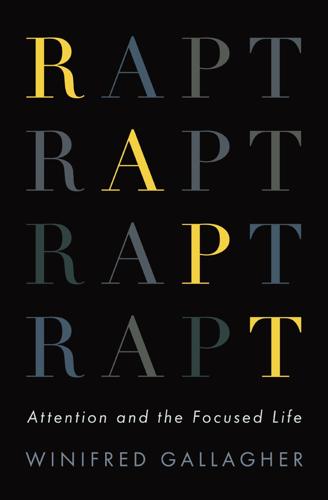
Rapt: Attention and the Focused Life
by
Winifred Gallagher
Published 9 Mar 2009
After all, we regard animals as beings.” Intrigued by the “monkey see, monkey do” antics of his macaques, the University of Parma neuroscientist Giacomo Rizzolatti traced that copycat behavior to the “mirror neurons” that help forge the close connection between attention and social behavior. When animal A merely watches animal B doing a task, these nerve cells are activated in the same way as if A itself were doing the chore. In human beings, mirror neurons are thought to help us understand others’ behavior and to foster empathy, appropriate facial expressions, and language. Evolution seems to have designed us to pay attention to others not just so that we can do what they do, but also to feel what they feel.
…
Pat robots Rogers, Carl Rolling Stones Rome, family life in Roomba (robot) Room With a View, A (Forster) Rothbart, Mary Rozin, Paul Rushdie, Salman sadness salesmen Samoa satisfaction, work and savoring Schooler, Jonathan School Sisters of Notre Dame Schultheiss, Oliver Schwartz, Barry Schwarz, Norbert science see also neuroscience Scitovsky, Tibor Scorsese, Martin scuba diving self, sense of self-esteem motivation and self-regulation (self-control) Seligman, Martin sex sexual abuse Shakespeare, William shame Sharpton, Rev. Al Sheena (dog) Sheeran, Paschal Shine a Light (documentary) sleep smoking social behavior, mirror neurons and social interactions, sensitive attention and sonnets “SOUL selects her own Society, THE” (Dickinson) Sparky (Langer’s dog) spelling bees Spinoza, Baruch sports and games status decision-making and status quo, myths about Stevenson, Robert Louis Stewart, Larry stimulants stress health and meditation and mindfulness and relationships and therapy and stroke Stroop effect Stubbs, George subjectivity reality and sublime, the subliminal information substance abuse, ADHD and superficiality Surveillance Camera Players talent targets creativity and meditation and selection of taxi drivers Taymor, Julie teachers teenagers, see adolescents Tellegen, Auke temperance Teresa, Mother Terman, Lewis “termites,” use of term terror therapy cognitive This American Life (radio show) Thoreau, Henry David thought reality vs.

You Are Not So Smart
by
David McRaney
Published 20 Sep 2011
Essentially, as he put it, there were two people in one body—two selves. Ramachandran believes your sense of self is partly the action of mirror neurons. These complex clusters of brain cells fire when you see someone hurt themselves or cry, when they scratch their arm or laugh. They put you in the other person’s shoes so you can almost feel that person’s pain and itches. Mirror neurons provide empathy and help you learn. One of the greatest discoveries in recent years was to find that mirror neurons fire also when you do things. It is as if part of your brain is observing yourself as an outsider. You are a story you tell yourself.

The Beginning of Infinity: Explanations That Transform the World
by
David Deutsch
Published 30 Jun 2011
That translation requires some quite sophisticated computation, which is encoded in genes, not memes. It is thought to be achieved in part by a system based on ‘mirror neurons’. These are neurons that fire when an animal performs a given action, and also when the animal perceives the same action being performed by another. These neurons have been identified experimentally in animals that have the capacity to imitate. Scientists who believe that human meme replication is a sophisticated form of imitation tend to believe that mirror neurons are a key to understanding all sorts of functions of the human mind. Unfortunately, that cannot possibly be so.
…
A ringing doorbell and a barking dog may happen to provide conditions that meet the inborn criterion that initiates parroting behaviour, and, when they do, the parrot will always mimic exactly the same aspects of them: their sounds. So, it resolves the infinite ambiguity by making no choices. It does not occur to it to ignore the dog under those conditions, or to imitate the wagging of its tail, because it is incapable of conceiving of any other criterion for imitation than the one built into its mirror-neuron system. It is devoid of creativity and relies on its lack of creativity to replicate the sounds faithfully. This is reminiscent of humans in static societies – except for a crucial difference which I shall explain below. Now, imagine that a parrot had been present at Popper’s lectures, and learned to parrot some of Popper’s favourite sentences.
…
It is a very inefficient method, requiring a lot of watching of behaviours that a human could mimic almost immediately by understanding their purpose. Also, it allows only a few fixed options for connecting the behaviours together, so only relatively simple memes can be replicated. Apes can copy certain individual actions instantly – the ones of which they have pre-existing knowledge through their mirror-neuron system – but it takes them years to learn a repertoire of memes that involve combinations of actions. Yet those memes – trivially simple tricks by human standards – are enormously valuable: using them, apes have privileged access to sources of food that are closed to all other animals; and meme evolution gives them the ability to switch to other sources far faster than gene evolution would allow.
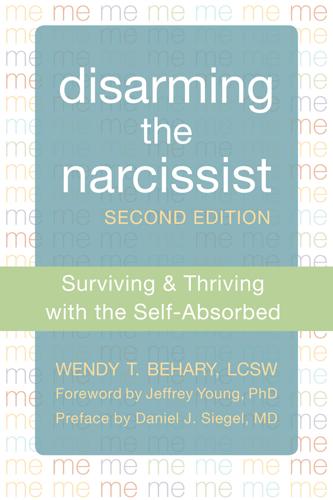
Disarming the Narcissist: Surviving and Thriving With the Self-Absorbed
by
Wendy T. Behary
Published 1 Jul 2013
Can a narcissist ever truly experience what happens inside another person’s skin? Some of the brightest thinkers and communicators, including journalists, psychologists, researchers, political analysts, anthropologists, and even wordsmiths, are investigating empathy from many angles, from studying mirror neurons to pondering moral consciousness. For example, without empathy or understanding, how can people predict the future, view themselves in comparison to others, and hold the world in their mind? In response to readers’ and clients’ quandaries about empathy, and incorporating new findings on this topic, this new edition of Disarming the Narcissist contains much more material on the topic, including how empathy promotes emotional stability.
…
A Brief Look at the Science of Empathy In the 1980s and 1990s, neuroscientists discovered an intriguing type of neurons that are activated both when we perform a certain action, such as grasping a cup or a fork, or even smiling or frowning, and when we observe someone else performing the same action (Iacoboni 2009). It’s almost like the brain is responding as if we are viewing our own reflection in a mirror. Therefore these brain cells are called mirror neurons. Recent neuroscience investigations into empathy utilizing patterns observed in functional magnetic resonance imaging scans suggest that context and individual makeup, including biology, personality traits, and emotional states, play a role in understanding the degree to which an individual can access empathic awareness.

Survival of the Richest: Escape Fantasies of the Tech Billionaires
by
Douglas Rushkoff
Published 7 Sep 2022
When we engage with others in real life, we can see if their pupils are growing larger to take us in, if their breathing rate is syncing up with ours in empathy, or if their faces are flushing with passion. This, in turn, fires the mirror neurons in our brains, stimulating a positive feedback loop and releasing oxytocin—the bonding hormone—straight into our bloodstreams. On a Zoom call, much less a text message or Twitter comment, we can’t feel these subconsciously detected cues. Someone may say they agree with us, but we can’t confirm this assertion with our bodies. The mirror neurons don’t fire, the oxytocin doesn’t flow, and we’re left in a state of cognitive dissonance: they said they agree with me, but it doesn’t feel like it.
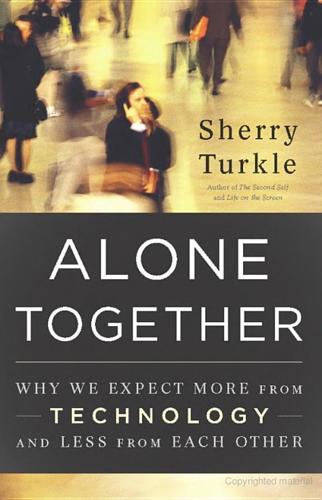
Alone Together
by
Sherry Turkle
Published 11 Jan 2011
In the grief project, the position of her body brought Lindman to experiences of abjection, something that she now attributes to mirror neurons. She had expected that doubling for a robot would be very different because “it has no emotion.” But in the end, she had to create emotions to become an object without emotion. “To remember the robot’s motions, I had to say: ‘It does this because it feels this way.’ . . . It wasn’t like I was feeling it, but I had to have that logic.” Except that (think of the mirror neurons) Lindman was feeling it. And despite herself, she couldn’t help but imagine them in the machine. Lindman’s account becomes increasingly complex as she grapples with her experience.
…
Then, she sketched several hundred of the photographs and began to act them out, putting her face and body into the positions of the people in the photographs. Lindman says she felt grief as she enacted it. Biology makes this so. The shape of a smile or frown releases chemicals that affect mental state.11 And in humans, “mirror neurons” fire both when we observe others acting and when we act ourselves. Our bodies find a way to implicate us emotionally in what we see.12 Lindman came out of the grief project wanting to further explore the connection between embodiment and emotion. So, closely tracking that project’s methodology, she began to work with machines that had bodies.
…
Life Browser Life capture Life mix, life notion of Lifton, Robert Jay Lindman, Pia affective computing and cyborg dreams and Domo and grief project and romantic scripts and Loneliness handling robotic caregivers and texting and Loopt Love future of online reverse engineering robots and simulated tests Love and Sex with Robots (Levy) Machine intelligence Machines people seeing themselves as psychological/spiritual view of romancing the Magic Mountain, The (Mann) Mann, Steve Mann, Thomas Marriage, online McCarthy, Joseph McLuhan, Marshall McNealy, Scott Memory offloading Mentally retarded, robots and Mentors, robots as Merleau-Ponty, Maurice Merlin (electronic game) Mertz (robot) Messages, electronic asynchronous looking at stream of unopened voice and Milo (virtual human) Mind/body dualism Minsky, Marvin Mirror neurons Mobile devices productivity and time alone and turning off Moral issues Multi-lifing (life mix) Multitasking alchemy of time and digital culture and classroom time and intimacy, challenge to Multiuser domains (MUDs) Mutuality, expectation of My Real Baby babysitter, fantasy of it as caring for elderly and pain, reactions to MyLifeBits MySpace communities and identity on messaging on photos on privacy and Nass, Clifford Networked devices Networked life compulsions of robotics and stress of Networks Neurochemicals, people as constituted by New York Times New Yorker, The Nomadism, virtual Nursebot Nursing homes robots and Nurturance as killer app robots and Obama, Barack Oedipus Oldenberg, Ray Online life authenticity and complications of reflecting on dropping out of etiquette of extramarital affairs and individual experimentation and multiplicity of selves in Pain, simulations of Panopticon Papert, Seymour Parents involvement of separation from visiting elderly Paro cared for by, feeling of being companionship of memories and talking to People things and mechanical view of persistence of on Internet Performance disorientation of in avatars, profiles, and text perils of self-presentation and Personae, virtual Pets digital and biological digital and robotic responsibility/commitment, as teachers of Phone calls avoiding boundaries in, anxiety about interruptions, and in public space real-time commitment of Photos cell phones and online Piaget, Jean Picard, Rosalind Plato Play, “serious,” Poe, Edgar Alan Pokémon, children’s ideas about “powers” and PostSecret Potter, Harry Privacy and anxieties of always concerns about illusion of intimacy and online politics of reclaiming Profiles, online avatars and constructing Programming hacker culture and Programs, crashing/reviving Protean Self, The (Lifton) Protean self Proust, Marcel Psychoanalysis, and ethic of Psychological risks, robots and Psychopathology, social construction of Quake, playing Quandaries Ramona (avatar) Real, virtual and Realtechnik Recollection, collection and Relationships building complexities of intensity of with less no-risk real, in the robots and safety, feeling of sanctioning of robotic skills sociable robots and titrating distance and (“Goldilocks effect”) reflecting on virtual weak-tie Remembrance of Things Past (Proust) Republic, The (Plato) Resignation, Thoreau’s view of Riesman, David Robot companions attitudes about control issues and elderly and loneliness and physical involvement with promise of Robotic moment behaviorism of psychological risks of romantic reaction and roboticists, views of Robotics connectivity and elderly and nurturance as “killer app” in Robots aggression, as a way to connect with animating with one’s own personality caring by connection to, children’s desire for and conscience, balm to daily life, considering role in discontents with conversations with humanoid human caretaker, preference for merging with (Lindman) as performative physical contact with, power of relationships with sex with as substitute humans as superheroes as uncanny Rock Band (simulation) Roller Coaster Tycoon (game) Romantic reaction robotic moment and Rorschach, robots as Roxxxy Safety, desire for Sandel, Michael Scassellati, Brian Cog and Schmidt, Eric Schüll, Natasha Scientific American Second Life advertisement for avatars on communities and joining overstimulation on Second Self, The (Turkle) Self collaborative inner-/other-directed sense of new state of site and Self-presentation, performance and Self-reflection Self-surveillance Selfobjects, role of Separation in adolescence as rejection September 11th Sex with robots reverse engineering Sex dolls, burials for Shakespeare, William Shibata, Takanori Simon (electronic game) Simon, Herbert Sims Online (game) Simulation as catharsis as coursening Simultaneous vision Skype Slick, Grace Sociable robots adolescents and aggression toward alive enough, pragmatic notion of care/attention, desire that they provide as companions disappointment with, effects of elder care and ethical terrain, on new.

The Moral Landscape: How Science Can Determine Human Values
by
Sam Harris
Published 5 Oct 2010
Pain-related neurons in the human cingulate cortex. Nat Neurosci, 2 (5), 403–405. Iacoboni, M. (2008). Mirroring people: The new science of how we connect with others (1st ed.). New York: Farrar, Straus and Giroux. Iacoboni, M., & Dapretto, M. (2006). The mirror neuron system and the consequences of its dysfunction. Nat Rev Neurosci, 7 (12), 942–951. Iacoboni, M., & Mazziotta, J. C. (2007). Mirror neuron system: Basic findings and clinical applications. Ann Neurol, 62 (3), 213–218. Iacoboni, M., Rayman, J., & Zaidel, E. (1996). Left brain says yes, right brain says no: Normative duality in the split brain. In S. Hameroff, A.
…
J Neurosci, 17 (11), 4302–4311. Kaplan, J. T., Freedman, J., & Iacoboni, M. (2007). Us versus them: Political attitudes and party affiliation influence neural response to faces of presidential candidates. Neuropsychologia, 45 (1), 55–64. Kaplan, J. T., & Iacoboni, M. (2006). Getting a grip on other minds: Mirror neurons, intention understanding, and cognitive empathy. Soc Neurosci, 1 (3–4), 175–183. Kapogiannis, D., Barbey, A. K., Su, M., Zamboni, G., Krueger, F., & Grafman, J. (2009). Cognitive and neural foundations of religious belief. Proc Natl Acad Sci USA, 106 (12), 4876–4881. Karczmar, A. G. (2001).
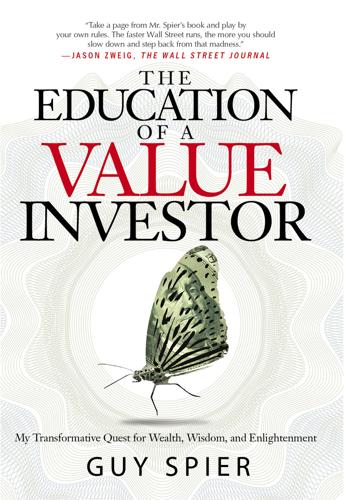
The Education of a Value Investor: My Transformative Quest for Wealth, Wisdom, and Enlightenment
by
Guy Spier
Published 8 Sep 2014
I’m not deifying him, but I want to activate his presence in my mind—not least as a cue to remind me of the dangers of those 24 forms of misjudgment that he identified in his talk at Harvard. Likewise, I keep photographs in my busy room and my library that show me with Warren and Mohnish on the day of our lunch. I can’t explain all of this on a rigorous scientific level. But my impression is that mirror neurons help us to model the influential people in our presence. By having images of Munger and Buffett in my office, I’m trying once again to tilt the playing field on a subconscious level, using their presence to influence my thoughts. My sense is that this is quite common. When I visited Winston Churchill’s study at Chartwell, I was struck by the objects he kept on his desk, including a bust of Napoleon, a porcelain figurine of Admiral Nelson, and a photograph of the South African prime minister Jan Smuts.
…
See also annual reports Li Lu, 73, 125–6, 176 Libet, Benjamin, 102 Lichter, John, 59 London Mining PLC, 97–8, 149 Long-Term Capital Management, 86 Lowenstein, Roger, 19, 30, 63, 116, 142 Made in America (Walton), 142 Malone, John, 130 management, rule for talking to, 139–40 Marcus Aurelius, 96 Marinoff, Lou, 192 Marks, Howard, 64 mastermind groups, 52–4, 124, 193–4 mentoring. See modeling habits of successful people Merrill Lynch, 17 Mihaljevic, John, 106, 124, 177, 184 Miller, Bill, 104, 122 mirror neurons, 115 mirroring, 39–40, 74, 113, 115. See also modeling habits of successful people modeling habits of successful people, 39–40, 46, 67, 71, 96, 113, 115–16, 176–7 Moody’s, 88, 90–1 Morgan, John Pierpont, 6 Morgan Stanley, 8, 169 “Mr. Market,” 19, 50, 129 Munger, Charles “Charlie,” 61, 78–9, 90, 138 on admitting mistakes, 52 and bridge, 124–5 and Buffett, 173, 176 on Buffett, 29–30 on envy, 50 on initial ideas, 130 intelligence of, 59–60 and Li Lu, 125–6, 176 and mistakes, 153 as polymath, 60, 104–5 as role model, 115 on role models, 40 on truthfulness, 66 “Twenty-Four Standard Causes of Human Misjudgment,” 28, 59–60, 140, 148 and wealth, 82, 188 See also Poor Charlie’s Almanack: The Wit and Wisdom of Charles T.
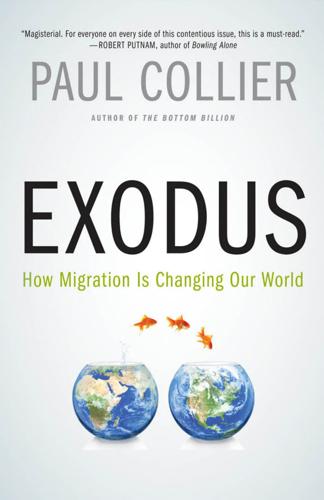
Exodus: How Migration Is Changing Our World
by
Paul Collier
Published 30 Sep 2013
However, a central recent insight in social science is that people copy the behavior of others. This appears to have deep neurological foundations: in the mid-1990s it was discovered that the mirror neuron fires both when someone performs an action and when they see someone else perform it.13 In effect, copying is the neurological default option; behavior that avoids copying an action requires a conscious decision to override the mirror neurons. This does not make us slaves to the actions of others, but experimental psychology is revealing that we are disturbingly suggestible. A subject who observes rude behavior will behave more rudely; a subject who is told to think about the characteristics of the elderly will themselves walk more slowly.

Beginners: The Joy and Transformative Power of Lifelong Learning
by
Tom Vanderbilt
Published 5 Jan 2021
See Beatriz Calvo-Merino et al., “Seeing or Doing? Influence of Visual Motor Familiarity in Action Observation,” Current Biology 16, no. 19 (2006), doi.org/10.1016/j.cub.2006.07.065. watching a dog bark: This example comes from Giacomo Rizzolatti and Corrado Sinigaglia, “Curious Book on Mirror Neurons and Their Myth,” review of The Myth of Mirror Neurons: The Real Neuroscience of Communication and Cognition, by Gregory Hickock, American Journal of Psychology 128, no. 4 (2015). fully engage one’s motor cortex: Maxime Trempe et al., “Observation Learning Versus Physical Practice Leads to Different Consolidation Outcomes in a Movement Timing Task,” Experimental Brain Research 209, no. 2 (2011): 181–92.

No Regrets, Coyote: A Novel
by
John Dufresne
Published 1 Jun 2014
I can look at a person, at his expressions, his gestures, his clothing, his home, and his possessions, and tell you what he thinks, if not always what he’s thinking. Carlos liked to call me an intuitionist. Bay said I’m cryptaesthetic. Dr. Cabrera at UM’s Cognitive Thinking Lab told me I have robust mirror neurons. I just look, I stare, I gaze, and I pay attention to what I see. I’m able to find essence in particulars, Dr. Cabrera said. Carlos told me that the neighbors heard what sounded like fireworks or like gunshots around seven o’clock that evening. Pop! And then pop!-pop!-pop! And then pop! All the neighbors came out to investigate, except the Hallidays, who lived … had lived here.
…
And when I finally got warm, when I thawed out and quit shaking uncontrollably, when I no longer felt the stabbing pain in my hands and feet, when I’d had a cup of hot coffee, then I’d tell my handlers the story of all the recent nasty business, and I’d tell it properly, with sufficient backstory, with eloquent and convincing detail, with the kind of keen psychological insight you’d expect from a guy with robust mirror neurons. I’d utilize all the appropriate and seductive narrative techniques so that, as improbable as it all might sound, they would have to believe me. My only salvation, then, would be to tell a compelling and credible story. I might preface the story by saying that life does not always make sense, but a story does.
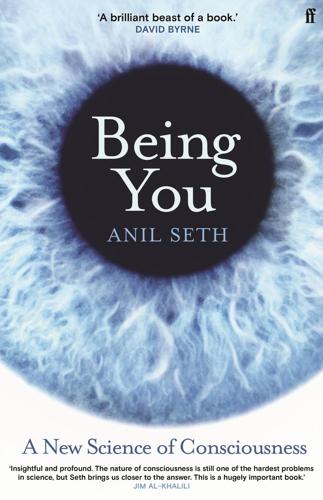
Being You: A New Science of Consciousness
by
Anil Seth
Published 29 Aug 2021
This idea provides a prediction machine gloss on what it means to have a theory of mind, and it may provide a useful way of interpreting apparent deficits in social perception, as happens for example in autism. See C. J. Palmer et al. (2015). socially nested predictive perceptions: Neuroscientific discussions of social perception often highlight so-called ‘mirror neurons’. These neurons – first discovered in monkey brains by the Italian neuroscientist Giacomo Rizzolatti and his colleagues – fire away both when an animal acts, and when it observes the same action performed by another animal (Gallese et al., 1996). The neurons are said to ‘mirror’ the behaviour of other animals, because they respond as though the observer itself were acting.
…
Oxford: Oxford University Press. Byrne, A., & Hilbert, D. (2011). ‘Are colors secondary qualities?’ In L. Nolan (ed.), Primary and Secondary Qualities: The Historical and Ongoing Debate, Oxford: Oxford University Press, 339–61. Caramazza, A., Anzellotti, S., Strnad, L., et al. (2014). ‘Embodied cognition and mirror neurons: a critical assessment’. Annual Review of Neuroscience, 37, 1–15. Carhart-Harris, R. L., Erritzoe, D., Williams, T., et al. (2012). ‘Neural correlates of the psychedelic state as determined by fMRI studies with psilocybin’. Proceedings of the National Academy of Sciences of the USA, 109(6), 2138–43.
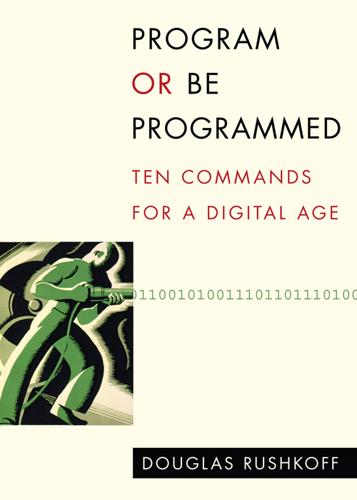
Program Or Be Programmed: Ten Commands for a Digital Age
by
Douglas Rushkoff
Published 1 Nov 2010
As we have all experienced, the way a person makes eye contact can mean a whole lot more to us than whatever he is saying. But online, we are depending entirely on that tiny 7 percent of what we use in the real world. Absent the cues on which we usually depend to feel safe, establish rapport, or show agreement, we are left to wonder what the person on the other end really means or really thinks of us. Our mirror neurons—the parts of our brains that enjoy and are reinforced by seeing someone nod or smile while we are sharing something—remain mute. The dopamine we expect to be released when someone agrees with us doesn’t flow. We remain in the suspicious, protective crouch, even when the situation would warrant otherwise—if only we were actually there.

Grouped: How Small Groups of Friends Are the Key to Influence on the Social Web
by
Paul Adams
Published 1 Nov 2011
People in our group, and people we perceive to be like us, disproportionately influence us. We often change our behavior to conform to the expectations, attitudes, and behavior of our group. We overrate the advice of experts. Random strangers can often outperform experts. Further reading 1. See the Wikipedia article titled Mirror Neuron for an introduction and further reading. 2. See Richard Thaler and Cass Sunstein’s book Nudge: Improving Decisions About Health, Wealth, and Happiness (Yale University Press, 2008). 3. In their book Connected (Little, Brown, 2009), Nicholas Christakis and James Fowler describe how people are influenced by social proof. 4.

Vanishing New York
by
Jeremiah Moss
Published 19 May 2017
The German word Einfühlung, from which empathy comes, was a term from aesthetics, referring to the way a viewer would “feel into” a work of art or architecture, identifying with the object. As infants, we develop our capacity for empathy by finding it in our caregiver’s gaze. She or he looks at us, sees us, reflects us back to ourselves with love, and our brains blossom with mirror neurons. Without eye contact, our ability to empathize can be impaired. (Blind children are taught empathy through words.) The caregiver who turns inward more often than not, who withdraws into her own narcissism, depression, psychosis, may create in the child a psyche that likewise turns away, retreating into his own hollow world of self-reflecting mirrors.
…
It unsettles us. I think of the Uncanny Valley, that measurement of discomfort we feel in the presence of a figure that falls somewhere between human and inhuman, not quite dead and not quite alive. We feel it when confronted by moving images of androids and zombies. Their strange behaviors unsettle the mirror neurons in our brains. They disturb our attempts to empathize. I wonder if the same thing happens on the sidewalk when confronted by iZombies with their undead, android-like behaviors and psychic absence. I feel irritated and off-kilter whenever they’re around. As a former poet, I’m prone to the pathetic fallacy and often attribute emotion to the inanimate.

The Zero Marginal Cost Society: The Internet of Things, the Collaborative Commons, and the Eclipse of Capitalism
by
Jeremy Rifkin
Published 31 Mar 2014
We yearn for companionship and crave social embeddedness. Much of that sociability is soft wired into our neural circuitry and either nourished or extinguished by our culturalization. In the 1990s, scientists stumbled upon mirror neurons in human beings—popularly dubbed empathy neurons. Several of our primate relatives and elephants have empathy neurons—we are still not sure of other species. Mirror neurons and other parts of our neural makeup allow us to experience another being’s feelings as our own—not just intellectually, but physiologically and emotionally. For example, if I’m observing a spider travel up another person’s arm, I’m likely to feel the same creepy feeling in my neural circuitry as if it was climbing up my limb.
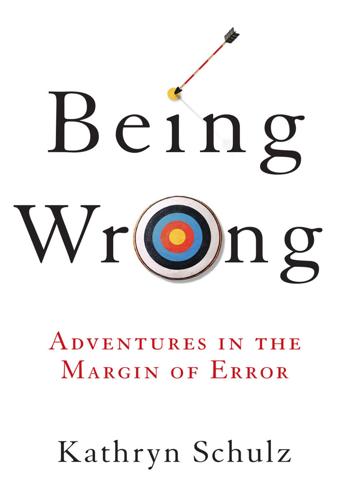
Being Wrong: Adventures in the Margin of Error
by
Kathryn Schulz
Published 7 Jun 2010
Like theory of mind, simulation theory attempts to explain how we understand each other, but the explanation it proposes is markedly different: rather than claiming that we make use of “naïve psychology”—a theory of how other people’s minds work—in order to understand one another, simulation theory claims that we simply draw conclusions about other minds based on the workings of our own. This theory has recently gotten some support from neuroscience, with the discovery of “mirror neurons”: nerve cells in the brain that fire both when, say, you perform an action yourself and when you see someone else perform it; or when you either experience a given emotion directly (for example, fear or disgust), or witness someone else experiencing it. In highlighting the utility of extrapolation, I am not trying to make a strong claim for simulation theory, partly because I’m not convinced by it but mainly because I am not qualified to weigh in.
…
See Wrong Buts Jackson, Jesse, 294 Jacobs, Enoch, 208, 374n James, William, 25, 28–29, 71, 82, 93–94, 96, 133, 165–66, 165n, 167, 217n, 359n, 363n Janis, Irving, 152–53 Janoff-Bulman, Ronnie, 292–93, 337 Jastrow, Joseph, 29–30, 31, 153–54, 349n Jefferson, Thomas, 141, 312–13, 314 Jenkins, Harold, 170 Jillette, Penn, 150–51 Joan of Arc, 198n Johnson, Calvin, 238 Jones, Ward, 105, 323, 361n Josephus, 160–61, 160n Judas of Galilee, 159–61 juif errant, 41–43 Jung, Carl, 287 Kant, Immanuel, 60n, 323 Keats, John, 329–30, 391n Keech, Marian, 179–80 Keeler, Leo, 28, 346n, 354n Kennedy, John F., 72, 73, 152, 153 Kerry, John, 174–77, 371n Kerry, Teresa Heinz, 175 Kertscher, Tom, 380n Keynes, John Maynard, 176 Kierkegaard, Søren, 259, 323 King, Martin Luther, Jr., 273, 274, 295 King Lear (Shakespeare), 39–40, 172 Klahr, David, 372n knight errant, 41–43 knowledge, 67–86 beliefs vs., 70–71, 90–91 of the body, 67–69, 79–82 certainty vs., 163–64 confabulations and, 77–86 memory failures and, 71–77 perception and, 53–54 reliance on other people’s, 137–44 Kocourek, Tom, 380n Kolbert, Elizabeth, 367n Kraepelin, Emil, 82 Krugman, Paul, 90 Kübler-Ross, Elisabeth, 229–30 Kuhn, Thomas, 125–27, 126n, 167, 186, 187n, 208, 349n Ku Klux Klan (KKK), 273–79, 284n, 294–95 Lake Wobegon Effect, 106–7 Lancaster Sound, 48–50, 353n Landsgemeinde, 147–48, 151 language, 97, 98, 116n, 119–21, 252–53, 307–9 Lanir, Zvi, 374n Laplace, Pierre-Simon, 34–35 La Rochefoucauld, François de, 263 Larousse, 29, 348n Laser Interferometer Gravitational-Wave Observatory, 94 laughter, 321–26, 389–90n Lee, Keunwoo, 210n Leka, Donald, 122–23 Leno, Jay, 175 Letters on Natural Magic (Brewster), 63–64 Levin, Harry, 390n Levitt, Arthur, 90 Levy, Paul, 301, 302, 304–5, 316, 385n Lewis, Meriwether, 48 Lewis, Michael, 89 Limits to Growth, The, 25–26 Linton, Ralph, 31 listening, 309–11 Liszt, Franz von, 223–24, 377n Locke, John, 22, 139, 253 “losing face,” 26 love, 259–72 characteristic emotions of falling in, 261–62 in literarature, 251–52, 260–61 notion of, 259–66 rift between us and the world, 253–59 self-knowledge and the self, 283n tools for understanding one another, 251–53 Lynch, Jessica, 64n Lynd, Helen Merrell, 191, 373n Lysenko, Trofim Denisovich, 154n lysenkoism, 154n McArdle, Megan, 196–97n McCain, John, 177 McGrath, Michael, 234–37, 245–46, 379n McGregor, Angus, 128 machines, and belief, 334–35 Mack, Maynard, 172n, 390n MacMillan, Donald, 52n Madison, James, 314 madness, 35, 38–40, 41, 190 Madoff, Bernie, 187, 215–16 Magliozzi, Ray, 141 Magliozzi, Tom, 141 Maistre, Joseph-Marie de, 312 “management by fact,” 305–6 Margalit, Avishai, 142, 250n Mariana Trench, 141 market self-regulation, 87–90 Markus, Greg, 185, 371–72n Masada, 161, 161n May, Rollo, 178–79, 326 Mbeki, Thabo, 232, 379n Meadows, Donella, 26 medical errors, 299–302, 301n, 304–6, 316, 317, 386n Mele, Alfred R., 375–76n Melnikoff, Arnold, 235 melted by fire, 189–90 memories, 71–77, 184–85 Menand, Louis, 34 Midnight Cry, The, 204 military psychological operations (psyops), 64n Miller, William (Millerites), 201–16, 218–19, 373n, 374–75n mind belief. See beliefs evidence. See evidence knowledge. See knowledge minimization, 210–11 mirages, 47–52 mirror neurons, 381n “mistakes,” defined, 12 models of wrongness, 25–28, 40–41, 42 modernism, 328–29 Modern Jackass, 84–85, 96, 137, 356n Molière (Jean-Baptiste Poquelin), 3, 322 moment of error, 183–200 abrupt belief changes, 186–87 Anita Wilson and, 189–92, 195, 196 attitude toward, 197–200 first person present tense, 18, 184 forcing functions and, 193–94 gradual belief changes, 184–86 sunk costs and, 194–96 Montaigne, Michel de, 33, 142 morality (moral issues), 13–15, 232 Morse, Washington, 207 “mortify,” 26 Motorola, 303, 306 multiple-choice test, 115–18 Murdoch, Iris, 14, 346–47n Nagel, Thomas, 253–55 Nahmanides (Rabbi Moses ben Nachman), 141 naïve realism, 99–104, 113, 333 Nash, Ogden, 8n near-miss defense, 214–15, 216 necessity, and love, 261–62 negative feedback, 196, 249 Neisser, Ulric, 71–73 “networks of witnesses,” 142 Neufeld, Peter, 233–39, 244n, 377n neurological problems, 67–69, 79–82 Newton, Isaac, 89, 126 New Yorker, 177, 206n Nietzsche, Friedrich Wilhelm, 252 9/11 terrorist attacks (2001), 72, 73, 76 1984 (Orwell), 185 Nisbett, Richard, 80–82 Nixon, Richard, 7 Norman, Donald, 211 Northwest Passage, 47–51, 353n No True Scotsman fallacy, 128 Obama, Barack, 153, 177 “objectivity,” 333 obsessive compulsive disorder (OCD), 165n O’Donovan, Elizabeth, 124–25, 127, 130 offendicula, 137 old woman/young woman images, 66, 66n, 354n Oneirocritica (Daldianus), 37–38 openness and error-prevention, 304–5, 306n open-source movement, 305n, 388n optical illusions, 58–61, 65–66, 324–25 checkerboard illusion, 58–60, 65, 352n Optimistic Meta-Induction from the History of Everything, 320–39 art, 326–33 comedy and humor, 321–26 machines and belief, 334–35 self-image and, 335–38 optimistic model of wrongness, 27–28, 40–41, 42, 289, 327–30 Orion, 124, 130 Orwell, George, 185 ostracism, 153–55 out-of-left-field defense, 214–15, 216 Packer, George, 128 palinode, 7–8n paradigm shifts, 186, 208, 349n paradox of error, 299–319 democracy and, 311–16 language and, 307–9 listening and, 309–11 medical errors and, 299–302, 304–6 paralysis, denial of, 68–69, 77 Parry, William, 49–50, 353n partitioned self, 232 Pascal, Blaise (Pascal’s wager), 216–17n Pearl Harbor, 71–72 Peary, Robert, 51–52n Peirce, Charles, 318–19 perception, 53–66, 254 blind spot, 57–58 mirages, 50–52 optical illusions, 58–61, 65–66 pessimism, 318–19 Pessimistic Meta-Induction from the History of Everything, 9, 318–19 Pessimistic Meta-Induction from the History of Science, 9, 101n pessimistic model of wrongness, 27–28, 40–41, 42, 288–89, 327 phantom hat, 61–62, 62n phantom limb, 61, 62n philosophy, 11–12, 21–22, 55–56, 91–93 phrenology, 14 Piattelli-Palmarini, Massimo, 5, 346n Picasso, Pablo, 328, 333 pickle jar, 280–81 Pinker, Steven, 59 Plato, 11, 22, 33, 55–56, 70–71, 75, 76, 259–60, 326–29, 346n, 354n Pliny the Elder, 129 poetry, 329–30, 330n political parties, 313–15, 366n Pope, Alexander, 87 Post, Emily, 150 “poverty of the stimulus,” 119–20n Praise of Folly (Erasmus), 38–39 presidential campaign of 2004, 174–77 preventing errors, 299–307, 374n medical errors, 299–302, 304–6 Six Sigma, 303–4, 305–6 Pride and Prejudice (Austen), 331n Prigatano, George, 354n probability, 9, 125, 141, 312 Pronin, Emily, 107, 256–58 Protagoras, 55–56, 60n, 354n Proust, Marcel, 251, 263, 283n Psychopathology of Everyday Life (Freud), 19, 35, 37, 347n psychotherapy, 95, 292–93 psyops (military psychological operations), 64n puns, 325 Quetelet, Adolphe, 34–35n Quine, Willard Van Orman, 116n, 362n racism, 273–79, 294–95 radical doubt, 114–15 Rahman, Abdul, 154–55, 156, 364–65n rationalism, 202–3 “raving,” 41n Reagan, Ronald, 7, 359n Reason, James, 346n reasoning.
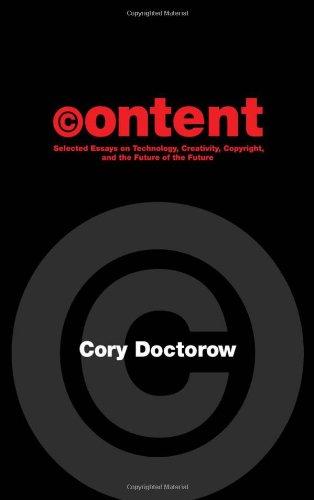
Content: Selected Essays on Technology, Creativity, Copyright, and the Future of the Future
by
Cory Doctorow
Published 15 Sep 2008
Conscientious folks getting over a cold? Oh, yes, he said, yes, of course, but that's only the rubric. The real reason to wear the mask is to spare others the discomfort of seeing your facial expression, to make your face into a disengaged, unreadable blank—to spare others the discomfort of firing up their mirror neurons in order to model your mood based on your outward expression. To make it possible to see without seeing. There is one city dweller that doesn't respect this delicate social contract: the closed-circuit television camera. Ubiquitous and demanding, CCTVs don't have any visible owners. They ... occur.

Exit Strategy
by
Sherry Walling, Rob Walling
Published 22 Nov 2024
.” — Eran Galperin Your Family Your family may suffer as your level of distraction and lack of attention takes a significant toll on your bond. You might miss some T-ball games or find yourself zoning out while your brother is telling you about his new girlfriend. Your family might be affected in subconscious ways as well. Emotions are contagious on a neurobiological level. Mirror neurons in our brains fire in response to the emotions and actions of others,5 which is why it’s nearly impossible not to yawn when you see someone else do so. Stress is no exception. When you’re stressed, it’s nearly impossible to biologically hide it. Your body will give you away. Your heart rate elevates.

Think Like an Engineer: Use Systematic Thinking to Solve Everyday Challenges & Unlock the Inherent Values in Them
by
Mushtak Al-Atabi
Published 26 Aug 2014
Italian researchers discovered certain neurons in the brain that are activated not only when we go through an experience but also when we see someone going through a similar experience. That is why, for example, if we see someone accidentally hitting her finger with a hammer, we almost feel the pain in our own fingers. These neurons are now dubbed “mirror neurons.” Empathy is a very powerful tool and those who cultivate it can be good team players. Empathy is very necessary for professional success as well. Engineers and designers, for example, need to develop empathy with the end users of their products so that they can develop human-centric designs.
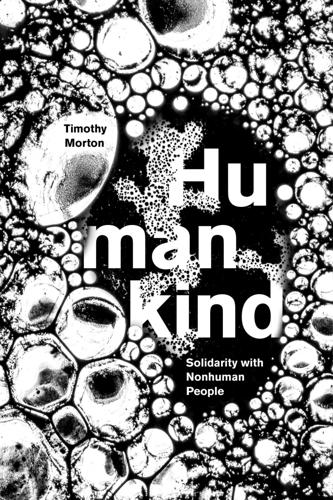
Humankind: Solidarity With Non-Human People
by
Timothy Morton
Published 14 Oct 2017
Religion melted in mid 1700s Europe and the “paranormal” leaked out; thinkers became fascinated, often trying to contain it or bowdlerize it. The historical sequence, then, is from animal magnetism to hypnotism to psychoanalytic transference. By the start of the twenty-first century, we arrive at mirror neurons. Thank god, there are extension lumps in that direction, too. Scientism breathes a sigh of relief, and so does correlationism. No need to worry about sounding like Yoda. Kantian beauty is found in this anxious region. It’s a bowdlerized version of telepathy or telekinesis, something like agency or liveliness emanating from something like an inanimate being, a painting or a piece of music.

The Human Swarm: How Our Societies Arise, Thrive, and Fall
by
Mark W. Moffett
Published 31 Mar 2019
People across bands reaffirmed their unity through feasting, stories, songs, and dances.18 The pleasure of carrying out these activities, and of ceding one’s individuality to the group, may spring from an impulse to act as we think we must to be accepted. This is seen in how we mirror not just the vocal tics and gestures but the emotions of those we respect, which we tend to do most with those of our race or ethnicity.19 These actions are unintentional, induced in part by mirror neurons in the premotor cortex that fire whether we engage in an action or watch another carry that action out.20 The behavior has genetic underpinnings: newborns imitate the sadness, fear, or surprise of others.21 Mirroring others, and emotional responses at a group level, spring up in other animals, too, like the excited monkey troop.
…
On the Borders of Love and Power: Families and Kinship in the Intercultural American Southwest. Berkeley: University of California Press. pp. 47–70. Riveros AJ, MA Seid, WT Wcislo. 2012. Evolution of brain size in class-based societies of fungus-growing ants. Anim Behav 83:1043–1049. Rizzolatti G, L Craighero. 2004. The mirror-neuron system. Annu Rev Neurosci 27:169–192. Roberts SGB. 2010. Constraints on social networks. In RIM Dunbar, C Gamble, J Gowlett, eds. Social Brain, Distributed Mind. Oxford: Oxford University Press. pp. 115–134. Robinson WP, H Tajfel. 1996. Social Groups and Identities: Developing the Legacy of Henri Tajfel.

Choose Yourself!
by
James Altucher
Published 14 Sep 2013
I’m scared and somewhat introverted. Stand-up comedians are the best public speakers in the world and quite frequently, the most astute social commentators on the human condition. So I watch them before most social encounters— personal, professional, media— because it gives me a boost of energy. My “mirror neurons” are going to feed off of their boost of energy for at least one to three hours after I watch them. It gives me material. I won’t steal from a comedian (yes I will). And at the very least, I often improvise based on material I heard a comedian said. I’m not competing with them. I’m just on a date.

Skin in the Game: Hidden Asymmetries in Daily Life
by
Nassim Nicholas Taleb
Published 20 Feb 2018
fn3 See Silent Risk, 157–161, http://www.fooledbyrandomness.com/SilentRisk.pdf. fn4 Actually, I usually joke that my death plus someone I don’t like surviving, such as the journalistic professor Steven Pinker, is worse than just my death. fn5 To show the inanity of social science, they have to muster up the sensationalism of “mirror neurons” to explain the link between the individual and the collective. Relying on neuro-something is a form of scientism called “brain porn,” discussed in Antifragile. TECHNICAL APPENDIX fn1 Debate of author with P. Jorion, 1997, and Taleb 2007. fn2 Thanks to questioning by Andrew Lesniewski, who helped define what we mean by ergodicity, as the meaning here diverges from that in statistical physics.
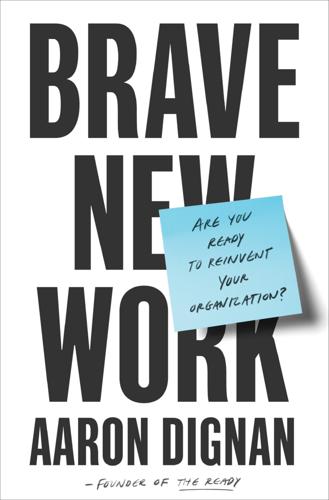
Brave New Work: Are You Ready to Reinvent Your Organization?
by
Aaron Dignan
Published 1 Feb 2019
Teams leave the Braintrust with a renewed clarity about their film, one way or another, determined to unearth the greatness within. Like it or not, great meetings offer higher bandwidth—more information per second—than any other form of communication. When we’re together, we not only hear one another but also see and sense body language, emotion, and energy. Our mirror neurons start firing. We can shake hands. We can breathe the same air. We can stand shoulder to shoulder. Even organizations such as Automattic (the creators of WordPress), GitLab, and Basecamp, which are famous for working remotely, host regular gatherings of their global membership. A million years of evolution didn’t evaporate because someone invented the videoconference.

Stealing Fire: How Silicon Valley, the Navy SEALs, and Maverick Scientists Are Revolutionizing the Way We Live and Work
by
Steven Kotler
and
Jamie Wheal
Published 21 Feb 2017
Out of the rest of more traditional film and TV, you can make the case that with the exception of documentaries (where we might actually be trying to learn something), virtually all visual storytelling serves to provide an escape. And there’s a reason for this. Our brains do a pretty crummy job of distinguishing the physical from the filmed. For 99.9 percent of human evolution, if we saw something with our eyes, that meant it was in our physical world. The brain regions for fear, love, and movement, along with our mirror neurons, spike our ability to imagine ourselves right up there with our screen heroes. The effect is, quite literally, intoxicating. But again we wanted to err on the side of conservative. So we limited our accounting to two categories of screen viewing that are especially and purposely escapist: IMAX/3D films (where the record-setting film Avatar serves as the exemplar) and binge watching of streaming shows (where Netflix’s House of Cards practically invented the term).

Possible Minds: Twenty-Five Ways of Looking at AI
by
John Brockman
Published 19 Feb 2019
Gross and S. Simmons (Baltimore: Johns Hopkins University Press, 2014). * Steven Pinker, “Safety,” Enlightenment Now: The Case for Reason, Science, Humanism, and Progress (New York: Penguin, 2018). * “Aping” (imitating certain behaviors without understanding) uses inborn hacks such as the mirror-neuron system. But behaviors imitated that way are drastically limited in complexity. See Richard Byrne, “Imitation as Behaviour Parsing,” Philosophical Transactions of the Royal Society B 358, no. 1431 (2003): 529–36. * Karl Popper, Conjectures and Refutations (Abingdon, UK: Routledge, 1963)

Upgrade
by
Blake Crouch
Published 6 Jul 2022
Because you think it’s right?” “Right and wrong are constructs born of human sentiment. Nothing but stories we’ve made up and assigned meaning to. They don’t correspond to any objective reality. The only thing real is survival.” I said, “Maybe compassion and empathy are just squishy emotions. Illusions created by our mirror neurons. But does it really matter where they come from? They make us human. They might even be what make us worth saving.” “Come on, Logan. Enough with the abstractions. Maybe you didn’t believe our time was up back in New Mexico, but you do now. And you know we can’t just let it happen.” Kara raised her wineglass.

Rationality: From AI to Zombies
by
Eliezer Yudkowsky
Published 11 Mar 2015
If you intuit that (C,C) trumps (D,D) from Player 1’s perspective, but don’t intuit that (D,C) also trumps (C,C), you haven’t yet appreciated what makes this problem difficult. * 1. Eliezer Yudkowsky, Timeless Decision Theory, Unpublished manuscript (Machine Intelligence Research Institute, Berkeley, CA, 2010), http://intelligence.org/files/TDT.pdf. 276 Sympathetic Minds “Mirror neurons” are neurons that are active both when performing an action and observing the same action—for example, a neuron that fires when you hold up a finger or see someone else holding up a finger. Such neurons have been directly recorded in primates, and consistent neuroimaging evidence has been found for humans.
…
Either way . . . it’s painful if you’re a bystander in a war between two sides, and your sympathy has not been switched off for either side, so that you wince when you see a dead child no matter what the caption on the photo; and yet those two sides have no sympathy for each other, and they go on killing. So that is the human idiom of sympathy—a strange, complex, deep implementation of reciprocity and helping. It tangles minds together—not by a term in the utility function for some other mind’s “desire,” but by the simpler and yet far more consequential path of mirror neurons: feeling what the other mind feels, and seeking similar states. Even if it’s only done by observation and inference, and not by direct transmission of neural information as yet. Empathy is a human way of predicting other minds. It is not the only possible way. The human brain is not quickly rewirable; if you’re suddenly put into a dark room, you can’t rewire the visual cortex as auditory cortex, so as to better process sounds, until you leave, and then suddenly shift all the neurons back to being visual cortex again.
…
Shut down vision and devote all those operations to sound; swap the old program to disk to free up the RAM, then swap the disk back in again when the lights go on. So why would an AI need to force its own mind into a state similar to what it wanted to predict? Just create a separate mind-instance—maybe with different algorithms, the better to simulate that very dissimilar human. Don’t try to mix up the data with your own mind-state; don’t use mirror neurons. Think of all the risk and mess that implies! An expected utility maximizer—especially one that does understand intelligence on an abstract level—has other options than empathy, when it comes to understanding other minds. The agent doesn’t need to put itself in anyone else’s shoes; it can just model the other mind directly.

Wired for War: The Robotics Revolution and Conflict in the 21st Century
by
P. W. Singer
Published 1 Jan 2010
Humans have a natural inclination to “anthropomorphize,” to give human characteristics to something that is not human. Indeed, we are hardwired that way. In our brains are clusters of nerve cells called mirror neurons. These neurons fire when we recognize the object we are looking at as alive and deserving of empathy; that is, what we “mirror” ourselves onto. When scientists at the University of California-San Diego studied the brain scans of people looking at a robot, they found that their mirror neurons were firing. That is, the people had much the same brain activity that they would have as if they were interacting with a real person, even though the rest of their brain knew that it was just a machine.
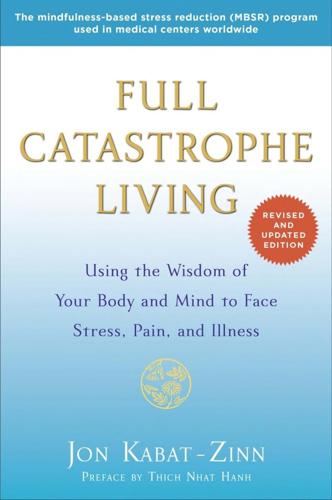
Full Catastrophe Living (Revised Edition): Using the Wisdom of Your Body and Mind to Face Stress, Pain, and Illness
by
Jon Kabat-Zinn
Published 23 Sep 2013
At each level of our being there is a wholeness that is itself embedded in a larger wholeness. And that wholeness is always embodied. It cannot be separated from the body and from an exquisite and intimate belonging to the larger expression of life unfolding. This can be seen in the discovery of what are called “mirror neurons,” networks of cells in the brain that fire in us when we see someone else engaged in a particular intentional action. These mirror neurons may underlie our biological capacity for empathy, for “feeling with” another individual. This web of interconnectedness extends well beyond our individual psychological self. While we are whole ourselves as individual beings, we are also part of a larger whole, interconnected through our family and our friends and acquaintances to the larger society and, ultimately, to the whole of humanity and life on the planet.
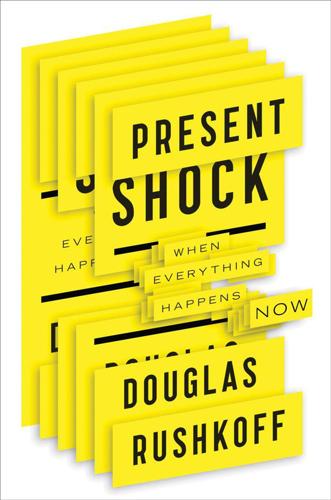
Present Shock: When Everything Happens Now
by
Douglas Rushkoff
Published 21 Mar 2013
In the real world, 94 percent of our communication occurs nonverbally.37 Our gestures, tone of voice, facial expressions, and even the size of our irises at any given moment tell the other person much more than our words do. These are the cues we use to gauge whether someone is listening to us, agrees with us, is attracted to us, or wants us to shut up. When a person’s head nods and his irises dilate, we know—even just subconsciously—that he agrees with us. This activates the mirror neurons in our brains, feeding us a bit of positive reinforcement, releasing a bit of dopamine, and leading us further down that line of thought. Without such organic cues, we try to rely on the re-Tweets and likes we get—even though we have not evolved over hundreds of millennia to respond to those symbols the same way.

The Rapture of the Nerds
by
Cory Doctorow
and
Charles Stross
Published 3 Sep 2012
I know that it’s inevitable that I’d feel like I was a person, but I find that I feel the same way about you, and all those other jumped-up Perl scripts and regexps mincing about in their pornographic nonstop MMORPGs, pretending that they aren’t NPCs. It’s like feeling compassion for a socket wrench or kinship to a novel. It shouldn’t make sense, but it does.” “You’ve grown,” his father-thing says with a shrug. “Your mirror neurons have discovered compassion. I can’t say as I find much cause for mourning in that.” “No. No, no, no. Look, you’ve messed with my personality, you’ve got my headmeat all buggered up, turned me into some sort of navel-gazing, soft-headed beardie-weirdy. You’ve taken all my core convictions away, and you’ve replaced them with some kind of Buddha-script, and you tell me it’s just growth?
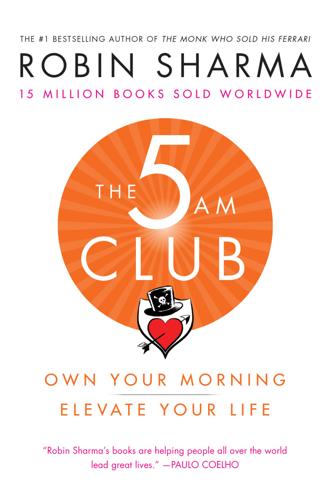
The 5 AM Club: Own Your Morning. Elevate Your Life.
by
Robin Sharma
Published 4 Dec 2018
I was once on a business trip in Barbados, where a taxi driver gave me this piece of wisdom, which has served me very well. ‘Avoid bad people.’” The eye had this letter stuck to it: The Billionaire’s Maxim #5 Avoid Bad People. Never underestimate the power of your associations. By the phenomenon known as “emotional contagion” as well as through the activation of the mirror neurons in our brains, we model the behavior of the people we spend our days with. Fill your life with exceptionally excellent, enterprising, healthy, positive, ethical and sincerely loving people. And over time, you’ll exemplify these lofty traits. Allow dream stealers, energy thieves and enthusiasm bandits into your Tight Bubble of Total Focus and please know you’re sure to become like them.

The Nocturnal Brain: Nightmares, Neuroscience, and the Secret World of Sleep
by
Dr. Guy Leschziner
Published 22 Jul 2019
Nobili, L., Proserpio, P., Combi, R., Provini, F., Plazzi, G., Bisulli, F., Tassi, L., Tinuper, P., ‘Nocturnal frontal lobe epilepsy’, Curr Neurol Neurosci Rep, February 2014, 14(2): 424. Chapter 9: Floating Eyeballs Jalal, B., Ramachandran, V. S., ‘Sleep Paralysis, “The Ghostly Bedroom Intruder” and Out-of-Body Experiences: The Role of Mirror Neurons’, Front Hum Neurosci, 28 February 2017, 11: 92. Jalal, B., Ramachandran, V. S., ‘Sleep paralysis and “the bedroom intruder”: the role of the right superior parietal, phantom pain and body image projection’, Med Hypotheses, December 2014, 83(6): 755—7. Denis, D., French, C. C., Gregory, A. M., ‘A systematic review of variables associated with sleep paralysis’, Sleep Med Rev, April 2018, 38: 141–57.

The Sirens' Call: How Attention Became the World's Most Endangered Resource
by
Chris Hayes
Published 28 Jan 2025
BACK TO NOTE REFERENCE 24 See, e.g., Nancy Kanwisher and Galit Yovel, “The Fusiform Face Area: A Cortical Region Specialized for the Perception of Faces,” Philosophical Transactions of the Royal Society B 361, no. 1476 (2006): 2109–28. BACK TO NOTE REFERENCE 25 See, e.g., Marco Iacoboni et al., “Grasping the Intentions of Others with One’s Own Mirror Neuron System,” PLoS Biology 3, no. 3 (2005): e79. BACK TO NOTE REFERENCE 26 Kate Schweitzer, “Tina Fey Perfectly Explains How ‘Having a Teenage Daughter Is Like Having an Office Crush,’ ” PopSugar, May 24, 2021, accessed February 26, 2024, www.popsugar.com/family/tina-fey-compares-having-teenage-daughter-to-office-crush-48337557.

The Human Age: The World Shaped by Us
by
Diane Ackerman
Published 9 Sep 2014
Such robots have already passed the stage of being a mere sensation in the robotics world. Fully-featured human faces are smiling, grimacing, exchanging knowing looks the world over. Unlike Madame Tussaud’s wax-museum stars, today’s robots look lifelike enough to seem a bit creepy, with facial expressions that actually elicit empathy and make your mirror neurons quiver. Equally realistic squishy bodies aren’t far behind. One can easily imagine the day, famously foretold in the movies Blade Runner and Alien, when computers with faces feel silicon flavors of paranoia, love, melancholy, anger, and the other stirrings of our carbon hearts. Then the already lively debate about whether machines are conscious will really heat up.

The Constitution of Knowledge: A Defense of Truth
by
Jonathan Rauch
Published 21 Jun 2021
People, he argued, come into the world equipped with what he called sympathy, or fellow-feeling; “empathy” is the word we might use today.3 We have a natural inclination to imagine how others see and feel, and to align our own perspectives and dispositions with theirs. (Modern neurology bears out Smith’s claim: humans and other primates seem to possess systems of so-called mirror neurons, which help us intuit others’ feelings and imitate their behaviors.) Also, humans come equipped with a desire to be trusted and respected by others. Through our desire for mutual esteem based on our empathetic intuitions, we can align our interests and form social bonds on a basis other than force or domination.

In Our Own Image: Savior or Destroyer? The History and Future of Artificial Intelligence
by
George Zarkadakis
Published 7 Mar 2016
Saygin and her team performed an experiment during which the brains of twenty subjects aged twenty to thirty-six were scanned while they looked at three different scenarios: a human, a mechanical looking robot, and a human-like robot.11 Interpreting the results from the fMRI scans, the researchers suggested that the cause for the uncanny valley lies in a mismatch between at least two neural pathways, that of recognising a human-like face and that of recognising a robotic movement. Both these pathways interconnect in the parietal cortex of the brain. There, information from the visual cortex relating to bodily movement is integrated with information from the motor cortex that contains mirror neurons, the neurons that qualify if what we see is one of us. Alarm bells go off in the brain when there is a perceptual conflict between the human-like features of the robot and its mechanical movement. This mismatch creates a feeling of revulsion, similar to what we feel when looking at a ‘zombie’.

Why We Drive: Toward a Philosophy of the Open Road
by
Matthew B. Crawford
Published 8 Jun 2020
In other words, anger can be distorting of one’s thinking, yes, but it also arises from, and spurs, thinking. 7.Andy Clark, Surfing Uncertainty: Prediction, Action and the Embodied Mind (New York: Oxford University Press, 2014). 8.These suggestions by Clark provide an evolutionary rationale for “the development and deployment of ‘mirror neurons’ and (more generally) ‘mirror systems’: neural resources implicated both in the performance of actions and in the observation of the ‘same’ actions when performed by others.” Clark, Surfing Uncertainty, pp. 139–140. 9.Clark, Surfing Uncertainty, p. 285. 10.Clark, Surfing Uncertainty, p. 73. 11.These last remarks are my extrapolation from a remark by Clark (Surfing Uncertainty, p. 286), citing the work of M.

Why Machines Learn: The Elegant Math Behind Modern AI
by
Anil Ananthaswamy
Published 15 Jul 2024
GO TO NOTE REFERENCE IN TEXT The article was titled: Frank Rosenblatt, “The Design of an Intelligent Automaton,” Research Trends VI, No. 2 (Summer 1958): 1–7. GO TO NOTE REFERENCE IN TEXT Hebb had proposed a mechanism: Christian Keysers and Valeria Gazzola, “Hebbian Learning and Predictive Mirror Neurons for Actions, Sensations and Emotions,” Philosophical Transactions of the Royal Society B, 369, No. 1644 (June 2014): 20130175. GO TO NOTE REFERENCE IN TEXT The process is called Hebbian learning: Simon Haykin, Neural Networks and Learning Machines, 3rd ed. (New York: Pearson Prentice Hall, 2009), p. 368.

What to Think About Machines That Think: Today's Leading Thinkers on the Age of Machine Intelligence
by
John Brockman
Published 5 Oct 2015
HE WHO PAYS THE AI CALLS THE TUNE ROSS ANDERSON Professor of security engineering, Computer Laboratory, University of Cambridge; author, Security Engineering The coming shock isn’t from machines that think but machines that use AI to augment our perception. For millions of years, other people saw us using the same machinery we used to see them. We have pretty much the same eyes as our rivals, and pretty much the same mirror neurons. Within any given culture, we have pretty much the same signaling mechanisms and value systems. So when we try to deceive or detect deception in others, we’re on a level playing field. I can wear a big penis gourd to look more manly, and you can paint your chest with white and ochre mud stripes to look more scary.
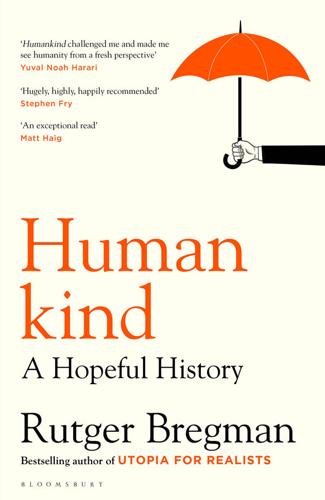
Humankind: A Hopeful History
by
Rutger Bregman
Published 1 Jun 2020
Silverman, ‘The “Monster” Study’, Journal of Fluency Disorders, Vol. 13, Issue 3 (1988). 8John C. Edwards, William McKinley and Gyewan Moon, ‘The enactment of organizational decline: The self-fulfilling prophecy’, International Journal of Organizational Analysis, Vol. 10, Issue 1 (2002). 9Daisy Yuhas, ‘Mirror Neurons Can Reflect Hatred’, Scientific American (1 March 2013). 10John Maynard Keynes, The General Theory of Employment, Interest, and Money (London, 1936), Chapter 12. 11Dan Ariely, ‘Pluralistic Ignorance’, YouTube (16 February 2011). 12Pinker, The Better Angels of Our Nature (2011), pp. 561–5. 13 The Power of Intrinsic Motivation 1Hedwig Wiebes, ‘Jos de Blok (Buurtzorg): “Ik neem nooit zomaar een dag vrij”,’ Intermediair (21 October 2015). 2Ibid. 3Ibid. 4Haico Meijerink, ‘Buurtzorg: “Wij doen niet aan strategische flauwekul”,’ Management Scope (8 October 2014). 5Gardiner Morse, ‘Why We Misread Motives’, Harvard Business Review (January 2003). 6Quoted in ibid. 7Frederick Taylor, The Principles of Scientific Management (New York, 1911), Chapter 2, p. 59. 8Quoted in Robert Kanigel, The One Best Way.

Democracy and Prosperity: Reinventing Capitalism Through a Turbulent Century
by
Torben Iversen
and
David Soskice
Published 5 Feb 2019
Huo, Jingjing. 2009. Third Way Reforms: Social Democracy after the Golden Age. Cambridge, UK: Cambridge University Press. Iacoboni, Marco, Istvan Molnar-Szakacs, Vittorio Gallese, Giovanni Buccino, John C. Mazziotta, Giacomo Rizzolatti. 2005. “Grasping the Intentions of Others with One’s Own Mirror Neuron System.” PLOS Biology 3 (3): 529–35. Iammarino, Simona, and Philip McCann. 2013. Multinationals and Economic Geography: Location, Technology, and Innovation. Cheltenham, UK: Edward Elgar. Ibsen, Christian Lyhne, and Kathleen Thelen. Forthcoming. “Diverging Solidarity Labor Strategies in the New Knowledge Economy.”
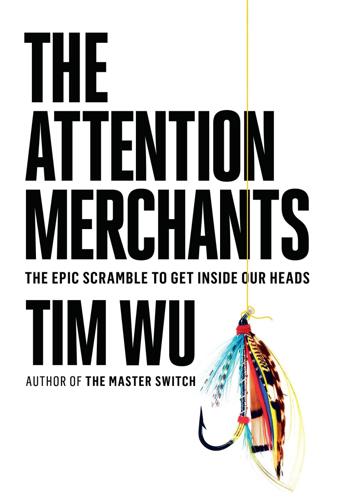
The Attention Merchants: The Epic Scramble to Get Inside Our Heads
by
Tim Wu
Published 14 May 2016
“Love and hate, gratitude and envy, hope and fear, pity and jealousy, repentance and sinfulness, and all the similar crude emotions…help greatly to excite and to intensify the personal feeling of life and to stir the depths of the human mind.”2 A neuroscientist might say that cinema had always shown the ability to activate our mirror neurons, the brain cells known to light up identically whether we observe someone perform an act or do it ourselves.3 It happens, too, when an image is close enough to reality to make our brain identify with what it sees. Perhaps this partly explains why, even by contemporary standards, television was adopted quickly.

AI 2041: Ten Visions for Our Future
by
Kai-Fu Lee
and
Qiufan Chen
Published 13 Sep 2021
He had been something of a star in his field, and everyone had wondered if he’d be the one to make a breakthrough in quantum computing. Xavier soon decided to start his investigation at Rousseau’s research institute in Germany. There was something in this grieving physicist’s eyes that triggered Xavier’s mirror neurons. He would have to go to Munich. MUNICH, GERMANY SEPTEMBER 11, 2041 10:02 LOCAL TIME The Max Planck Institute didn’t look as futuristic as Xavier had imagined. The gray-yellow building had clean Bauhaus contours, common on the streets of Munich. When he passed the bronze statue of Planck in the hall, Xavier lingered, surprised by its proximity to a statue of Saint Barbara.

Like, Comment, Subscribe: Inside YouTube's Chaotic Rise to World Domination
by
Mark Bergen
Published 5 Sep 2022
The company didn’t share exactly what videos were there, but Tubefilter, a web magazine, did some sleuthing to find a list, which included Mother Goose Club and DisneyCollectorBR, queen of the faceless ones. On the Today show a father with obsessed offspring called DisneyCollectorBR unboxing videos “crack for toddlers.” Some suspected dopamine or mirror neurons at play—cells that fire off when we perform a task with a clear goal or see someone do it. Find out what’s in that surprise egg! Did kids watch these compulsively out of genuine interest or because YouTube teed them up one after the other? The phenomenon was still too new to study properly, and the company shared virtually no data with outside researchers.

The Musical Human: A History of Life on Earth
by
Michael Spitzer
Published 31 Mar 2021
It exercises a regime of prayer in the way it listens. As I sit and fight the temptation to move – the urge to move to music is as irresistible as blinking – I imaginatively reconstruct these gestures in my head. EEG (electroencephalography, a technique of reading the brain’s electrical activity) has shown that listening to music fires the same mirror neurons in our brain that are associated with motor activity.96 Because we can’t move, the focus of our attention is the person who stands in front of the orchestra doing a little dance, the conductor. Melodramatic and fanciful though the conductor’s gestures can sometimes seem, they are a vital proxy for our repressed actions.

Deep Nutrition: Why Your Genes Need Traditional Food
by
Catherine Shanahan M. D.
Published 2 Jan 2017
Risk of autism spectrum disorders in children born after assisted conception: a population-based follow-up study, Hvidtjørn D, Grove J, Schendel D, Schieve LA, Sværke C, Ernst E, Thorsen P, J Epidemiol Community Health, June 2011, 65(6):497-502. 406. Perinatal factors and the development of autism: a population study, Arch Gen Psychiatry, June 2004, 61(6):618-27. 407. Out of time: a possible link between mirror neurons, autism and electromagnetic radiation, Thornton IM, Med Hypotheses, 2006, 67(2):378-82. 408. Polybrominated diphenyl ether (PBDE) flame retardants as potential autism risk factors (review), Messer A, Physiol Behav, June 1,2010, 100(3):245-9, doi 10.1016/j.physbeh.2010.01.011, epub January 2010. 409.
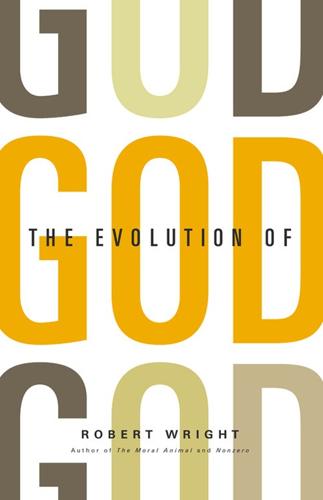
The Evolution of God
by
Robert Wright
Published 8 Jun 2009
Long before history, and long before human beings, animals felt something like love for kin. And it’s a pretty good bet that when animals first felt love is when they were first able to in any sense identify with the subjective interior of another animal. To put this point in physiological language: love probably sponsored the first “mirror neurons,” a likely biological basis of the moral imagination and thus an essential element in the moral order’s infrastructure. There’s an even deeper association between love and the moral order. The expanding moral compass sponsored by the moral order, as we’ve seen, is a manifestation of non-zero-sumness, of the fact that cultural (and in particular technological) evolution leads more and more people to play non-zero-sum games at greater and greater distances.